Relationship between Proper Capital Structure and Financial Sustainability of a company
VerifiedAdded on 2023/06/10
|60
|11660
|239
AI Summary
This paper explores the relationship between capital structure and financial sustainability of a company. It highlights the importance of proper capital structure and its impact on financial sustainability. The paper includes an introduction, literature review, research methodology, data analysis, and conclusion. The research aims to determine how companies can ensure financial sustainability through the incorporation of the capital structure. The objectives include mitigating insolvency risk and determining the ideal debt to equity ratio. The literature review covers the pecking order theory and the importance of retained earnings and debt financing.
Contribute Materials
Your contribution can guide someone’s learning journey. Share your
documents today.
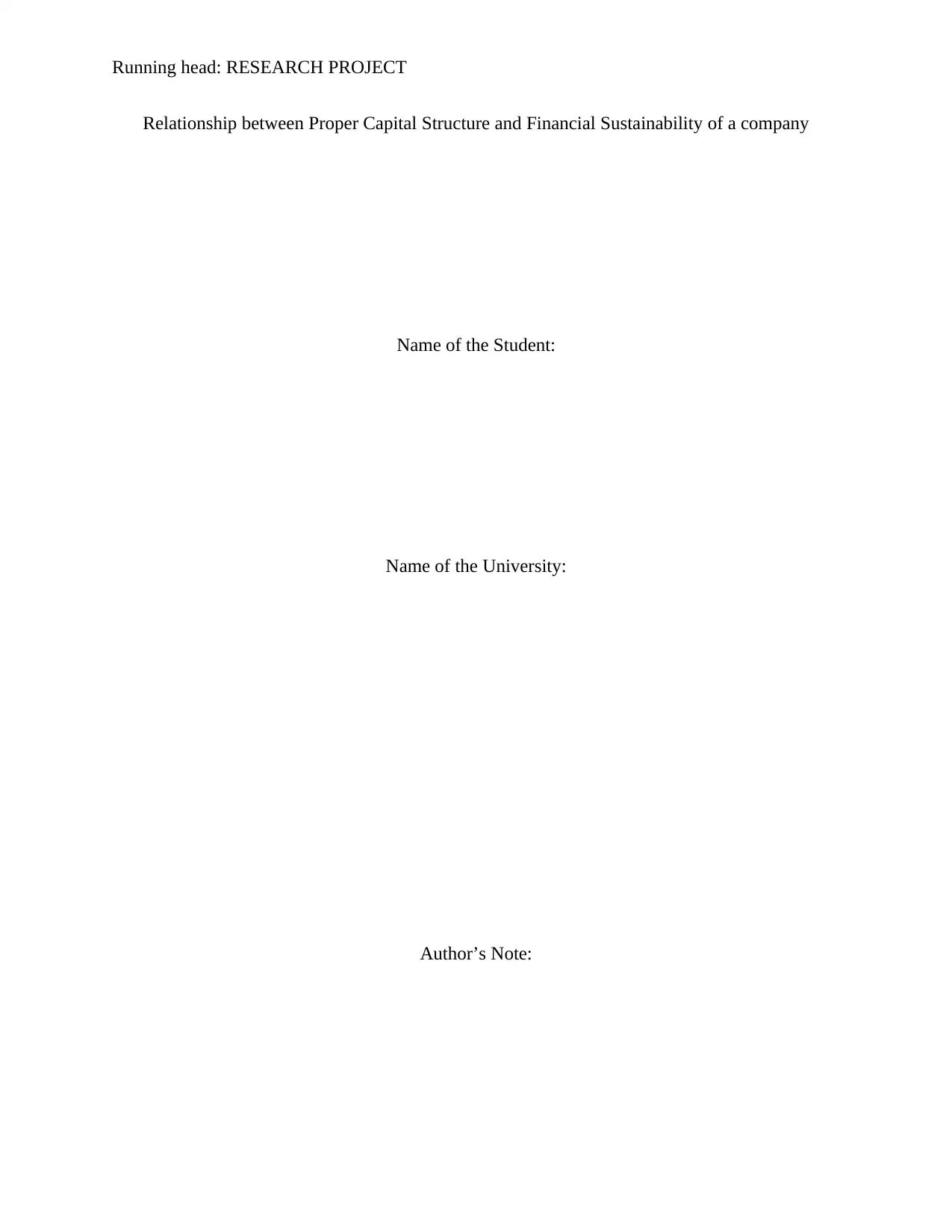
Running head: RESEARCH PROJECT
Relationship between Proper Capital Structure and Financial Sustainability of a company
Name of the Student:
Name of the University:
Author’s Note:
Relationship between Proper Capital Structure and Financial Sustainability of a company
Name of the Student:
Name of the University:
Author’s Note:
Secure Best Marks with AI Grader
Need help grading? Try our AI Grader for instant feedback on your assignments.
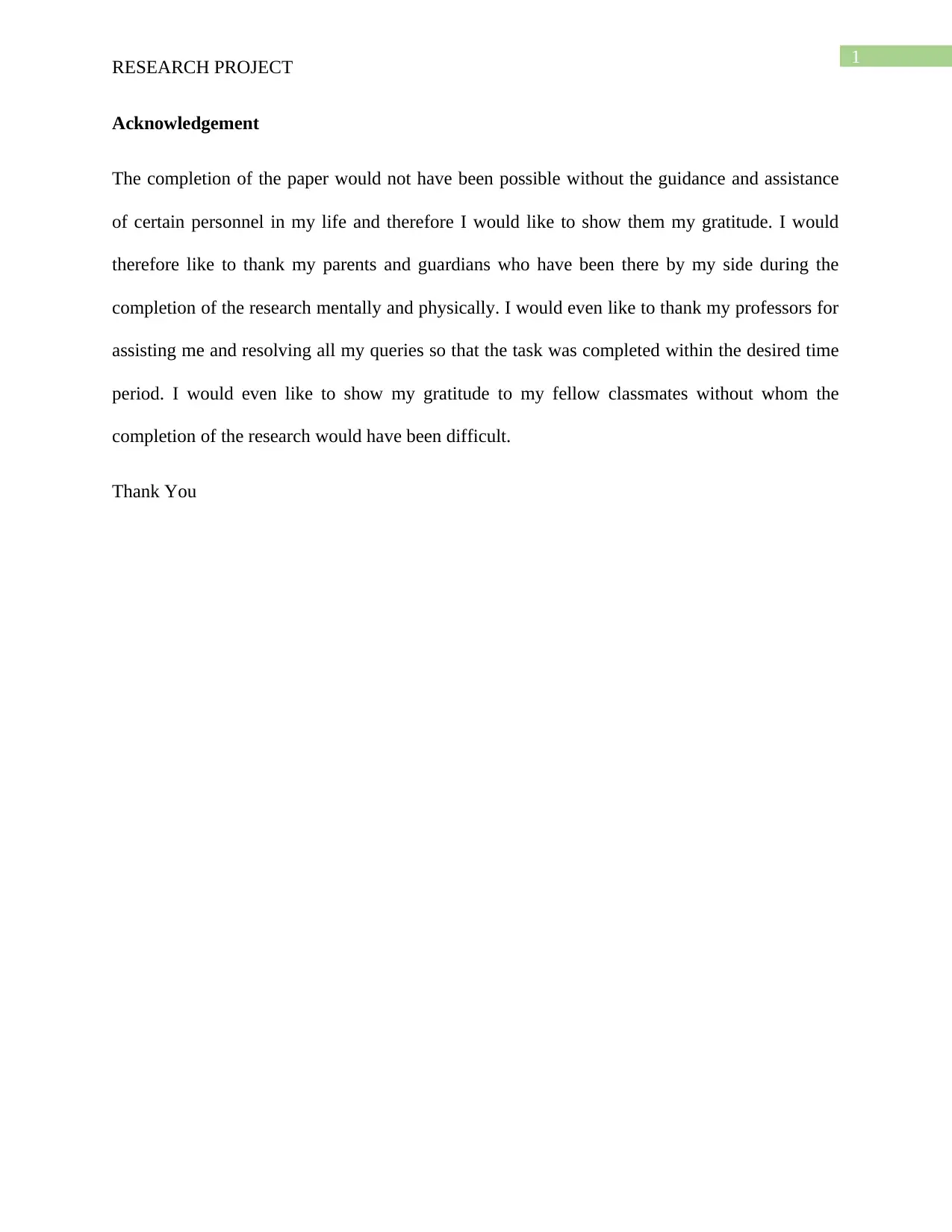
1
RESEARCH PROJECT
Acknowledgement
The completion of the paper would not have been possible without the guidance and assistance
of certain personnel in my life and therefore I would like to show them my gratitude. I would
therefore like to thank my parents and guardians who have been there by my side during the
completion of the research mentally and physically. I would even like to thank my professors for
assisting me and resolving all my queries so that the task was completed within the desired time
period. I would even like to show my gratitude to my fellow classmates without whom the
completion of the research would have been difficult.
Thank You
RESEARCH PROJECT
Acknowledgement
The completion of the paper would not have been possible without the guidance and assistance
of certain personnel in my life and therefore I would like to show them my gratitude. I would
therefore like to thank my parents and guardians who have been there by my side during the
completion of the research mentally and physically. I would even like to thank my professors for
assisting me and resolving all my queries so that the task was completed within the desired time
period. I would even like to show my gratitude to my fellow classmates without whom the
completion of the research would have been difficult.
Thank You
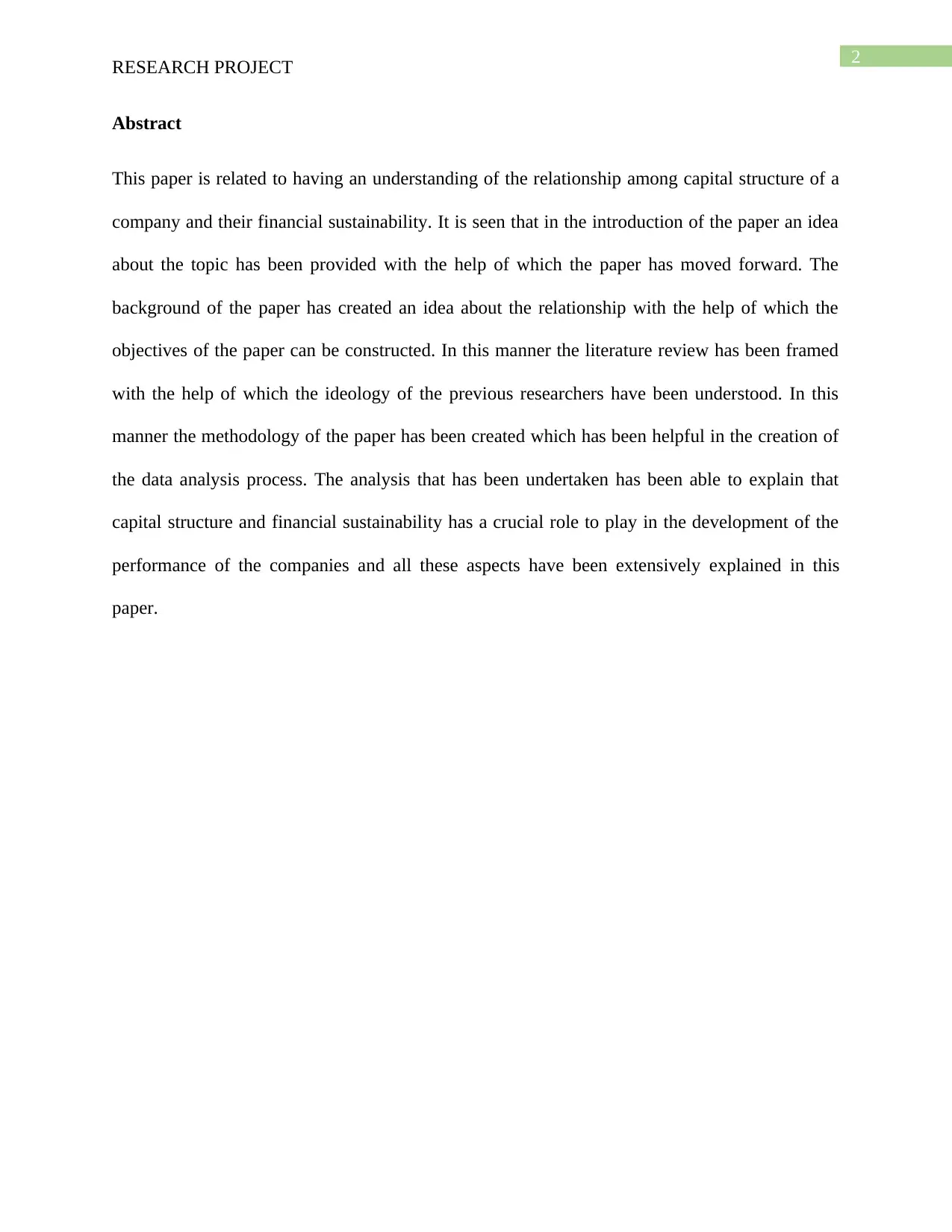
2
RESEARCH PROJECT
Abstract
This paper is related to having an understanding of the relationship among capital structure of a
company and their financial sustainability. It is seen that in the introduction of the paper an idea
about the topic has been provided with the help of which the paper has moved forward. The
background of the paper has created an idea about the relationship with the help of which the
objectives of the paper can be constructed. In this manner the literature review has been framed
with the help of which the ideology of the previous researchers have been understood. In this
manner the methodology of the paper has been created which has been helpful in the creation of
the data analysis process. The analysis that has been undertaken has been able to explain that
capital structure and financial sustainability has a crucial role to play in the development of the
performance of the companies and all these aspects have been extensively explained in this
paper.
RESEARCH PROJECT
Abstract
This paper is related to having an understanding of the relationship among capital structure of a
company and their financial sustainability. It is seen that in the introduction of the paper an idea
about the topic has been provided with the help of which the paper has moved forward. The
background of the paper has created an idea about the relationship with the help of which the
objectives of the paper can be constructed. In this manner the literature review has been framed
with the help of which the ideology of the previous researchers have been understood. In this
manner the methodology of the paper has been created which has been helpful in the creation of
the data analysis process. The analysis that has been undertaken has been able to explain that
capital structure and financial sustainability has a crucial role to play in the development of the
performance of the companies and all these aspects have been extensively explained in this
paper.
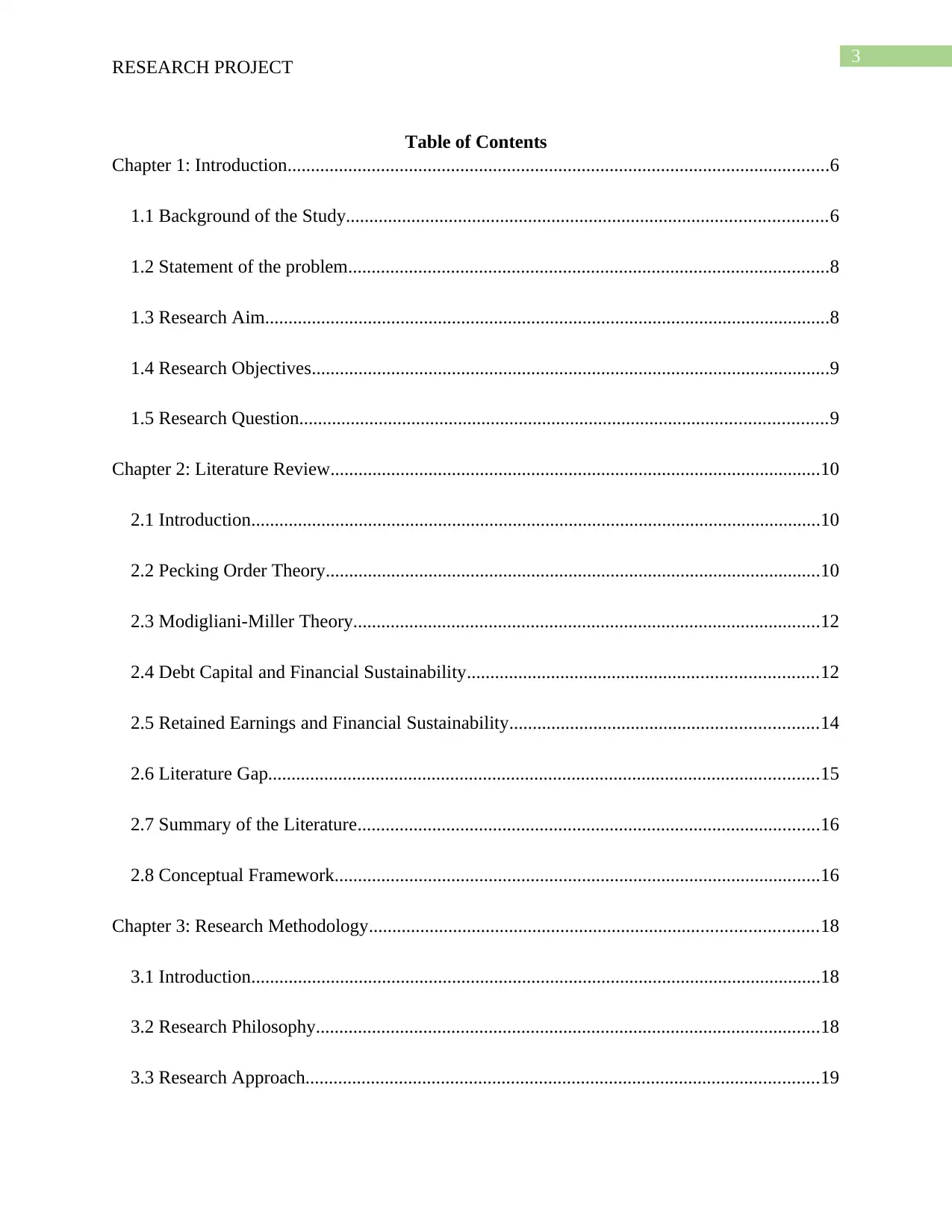
3
RESEARCH PROJECT
Table of Contents
Chapter 1: Introduction....................................................................................................................6
1.1 Background of the Study.......................................................................................................6
1.2 Statement of the problem.......................................................................................................8
1.3 Research Aim.........................................................................................................................8
1.4 Research Objectives...............................................................................................................9
1.5 Research Question.................................................................................................................9
Chapter 2: Literature Review.........................................................................................................10
2.1 Introduction..........................................................................................................................10
2.2 Pecking Order Theory..........................................................................................................10
2.3 Modigliani-Miller Theory....................................................................................................12
2.4 Debt Capital and Financial Sustainability...........................................................................12
2.5 Retained Earnings and Financial Sustainability..................................................................14
2.6 Literature Gap......................................................................................................................15
2.7 Summary of the Literature...................................................................................................16
2.8 Conceptual Framework........................................................................................................16
Chapter 3: Research Methodology................................................................................................18
3.1 Introduction..........................................................................................................................18
3.2 Research Philosophy............................................................................................................18
3.3 Research Approach..............................................................................................................19
RESEARCH PROJECT
Table of Contents
Chapter 1: Introduction....................................................................................................................6
1.1 Background of the Study.......................................................................................................6
1.2 Statement of the problem.......................................................................................................8
1.3 Research Aim.........................................................................................................................8
1.4 Research Objectives...............................................................................................................9
1.5 Research Question.................................................................................................................9
Chapter 2: Literature Review.........................................................................................................10
2.1 Introduction..........................................................................................................................10
2.2 Pecking Order Theory..........................................................................................................10
2.3 Modigliani-Miller Theory....................................................................................................12
2.4 Debt Capital and Financial Sustainability...........................................................................12
2.5 Retained Earnings and Financial Sustainability..................................................................14
2.6 Literature Gap......................................................................................................................15
2.7 Summary of the Literature...................................................................................................16
2.8 Conceptual Framework........................................................................................................16
Chapter 3: Research Methodology................................................................................................18
3.1 Introduction..........................................................................................................................18
3.2 Research Philosophy............................................................................................................18
3.3 Research Approach..............................................................................................................19
Secure Best Marks with AI Grader
Need help grading? Try our AI Grader for instant feedback on your assignments.
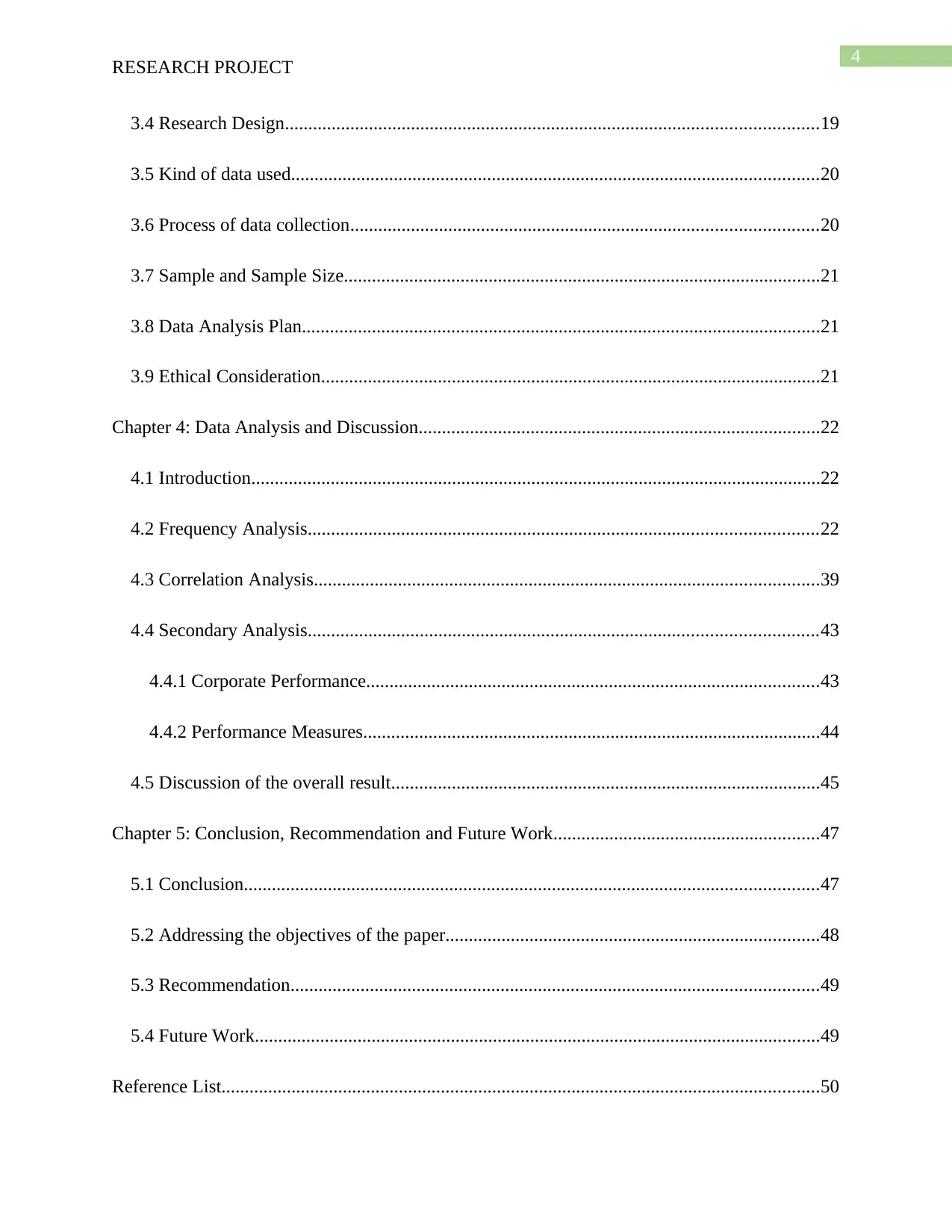
4
RESEARCH PROJECT
3.4 Research Design..................................................................................................................19
3.5 Kind of data used.................................................................................................................20
3.6 Process of data collection....................................................................................................20
3.7 Sample and Sample Size......................................................................................................21
3.8 Data Analysis Plan...............................................................................................................21
3.9 Ethical Consideration...........................................................................................................21
Chapter 4: Data Analysis and Discussion......................................................................................22
4.1 Introduction..........................................................................................................................22
4.2 Frequency Analysis.............................................................................................................22
4.3 Correlation Analysis............................................................................................................39
4.4 Secondary Analysis.............................................................................................................43
4.4.1 Corporate Performance.................................................................................................43
4.4.2 Performance Measures..................................................................................................44
4.5 Discussion of the overall result............................................................................................45
Chapter 5: Conclusion, Recommendation and Future Work.........................................................47
5.1 Conclusion...........................................................................................................................47
5.2 Addressing the objectives of the paper................................................................................48
5.3 Recommendation.................................................................................................................49
5.4 Future Work.........................................................................................................................49
Reference List................................................................................................................................50
RESEARCH PROJECT
3.4 Research Design..................................................................................................................19
3.5 Kind of data used.................................................................................................................20
3.6 Process of data collection....................................................................................................20
3.7 Sample and Sample Size......................................................................................................21
3.8 Data Analysis Plan...............................................................................................................21
3.9 Ethical Consideration...........................................................................................................21
Chapter 4: Data Analysis and Discussion......................................................................................22
4.1 Introduction..........................................................................................................................22
4.2 Frequency Analysis.............................................................................................................22
4.3 Correlation Analysis............................................................................................................39
4.4 Secondary Analysis.............................................................................................................43
4.4.1 Corporate Performance.................................................................................................43
4.4.2 Performance Measures..................................................................................................44
4.5 Discussion of the overall result............................................................................................45
Chapter 5: Conclusion, Recommendation and Future Work.........................................................47
5.1 Conclusion...........................................................................................................................47
5.2 Addressing the objectives of the paper................................................................................48
5.3 Recommendation.................................................................................................................49
5.4 Future Work.........................................................................................................................49
Reference List................................................................................................................................50

5
RESEARCH PROJECT
Appendix........................................................................................................................................55
Questionnaire.............................................................................................................................55
RESEARCH PROJECT
Appendix........................................................................................................................................55
Questionnaire.............................................................................................................................55
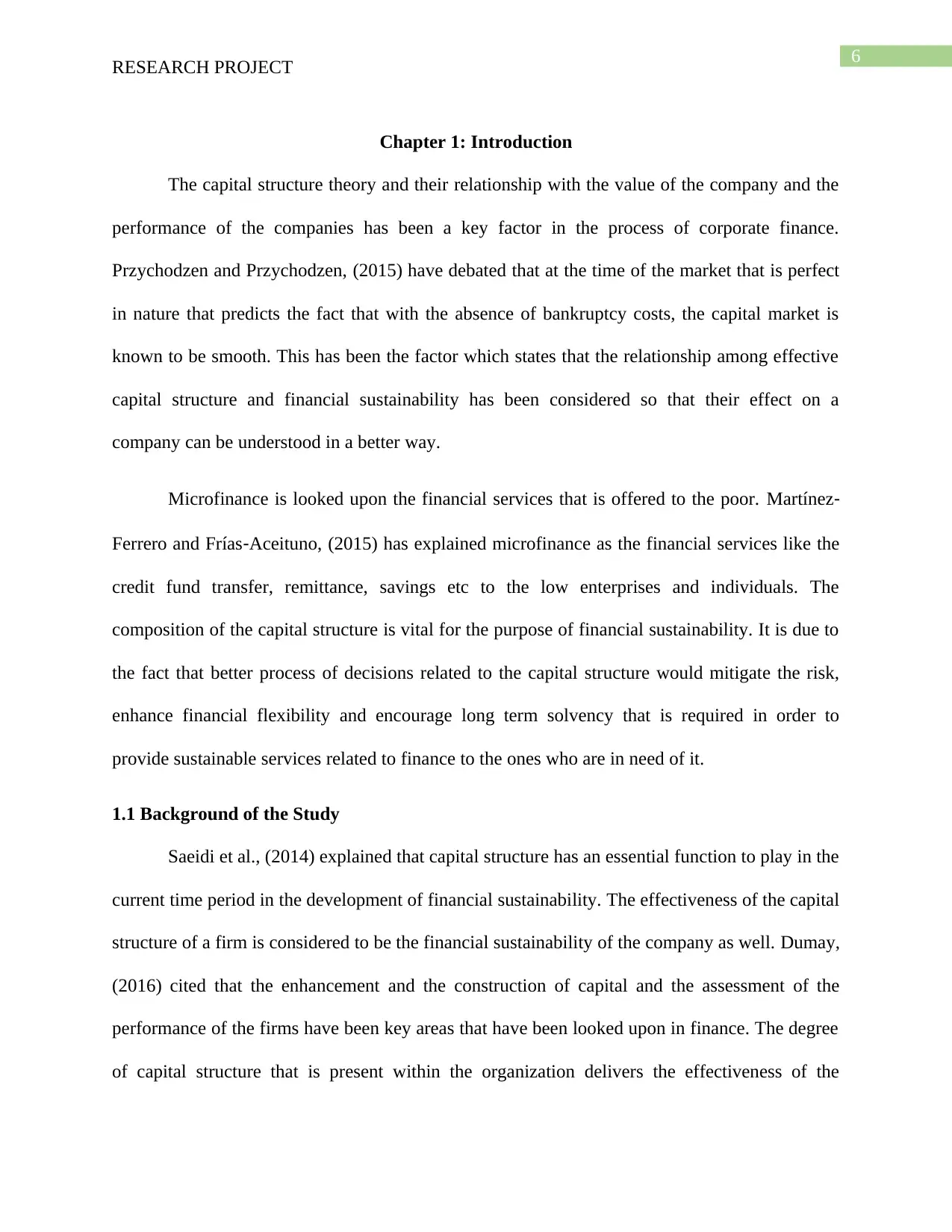
6
RESEARCH PROJECT
Chapter 1: Introduction
The capital structure theory and their relationship with the value of the company and the
performance of the companies has been a key factor in the process of corporate finance.
Przychodzen and Przychodzen, (2015) have debated that at the time of the market that is perfect
in nature that predicts the fact that with the absence of bankruptcy costs, the capital market is
known to be smooth. This has been the factor which states that the relationship among effective
capital structure and financial sustainability has been considered so that their effect on a
company can be understood in a better way.
Microfinance is looked upon the financial services that is offered to the poor. Martínez‐
Ferrero and Frías‐Aceituno, (2015) has explained microfinance as the financial services like the
credit fund transfer, remittance, savings etc to the low enterprises and individuals. The
composition of the capital structure is vital for the purpose of financial sustainability. It is due to
the fact that better process of decisions related to the capital structure would mitigate the risk,
enhance financial flexibility and encourage long term solvency that is required in order to
provide sustainable services related to finance to the ones who are in need of it.
1.1 Background of the Study
Saeidi et al., (2014) explained that capital structure has an essential function to play in the
current time period in the development of financial sustainability. The effectiveness of the capital
structure of a firm is considered to be the financial sustainability of the company as well. Dumay,
(2016) cited that the enhancement and the construction of capital and the assessment of the
performance of the firms have been key areas that have been looked upon in finance. The degree
of capital structure that is present within the organization delivers the effectiveness of the
RESEARCH PROJECT
Chapter 1: Introduction
The capital structure theory and their relationship with the value of the company and the
performance of the companies has been a key factor in the process of corporate finance.
Przychodzen and Przychodzen, (2015) have debated that at the time of the market that is perfect
in nature that predicts the fact that with the absence of bankruptcy costs, the capital market is
known to be smooth. This has been the factor which states that the relationship among effective
capital structure and financial sustainability has been considered so that their effect on a
company can be understood in a better way.
Microfinance is looked upon the financial services that is offered to the poor. Martínez‐
Ferrero and Frías‐Aceituno, (2015) has explained microfinance as the financial services like the
credit fund transfer, remittance, savings etc to the low enterprises and individuals. The
composition of the capital structure is vital for the purpose of financial sustainability. It is due to
the fact that better process of decisions related to the capital structure would mitigate the risk,
enhance financial flexibility and encourage long term solvency that is required in order to
provide sustainable services related to finance to the ones who are in need of it.
1.1 Background of the Study
Saeidi et al., (2014) explained that capital structure has an essential function to play in the
current time period in the development of financial sustainability. The effectiveness of the capital
structure of a firm is considered to be the financial sustainability of the company as well. Dumay,
(2016) cited that the enhancement and the construction of capital and the assessment of the
performance of the firms have been key areas that have been looked upon in finance. The degree
of capital structure that is present within the organization delivers the effectiveness of the
Paraphrase This Document
Need a fresh take? Get an instant paraphrase of this document with our AI Paraphraser
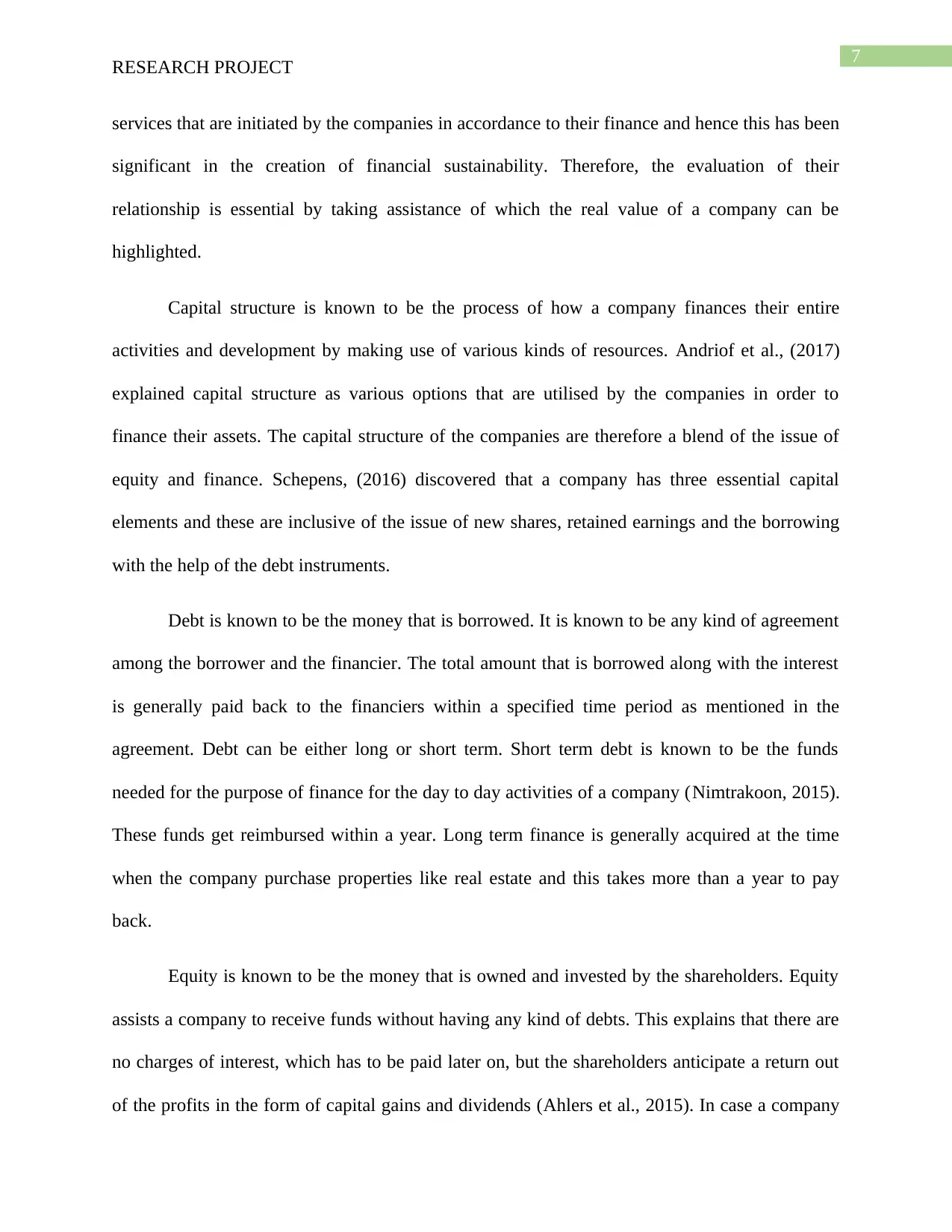
7
RESEARCH PROJECT
services that are initiated by the companies in accordance to their finance and hence this has been
significant in the creation of financial sustainability. Therefore, the evaluation of their
relationship is essential by taking assistance of which the real value of a company can be
highlighted.
Capital structure is known to be the process of how a company finances their entire
activities and development by making use of various kinds of resources. Andriof et al., (2017)
explained capital structure as various options that are utilised by the companies in order to
finance their assets. The capital structure of the companies are therefore a blend of the issue of
equity and finance. Schepens, (2016) discovered that a company has three essential capital
elements and these are inclusive of the issue of new shares, retained earnings and the borrowing
with the help of the debt instruments.
Debt is known to be the money that is borrowed. It is known to be any kind of agreement
among the borrower and the financier. The total amount that is borrowed along with the interest
is generally paid back to the financiers within a specified time period as mentioned in the
agreement. Debt can be either long or short term. Short term debt is known to be the funds
needed for the purpose of finance for the day to day activities of a company (Nimtrakoon, 2015).
These funds get reimbursed within a year. Long term finance is generally acquired at the time
when the company purchase properties like real estate and this takes more than a year to pay
back.
Equity is known to be the money that is owned and invested by the shareholders. Equity
assists a company to receive funds without having any kind of debts. This explains that there are
no charges of interest, which has to be paid later on, but the shareholders anticipate a return out
of the profits in the form of capital gains and dividends (Ahlers et al., 2015). In case a company
RESEARCH PROJECT
services that are initiated by the companies in accordance to their finance and hence this has been
significant in the creation of financial sustainability. Therefore, the evaluation of their
relationship is essential by taking assistance of which the real value of a company can be
highlighted.
Capital structure is known to be the process of how a company finances their entire
activities and development by making use of various kinds of resources. Andriof et al., (2017)
explained capital structure as various options that are utilised by the companies in order to
finance their assets. The capital structure of the companies are therefore a blend of the issue of
equity and finance. Schepens, (2016) discovered that a company has three essential capital
elements and these are inclusive of the issue of new shares, retained earnings and the borrowing
with the help of the debt instruments.
Debt is known to be the money that is borrowed. It is known to be any kind of agreement
among the borrower and the financier. The total amount that is borrowed along with the interest
is generally paid back to the financiers within a specified time period as mentioned in the
agreement. Debt can be either long or short term. Short term debt is known to be the funds
needed for the purpose of finance for the day to day activities of a company (Nimtrakoon, 2015).
These funds get reimbursed within a year. Long term finance is generally acquired at the time
when the company purchase properties like real estate and this takes more than a year to pay
back.
Equity is known to be the money that is owned and invested by the shareholders. Equity
assists a company to receive funds without having any kind of debts. This explains that there are
no charges of interest, which has to be paid later on, but the shareholders anticipate a return out
of the profits in the form of capital gains and dividends (Ahlers et al., 2015). In case a company
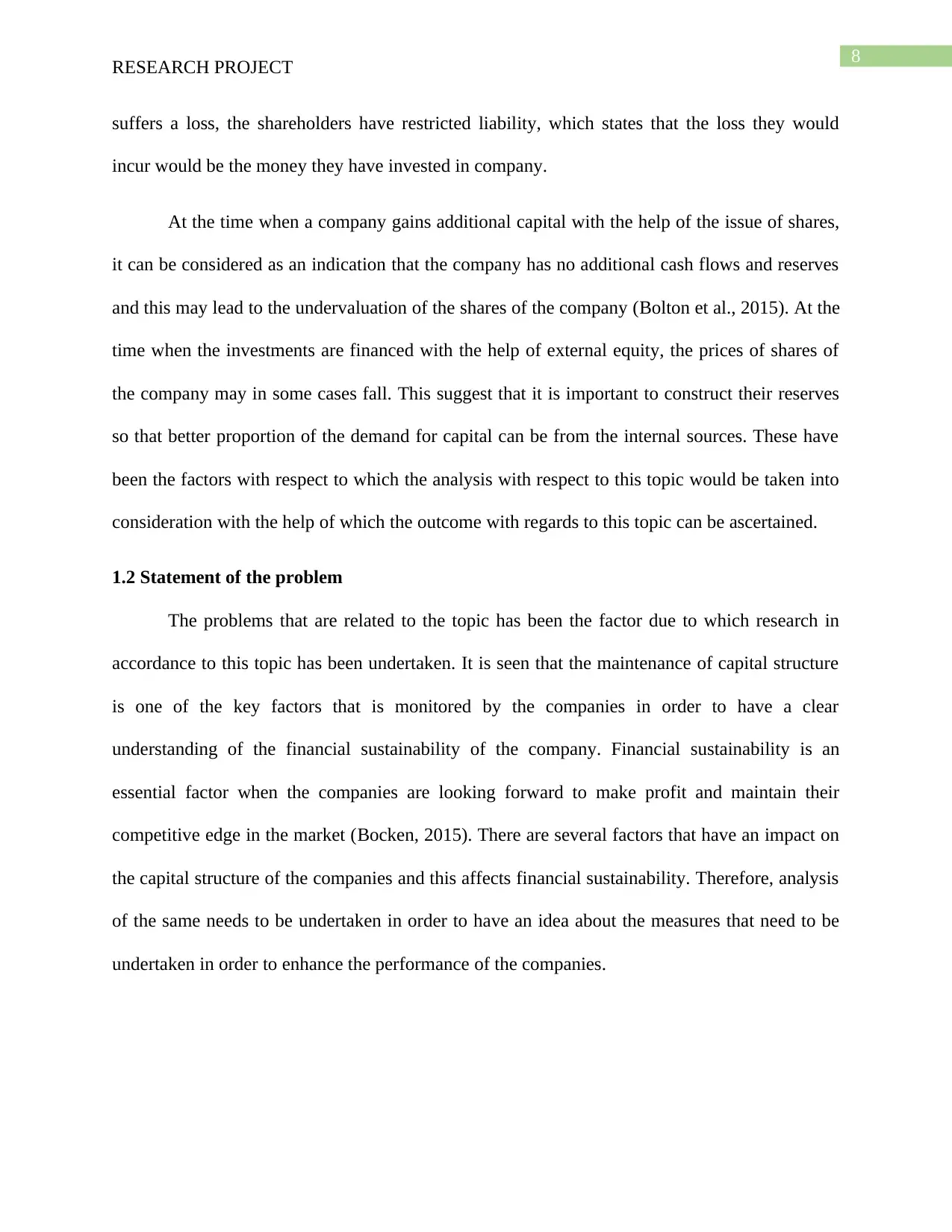
8
RESEARCH PROJECT
suffers a loss, the shareholders have restricted liability, which states that the loss they would
incur would be the money they have invested in company.
At the time when a company gains additional capital with the help of the issue of shares,
it can be considered as an indication that the company has no additional cash flows and reserves
and this may lead to the undervaluation of the shares of the company (Bolton et al., 2015). At the
time when the investments are financed with the help of external equity, the prices of shares of
the company may in some cases fall. This suggest that it is important to construct their reserves
so that better proportion of the demand for capital can be from the internal sources. These have
been the factors with respect to which the analysis with respect to this topic would be taken into
consideration with the help of which the outcome with regards to this topic can be ascertained.
1.2 Statement of the problem
The problems that are related to the topic has been the factor due to which research in
accordance to this topic has been undertaken. It is seen that the maintenance of capital structure
is one of the key factors that is monitored by the companies in order to have a clear
understanding of the financial sustainability of the company. Financial sustainability is an
essential factor when the companies are looking forward to make profit and maintain their
competitive edge in the market (Bocken, 2015). There are several factors that have an impact on
the capital structure of the companies and this affects financial sustainability. Therefore, analysis
of the same needs to be undertaken in order to have an idea about the measures that need to be
undertaken in order to enhance the performance of the companies.
RESEARCH PROJECT
suffers a loss, the shareholders have restricted liability, which states that the loss they would
incur would be the money they have invested in company.
At the time when a company gains additional capital with the help of the issue of shares,
it can be considered as an indication that the company has no additional cash flows and reserves
and this may lead to the undervaluation of the shares of the company (Bolton et al., 2015). At the
time when the investments are financed with the help of external equity, the prices of shares of
the company may in some cases fall. This suggest that it is important to construct their reserves
so that better proportion of the demand for capital can be from the internal sources. These have
been the factors with respect to which the analysis with respect to this topic would be taken into
consideration with the help of which the outcome with regards to this topic can be ascertained.
1.2 Statement of the problem
The problems that are related to the topic has been the factor due to which research in
accordance to this topic has been undertaken. It is seen that the maintenance of capital structure
is one of the key factors that is monitored by the companies in order to have a clear
understanding of the financial sustainability of the company. Financial sustainability is an
essential factor when the companies are looking forward to make profit and maintain their
competitive edge in the market (Bocken, 2015). There are several factors that have an impact on
the capital structure of the companies and this affects financial sustainability. Therefore, analysis
of the same needs to be undertaken in order to have an idea about the measures that need to be
undertaken in order to enhance the performance of the companies.
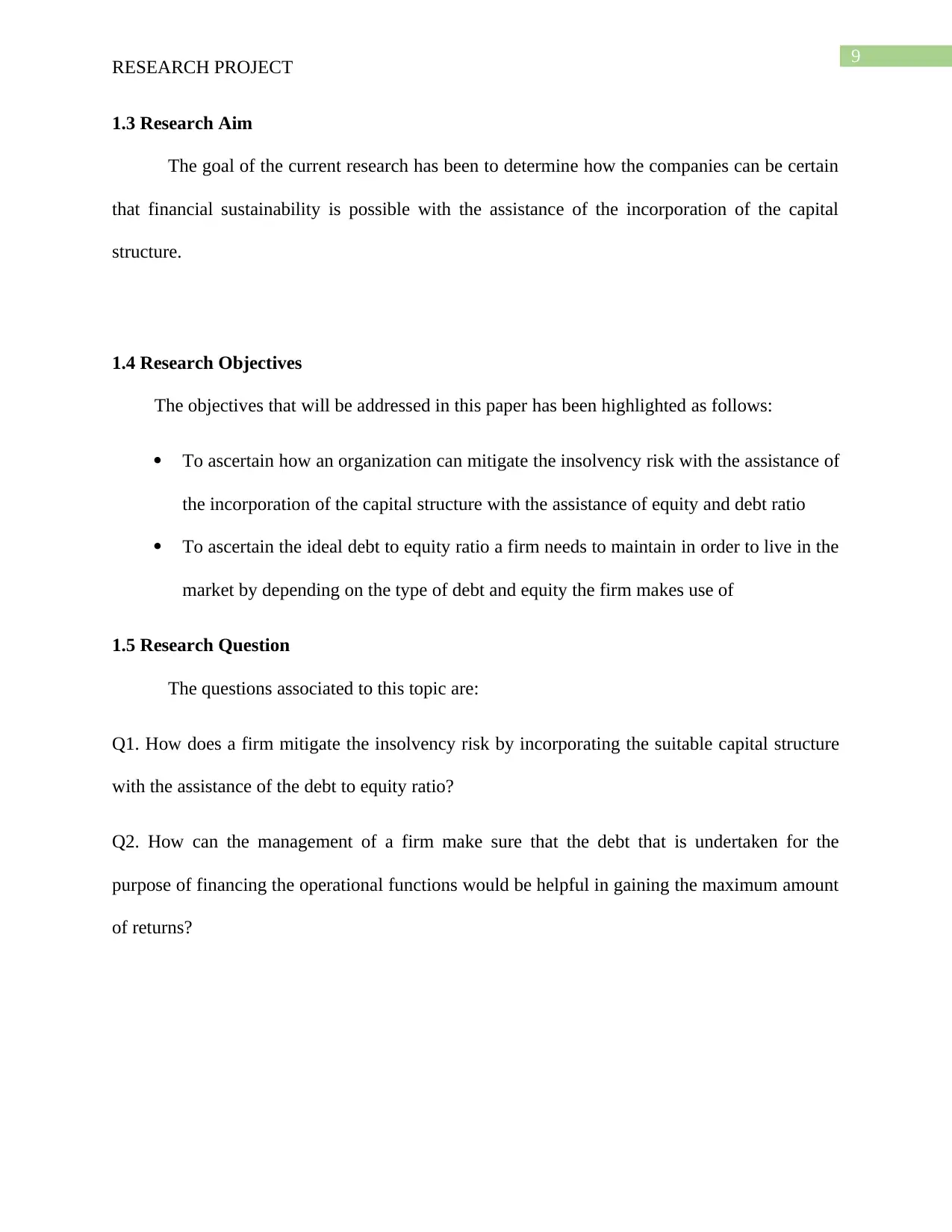
9
RESEARCH PROJECT
1.3 Research Aim
The goal of the current research has been to determine how the companies can be certain
that financial sustainability is possible with the assistance of the incorporation of the capital
structure.
1.4 Research Objectives
The objectives that will be addressed in this paper has been highlighted as follows:
To ascertain how an organization can mitigate the insolvency risk with the assistance of
the incorporation of the capital structure with the assistance of equity and debt ratio
To ascertain the ideal debt to equity ratio a firm needs to maintain in order to live in the
market by depending on the type of debt and equity the firm makes use of
1.5 Research Question
The questions associated to this topic are:
Q1. How does a firm mitigate the insolvency risk by incorporating the suitable capital structure
with the assistance of the debt to equity ratio?
Q2. How can the management of a firm make sure that the debt that is undertaken for the
purpose of financing the operational functions would be helpful in gaining the maximum amount
of returns?
RESEARCH PROJECT
1.3 Research Aim
The goal of the current research has been to determine how the companies can be certain
that financial sustainability is possible with the assistance of the incorporation of the capital
structure.
1.4 Research Objectives
The objectives that will be addressed in this paper has been highlighted as follows:
To ascertain how an organization can mitigate the insolvency risk with the assistance of
the incorporation of the capital structure with the assistance of equity and debt ratio
To ascertain the ideal debt to equity ratio a firm needs to maintain in order to live in the
market by depending on the type of debt and equity the firm makes use of
1.5 Research Question
The questions associated to this topic are:
Q1. How does a firm mitigate the insolvency risk by incorporating the suitable capital structure
with the assistance of the debt to equity ratio?
Q2. How can the management of a firm make sure that the debt that is undertaken for the
purpose of financing the operational functions would be helpful in gaining the maximum amount
of returns?
Secure Best Marks with AI Grader
Need help grading? Try our AI Grader for instant feedback on your assignments.
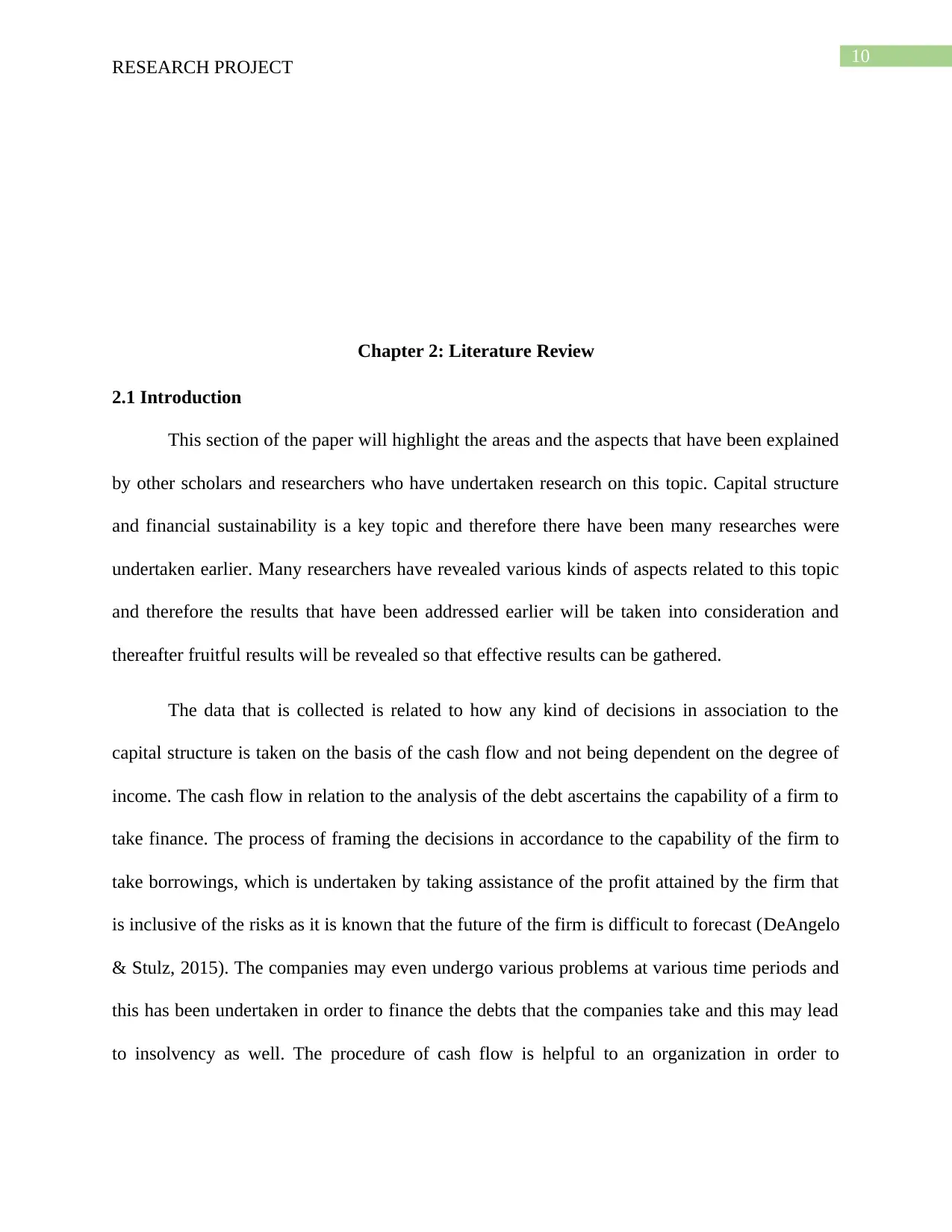
10
RESEARCH PROJECT
Chapter 2: Literature Review
2.1 Introduction
This section of the paper will highlight the areas and the aspects that have been explained
by other scholars and researchers who have undertaken research on this topic. Capital structure
and financial sustainability is a key topic and therefore there have been many researches were
undertaken earlier. Many researchers have revealed various kinds of aspects related to this topic
and therefore the results that have been addressed earlier will be taken into consideration and
thereafter fruitful results will be revealed so that effective results can be gathered.
The data that is collected is related to how any kind of decisions in association to the
capital structure is taken on the basis of the cash flow and not being dependent on the degree of
income. The cash flow in relation to the analysis of the debt ascertains the capability of a firm to
take finance. The process of framing the decisions in accordance to the capability of the firm to
take borrowings, which is undertaken by taking assistance of the profit attained by the firm that
is inclusive of the risks as it is known that the future of the firm is difficult to forecast (DeAngelo
& Stulz, 2015). The companies may even undergo various problems at various time periods and
this has been undertaken in order to finance the debts that the companies take and this may lead
to insolvency as well. The procedure of cash flow is helpful to an organization in order to
RESEARCH PROJECT
Chapter 2: Literature Review
2.1 Introduction
This section of the paper will highlight the areas and the aspects that have been explained
by other scholars and researchers who have undertaken research on this topic. Capital structure
and financial sustainability is a key topic and therefore there have been many researches were
undertaken earlier. Many researchers have revealed various kinds of aspects related to this topic
and therefore the results that have been addressed earlier will be taken into consideration and
thereafter fruitful results will be revealed so that effective results can be gathered.
The data that is collected is related to how any kind of decisions in association to the
capital structure is taken on the basis of the cash flow and not being dependent on the degree of
income. The cash flow in relation to the analysis of the debt ascertains the capability of a firm to
take finance. The process of framing the decisions in accordance to the capability of the firm to
take borrowings, which is undertaken by taking assistance of the profit attained by the firm that
is inclusive of the risks as it is known that the future of the firm is difficult to forecast (DeAngelo
& Stulz, 2015). The companies may even undergo various problems at various time periods and
this has been undertaken in order to finance the debts that the companies take and this may lead
to insolvency as well. The procedure of cash flow is helpful to an organization in order to
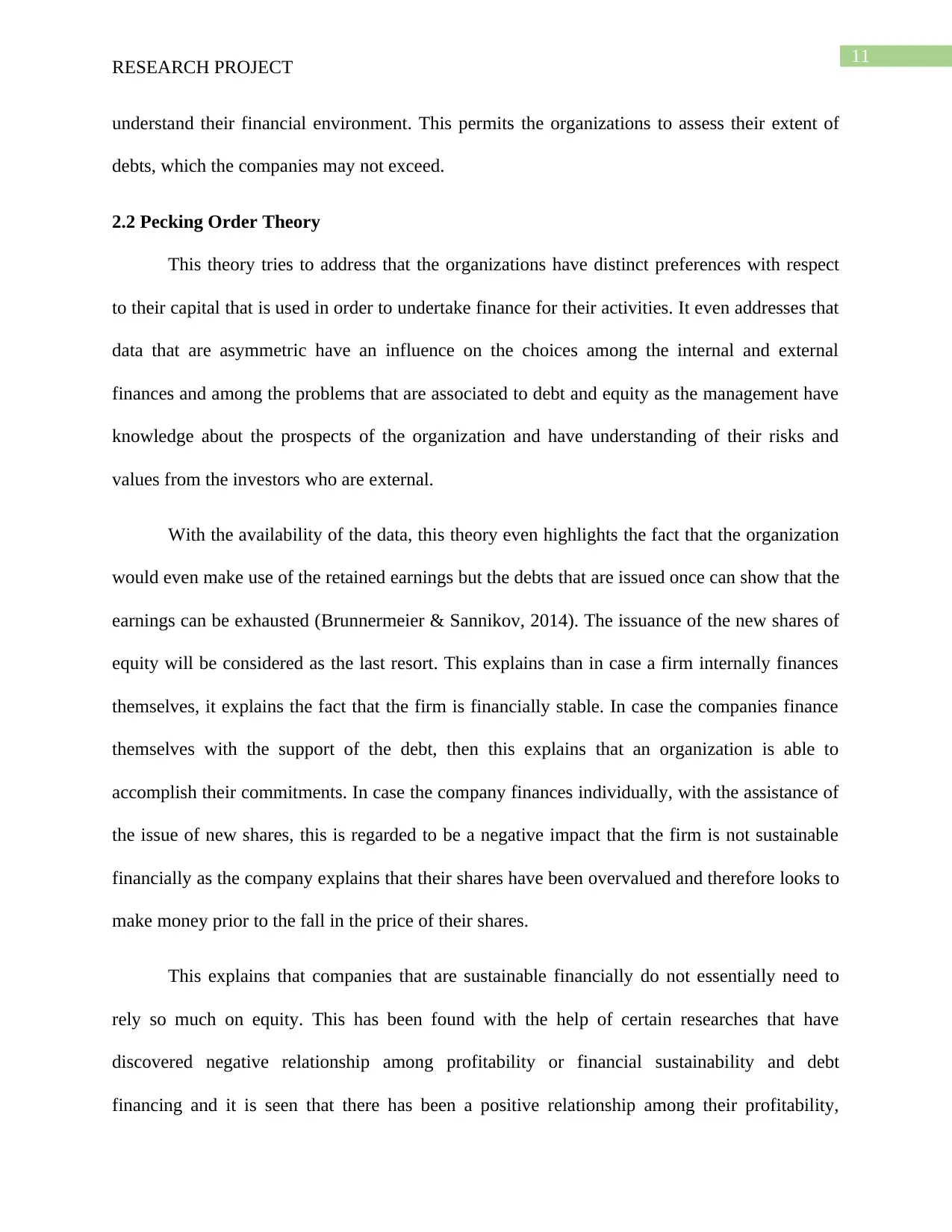
11
RESEARCH PROJECT
understand their financial environment. This permits the organizations to assess their extent of
debts, which the companies may not exceed.
2.2 Pecking Order Theory
This theory tries to address that the organizations have distinct preferences with respect
to their capital that is used in order to undertake finance for their activities. It even addresses that
data that are asymmetric have an influence on the choices among the internal and external
finances and among the problems that are associated to debt and equity as the management have
knowledge about the prospects of the organization and have understanding of their risks and
values from the investors who are external.
With the availability of the data, this theory even highlights the fact that the organization
would even make use of the retained earnings but the debts that are issued once can show that the
earnings can be exhausted (Brunnermeier & Sannikov, 2014). The issuance of the new shares of
equity will be considered as the last resort. This explains than in case a firm internally finances
themselves, it explains the fact that the firm is financially stable. In case the companies finance
themselves with the support of the debt, then this explains that an organization is able to
accomplish their commitments. In case the company finances individually, with the assistance of
the issue of new shares, this is regarded to be a negative impact that the firm is not sustainable
financially as the company explains that their shares have been overvalued and therefore looks to
make money prior to the fall in the price of their shares.
This explains that companies that are sustainable financially do not essentially need to
rely so much on equity. This has been found with the help of certain researches that have
discovered negative relationship among profitability or financial sustainability and debt
financing and it is seen that there has been a positive relationship among their profitability,
RESEARCH PROJECT
understand their financial environment. This permits the organizations to assess their extent of
debts, which the companies may not exceed.
2.2 Pecking Order Theory
This theory tries to address that the organizations have distinct preferences with respect
to their capital that is used in order to undertake finance for their activities. It even addresses that
data that are asymmetric have an influence on the choices among the internal and external
finances and among the problems that are associated to debt and equity as the management have
knowledge about the prospects of the organization and have understanding of their risks and
values from the investors who are external.
With the availability of the data, this theory even highlights the fact that the organization
would even make use of the retained earnings but the debts that are issued once can show that the
earnings can be exhausted (Brunnermeier & Sannikov, 2014). The issuance of the new shares of
equity will be considered as the last resort. This explains than in case a firm internally finances
themselves, it explains the fact that the firm is financially stable. In case the companies finance
themselves with the support of the debt, then this explains that an organization is able to
accomplish their commitments. In case the company finances individually, with the assistance of
the issue of new shares, this is regarded to be a negative impact that the firm is not sustainable
financially as the company explains that their shares have been overvalued and therefore looks to
make money prior to the fall in the price of their shares.
This explains that companies that are sustainable financially do not essentially need to
rely so much on equity. This has been found with the help of certain researches that have
discovered negative relationship among profitability or financial sustainability and debt
financing and it is seen that there has been a positive relationship among their profitability,
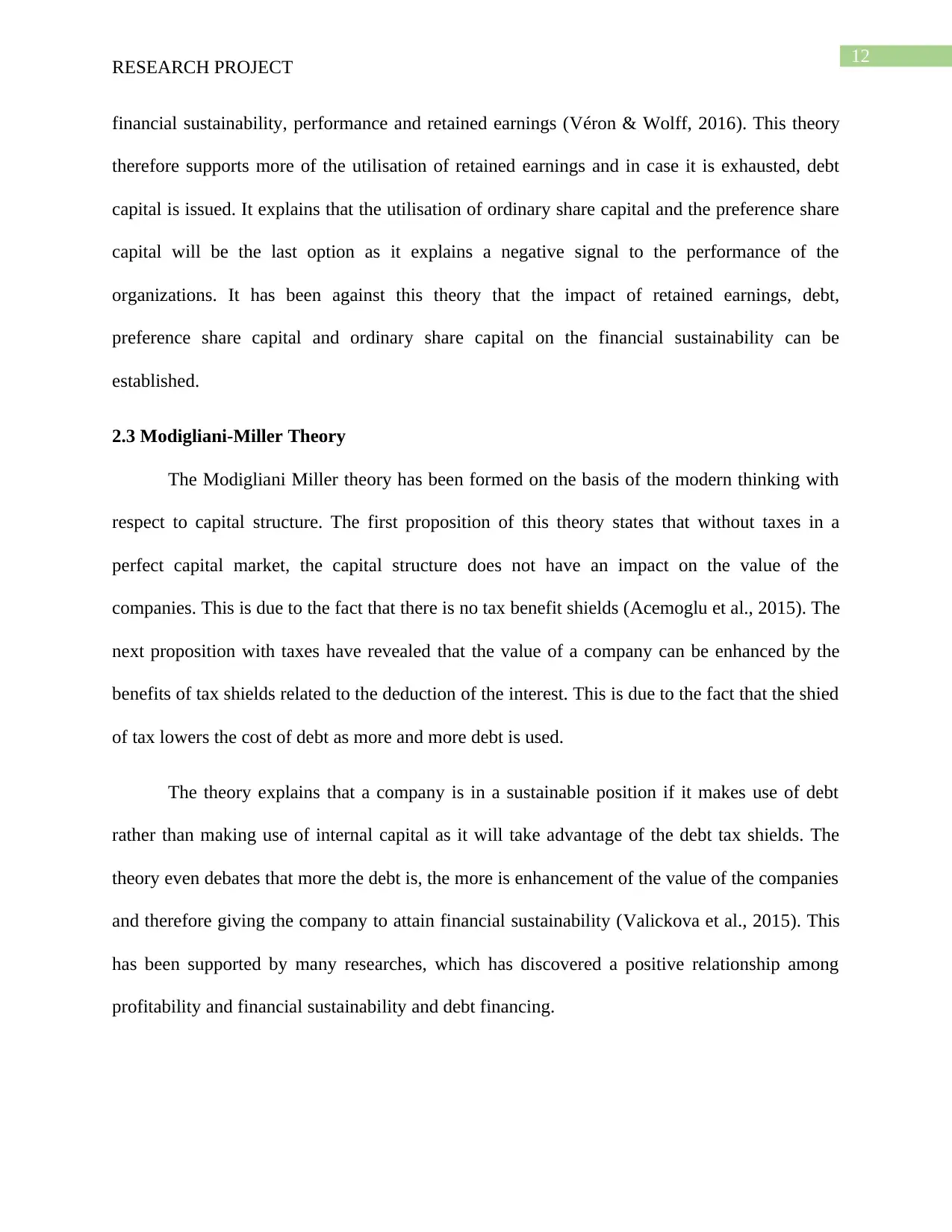
12
RESEARCH PROJECT
financial sustainability, performance and retained earnings (Véron & Wolff, 2016). This theory
therefore supports more of the utilisation of retained earnings and in case it is exhausted, debt
capital is issued. It explains that the utilisation of ordinary share capital and the preference share
capital will be the last option as it explains a negative signal to the performance of the
organizations. It has been against this theory that the impact of retained earnings, debt,
preference share capital and ordinary share capital on the financial sustainability can be
established.
2.3 Modigliani-Miller Theory
The Modigliani Miller theory has been formed on the basis of the modern thinking with
respect to capital structure. The first proposition of this theory states that without taxes in a
perfect capital market, the capital structure does not have an impact on the value of the
companies. This is due to the fact that there is no tax benefit shields (Acemoglu et al., 2015). The
next proposition with taxes have revealed that the value of a company can be enhanced by the
benefits of tax shields related to the deduction of the interest. This is due to the fact that the shied
of tax lowers the cost of debt as more and more debt is used.
The theory explains that a company is in a sustainable position if it makes use of debt
rather than making use of internal capital as it will take advantage of the debt tax shields. The
theory even debates that more the debt is, the more is enhancement of the value of the companies
and therefore giving the company to attain financial sustainability (Valickova et al., 2015). This
has been supported by many researches, which has discovered a positive relationship among
profitability and financial sustainability and debt financing.
RESEARCH PROJECT
financial sustainability, performance and retained earnings (Véron & Wolff, 2016). This theory
therefore supports more of the utilisation of retained earnings and in case it is exhausted, debt
capital is issued. It explains that the utilisation of ordinary share capital and the preference share
capital will be the last option as it explains a negative signal to the performance of the
organizations. It has been against this theory that the impact of retained earnings, debt,
preference share capital and ordinary share capital on the financial sustainability can be
established.
2.3 Modigliani-Miller Theory
The Modigliani Miller theory has been formed on the basis of the modern thinking with
respect to capital structure. The first proposition of this theory states that without taxes in a
perfect capital market, the capital structure does not have an impact on the value of the
companies. This is due to the fact that there is no tax benefit shields (Acemoglu et al., 2015). The
next proposition with taxes have revealed that the value of a company can be enhanced by the
benefits of tax shields related to the deduction of the interest. This is due to the fact that the shied
of tax lowers the cost of debt as more and more debt is used.
The theory explains that a company is in a sustainable position if it makes use of debt
rather than making use of internal capital as it will take advantage of the debt tax shields. The
theory even debates that more the debt is, the more is enhancement of the value of the companies
and therefore giving the company to attain financial sustainability (Valickova et al., 2015). This
has been supported by many researches, which has discovered a positive relationship among
profitability and financial sustainability and debt financing.
Paraphrase This Document
Need a fresh take? Get an instant paraphrase of this document with our AI Paraphraser

13
RESEARCH PROJECT
This theory has supported more utilisation of debt other than internal capital. It has been
against this theory that the impact of ordinary share capital, retained earnings and preferred share
capital on financial sustainability that has to be established.
2.4 Debt Capital and Financial Sustainability
There have been numerous studies that have explained that debt has a positive, negative
or no impact on financial sustainability. Fraser et al., (2015) examined the impact of the selected
portfolio at risk, effective management, rate of interest, productivity ratio on the financial
sustainability of the companies.
Guerry et al., (2015) undertook a study on the impact of capital structure on the extent of
profit of the American manufacturing companies. They undertook analysis of correlation and
regression. It was discovered that there exists a positive relationship among the short term
profitability and debt; profitability and long term debts; between overall debt and profitability of
the manufacturing industry.
Graham et al., (2015) examined a research on the effect of capital structure on the
profitability of the companies by taking assistance of the cement companies in India. The
research was on the basis of five year financial report of the selected companies. The outcome of
the research has been that there has been negative relationship among profitability and debt that
this explains that the organizations with higher level of debts look to have lower level of
profitability.
Ortiz‐de‐Mandojana and Bansal, (2016) undertook a study on financial sustainability of
the micro-financing companies of Bangladesh. The research was on the basis of the ratio of the
capital assets, operating expense, write off ratio have an influence greatly on the financial
RESEARCH PROJECT
This theory has supported more utilisation of debt other than internal capital. It has been
against this theory that the impact of ordinary share capital, retained earnings and preferred share
capital on financial sustainability that has to be established.
2.4 Debt Capital and Financial Sustainability
There have been numerous studies that have explained that debt has a positive, negative
or no impact on financial sustainability. Fraser et al., (2015) examined the impact of the selected
portfolio at risk, effective management, rate of interest, productivity ratio on the financial
sustainability of the companies.
Guerry et al., (2015) undertook a study on the impact of capital structure on the extent of
profit of the American manufacturing companies. They undertook analysis of correlation and
regression. It was discovered that there exists a positive relationship among the short term
profitability and debt; profitability and long term debts; between overall debt and profitability of
the manufacturing industry.
Graham et al., (2015) examined a research on the effect of capital structure on the
profitability of the companies by taking assistance of the cement companies in India. The
research was on the basis of five year financial report of the selected companies. The outcome of
the research has been that there has been negative relationship among profitability and debt that
this explains that the organizations with higher level of debts look to have lower level of
profitability.
Ortiz‐de‐Mandojana and Bansal, (2016) undertook a study on financial sustainability of
the micro-financing companies of Bangladesh. The research was on the basis of the ratio of the
capital assets, operating expense, write off ratio have an influence greatly on the financial
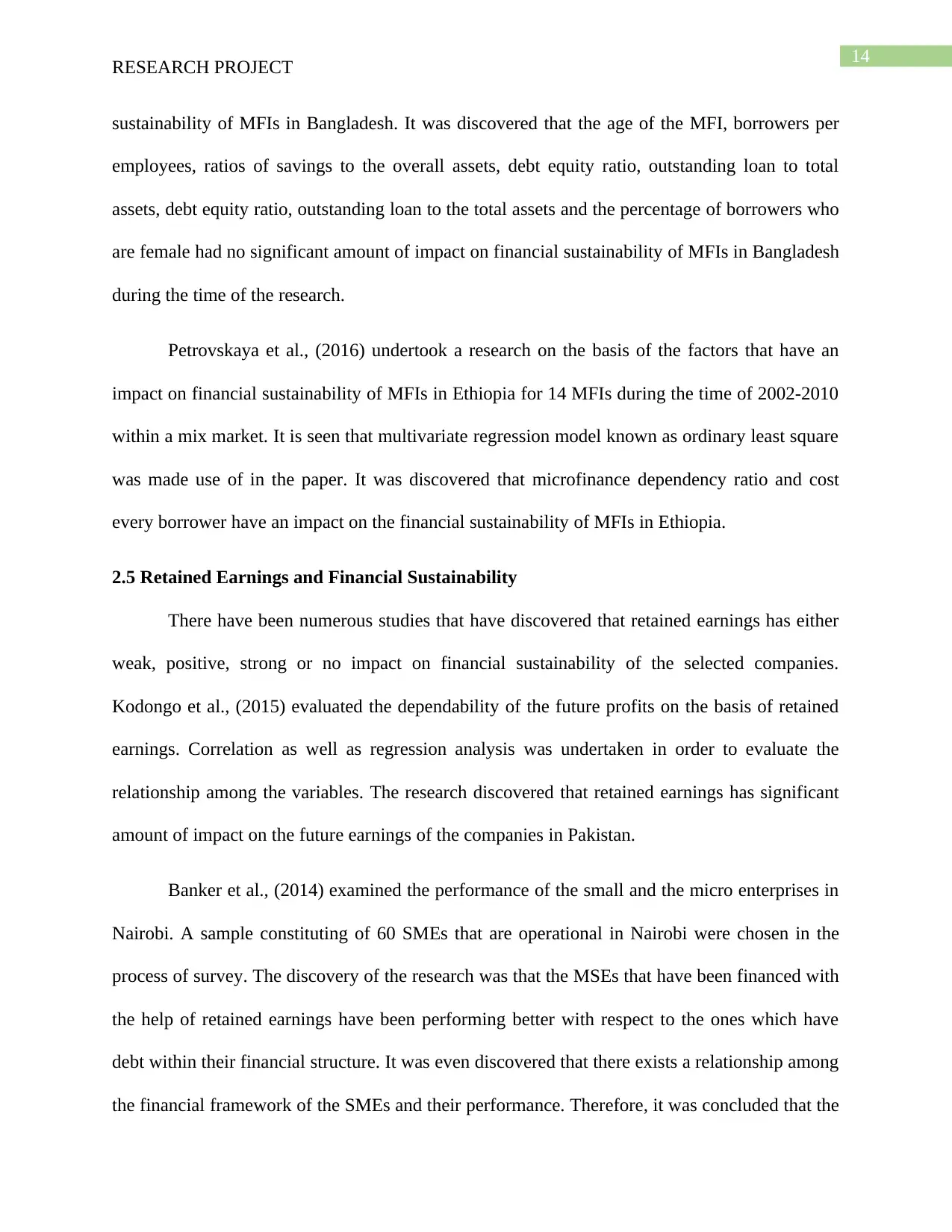
14
RESEARCH PROJECT
sustainability of MFIs in Bangladesh. It was discovered that the age of the MFI, borrowers per
employees, ratios of savings to the overall assets, debt equity ratio, outstanding loan to total
assets, debt equity ratio, outstanding loan to the total assets and the percentage of borrowers who
are female had no significant amount of impact on financial sustainability of MFIs in Bangladesh
during the time of the research.
Petrovskaya et al., (2016) undertook a research on the basis of the factors that have an
impact on financial sustainability of MFIs in Ethiopia for 14 MFIs during the time of 2002-2010
within a mix market. It is seen that multivariate regression model known as ordinary least square
was made use of in the paper. It was discovered that microfinance dependency ratio and cost
every borrower have an impact on the financial sustainability of MFIs in Ethiopia.
2.5 Retained Earnings and Financial Sustainability
There have been numerous studies that have discovered that retained earnings has either
weak, positive, strong or no impact on financial sustainability of the selected companies.
Kodongo et al., (2015) evaluated the dependability of the future profits on the basis of retained
earnings. Correlation as well as regression analysis was undertaken in order to evaluate the
relationship among the variables. The research discovered that retained earnings has significant
amount of impact on the future earnings of the companies in Pakistan.
Banker et al., (2014) examined the performance of the small and the micro enterprises in
Nairobi. A sample constituting of 60 SMEs that are operational in Nairobi were chosen in the
process of survey. The discovery of the research was that the MSEs that have been financed with
the help of retained earnings have been performing better with respect to the ones which have
debt within their financial structure. It was even discovered that there exists a relationship among
the financial framework of the SMEs and their performance. Therefore, it was concluded that the
RESEARCH PROJECT
sustainability of MFIs in Bangladesh. It was discovered that the age of the MFI, borrowers per
employees, ratios of savings to the overall assets, debt equity ratio, outstanding loan to total
assets, debt equity ratio, outstanding loan to the total assets and the percentage of borrowers who
are female had no significant amount of impact on financial sustainability of MFIs in Bangladesh
during the time of the research.
Petrovskaya et al., (2016) undertook a research on the basis of the factors that have an
impact on financial sustainability of MFIs in Ethiopia for 14 MFIs during the time of 2002-2010
within a mix market. It is seen that multivariate regression model known as ordinary least square
was made use of in the paper. It was discovered that microfinance dependency ratio and cost
every borrower have an impact on the financial sustainability of MFIs in Ethiopia.
2.5 Retained Earnings and Financial Sustainability
There have been numerous studies that have discovered that retained earnings has either
weak, positive, strong or no impact on financial sustainability of the selected companies.
Kodongo et al., (2015) evaluated the dependability of the future profits on the basis of retained
earnings. Correlation as well as regression analysis was undertaken in order to evaluate the
relationship among the variables. The research discovered that retained earnings has significant
amount of impact on the future earnings of the companies in Pakistan.
Banker et al., (2014) examined the performance of the small and the micro enterprises in
Nairobi. A sample constituting of 60 SMEs that are operational in Nairobi were chosen in the
process of survey. The discovery of the research was that the MSEs that have been financed with
the help of retained earnings have been performing better with respect to the ones which have
debt within their financial structure. It was even discovered that there exists a relationship among
the financial framework of the SMEs and their performance. Therefore, it was concluded that the
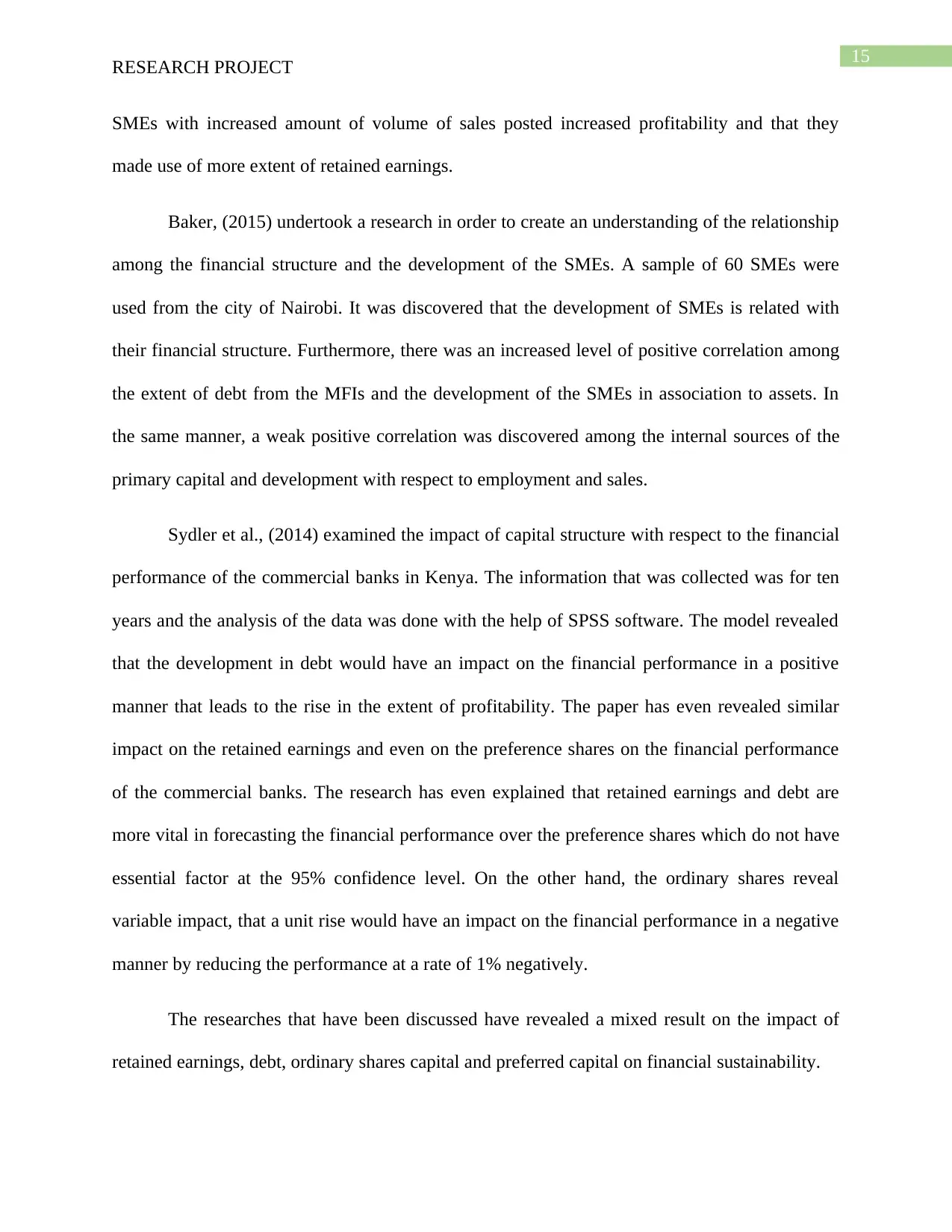
15
RESEARCH PROJECT
SMEs with increased amount of volume of sales posted increased profitability and that they
made use of more extent of retained earnings.
Baker, (2015) undertook a research in order to create an understanding of the relationship
among the financial structure and the development of the SMEs. A sample of 60 SMEs were
used from the city of Nairobi. It was discovered that the development of SMEs is related with
their financial structure. Furthermore, there was an increased level of positive correlation among
the extent of debt from the MFIs and the development of the SMEs in association to assets. In
the same manner, a weak positive correlation was discovered among the internal sources of the
primary capital and development with respect to employment and sales.
Sydler et al., (2014) examined the impact of capital structure with respect to the financial
performance of the commercial banks in Kenya. The information that was collected was for ten
years and the analysis of the data was done with the help of SPSS software. The model revealed
that the development in debt would have an impact on the financial performance in a positive
manner that leads to the rise in the extent of profitability. The paper has even revealed similar
impact on the retained earnings and even on the preference shares on the financial performance
of the commercial banks. The research has even explained that retained earnings and debt are
more vital in forecasting the financial performance over the preference shares which do not have
essential factor at the 95% confidence level. On the other hand, the ordinary shares reveal
variable impact, that a unit rise would have an impact on the financial performance in a negative
manner by reducing the performance at a rate of 1% negatively.
The researches that have been discussed have revealed a mixed result on the impact of
retained earnings, debt, ordinary shares capital and preferred capital on financial sustainability.
RESEARCH PROJECT
SMEs with increased amount of volume of sales posted increased profitability and that they
made use of more extent of retained earnings.
Baker, (2015) undertook a research in order to create an understanding of the relationship
among the financial structure and the development of the SMEs. A sample of 60 SMEs were
used from the city of Nairobi. It was discovered that the development of SMEs is related with
their financial structure. Furthermore, there was an increased level of positive correlation among
the extent of debt from the MFIs and the development of the SMEs in association to assets. In
the same manner, a weak positive correlation was discovered among the internal sources of the
primary capital and development with respect to employment and sales.
Sydler et al., (2014) examined the impact of capital structure with respect to the financial
performance of the commercial banks in Kenya. The information that was collected was for ten
years and the analysis of the data was done with the help of SPSS software. The model revealed
that the development in debt would have an impact on the financial performance in a positive
manner that leads to the rise in the extent of profitability. The paper has even revealed similar
impact on the retained earnings and even on the preference shares on the financial performance
of the commercial banks. The research has even explained that retained earnings and debt are
more vital in forecasting the financial performance over the preference shares which do not have
essential factor at the 95% confidence level. On the other hand, the ordinary shares reveal
variable impact, that a unit rise would have an impact on the financial performance in a negative
manner by reducing the performance at a rate of 1% negatively.
The researches that have been discussed have revealed a mixed result on the impact of
retained earnings, debt, ordinary shares capital and preferred capital on financial sustainability.
Secure Best Marks with AI Grader
Need help grading? Try our AI Grader for instant feedback on your assignments.
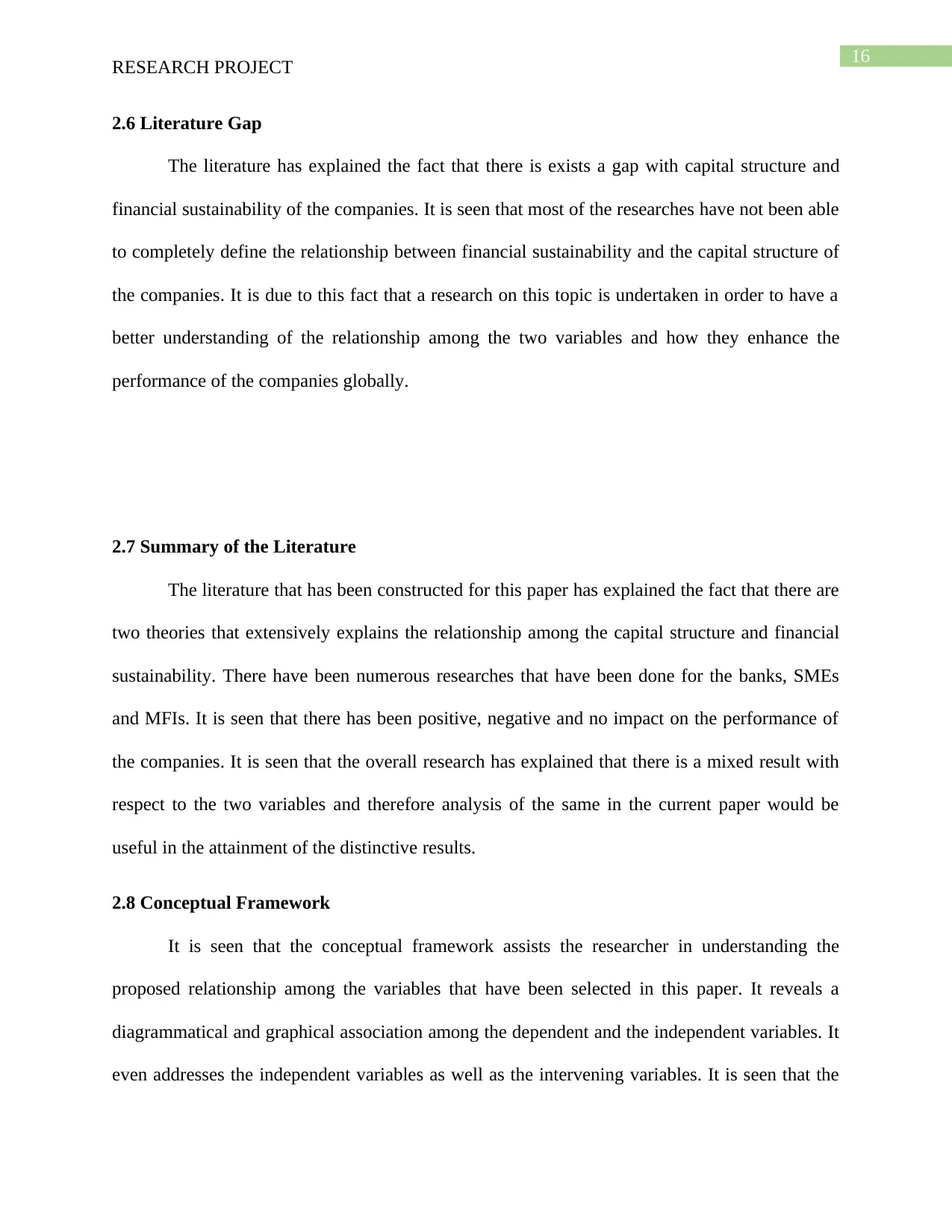
16
RESEARCH PROJECT
2.6 Literature Gap
The literature has explained the fact that there is exists a gap with capital structure and
financial sustainability of the companies. It is seen that most of the researches have not been able
to completely define the relationship between financial sustainability and the capital structure of
the companies. It is due to this fact that a research on this topic is undertaken in order to have a
better understanding of the relationship among the two variables and how they enhance the
performance of the companies globally.
2.7 Summary of the Literature
The literature that has been constructed for this paper has explained the fact that there are
two theories that extensively explains the relationship among the capital structure and financial
sustainability. There have been numerous researches that have been done for the banks, SMEs
and MFIs. It is seen that there has been positive, negative and no impact on the performance of
the companies. It is seen that the overall research has explained that there is a mixed result with
respect to the two variables and therefore analysis of the same in the current paper would be
useful in the attainment of the distinctive results.
2.8 Conceptual Framework
It is seen that the conceptual framework assists the researcher in understanding the
proposed relationship among the variables that have been selected in this paper. It reveals a
diagrammatical and graphical association among the dependent and the independent variables. It
even addresses the independent variables as well as the intervening variables. It is seen that the
RESEARCH PROJECT
2.6 Literature Gap
The literature has explained the fact that there is exists a gap with capital structure and
financial sustainability of the companies. It is seen that most of the researches have not been able
to completely define the relationship between financial sustainability and the capital structure of
the companies. It is due to this fact that a research on this topic is undertaken in order to have a
better understanding of the relationship among the two variables and how they enhance the
performance of the companies globally.
2.7 Summary of the Literature
The literature that has been constructed for this paper has explained the fact that there are
two theories that extensively explains the relationship among the capital structure and financial
sustainability. There have been numerous researches that have been done for the banks, SMEs
and MFIs. It is seen that there has been positive, negative and no impact on the performance of
the companies. It is seen that the overall research has explained that there is a mixed result with
respect to the two variables and therefore analysis of the same in the current paper would be
useful in the attainment of the distinctive results.
2.8 Conceptual Framework
It is seen that the conceptual framework assists the researcher in understanding the
proposed relationship among the variables that have been selected in this paper. It reveals a
diagrammatical and graphical association among the dependent and the independent variables. It
even addresses the independent variables as well as the intervening variables. It is seen that the
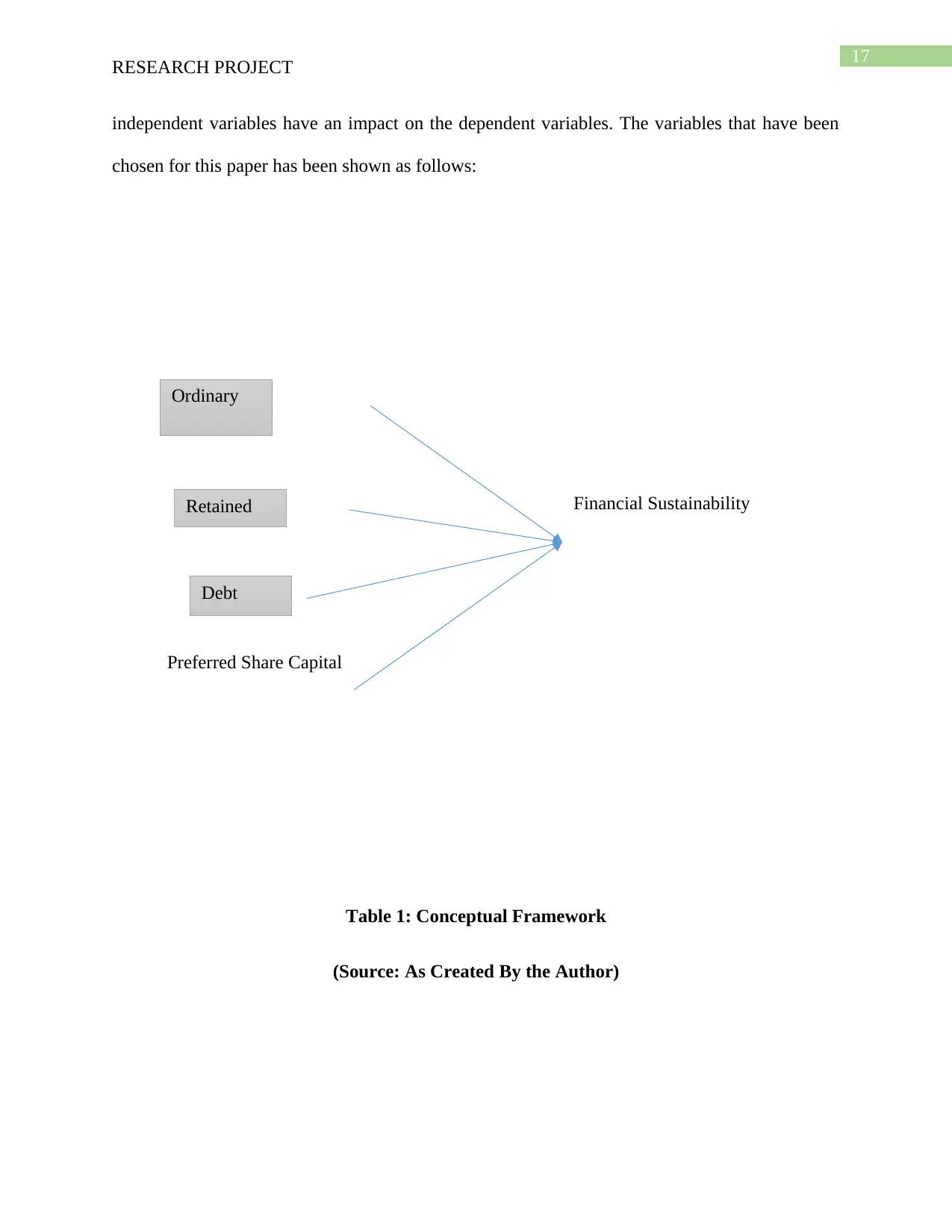
17
Preferred Share Capital
Financial Sustainability
RESEARCH PROJECT
independent variables have an impact on the dependent variables. The variables that have been
chosen for this paper has been shown as follows:
Table 1: Conceptual Framework
(Source: As Created By the Author)
Debt
Retained
Earnings
Ordinary
Share
Preferred Share Capital
Financial Sustainability
RESEARCH PROJECT
independent variables have an impact on the dependent variables. The variables that have been
chosen for this paper has been shown as follows:
Table 1: Conceptual Framework
(Source: As Created By the Author)
Debt
Retained
Earnings
Ordinary
Share

18
RESEARCH PROJECT
Chapter 3: Research Methodology
3.1 Introduction
Research Methodology highlights the processes and the methods that have been used for
the purpose of data analysis. It is seen that there various kinds of data that are available for use
and the data that is ideal with respect to the topic is taken into consideration. In this manner, it is
seen that a design and an approach has been chosen with the help of which data can be collected
and accordingly the analysis process can be undertaken (Lewis, 2015). Therefore, in this section
of the paper, philosophy of the research, research approach, design of the research as well as the
process of collecting the data will be revealed with the help of which analysis process can be
undertaken.
3.2 Research Philosophy
The spirit related to any research can be discovered by taking assistance of an effective
paradigm for the research. The research philosophy is identified with the assistance of the
ideology in accordance to the data that is needed in this research. Brinkmann, (2014) explained
that there exists four sorts of philosophies that can be utilized for this paper and they are known
to be pragmatism, realism, interpretivism and positivism.
This paper has the intention of identifying the effect of capital structure on the financial
sustainability of a company and it is seen that understanding the capital structure in order to gain
RESEARCH PROJECT
Chapter 3: Research Methodology
3.1 Introduction
Research Methodology highlights the processes and the methods that have been used for
the purpose of data analysis. It is seen that there various kinds of data that are available for use
and the data that is ideal with respect to the topic is taken into consideration. In this manner, it is
seen that a design and an approach has been chosen with the help of which data can be collected
and accordingly the analysis process can be undertaken (Lewis, 2015). Therefore, in this section
of the paper, philosophy of the research, research approach, design of the research as well as the
process of collecting the data will be revealed with the help of which analysis process can be
undertaken.
3.2 Research Philosophy
The spirit related to any research can be discovered by taking assistance of an effective
paradigm for the research. The research philosophy is identified with the assistance of the
ideology in accordance to the data that is needed in this research. Brinkmann, (2014) explained
that there exists four sorts of philosophies that can be utilized for this paper and they are known
to be pragmatism, realism, interpretivism and positivism.
This paper has the intention of identifying the effect of capital structure on the financial
sustainability of a company and it is seen that understanding the capital structure in order to gain
Paraphrase This Document
Need a fresh take? Get an instant paraphrase of this document with our AI Paraphraser
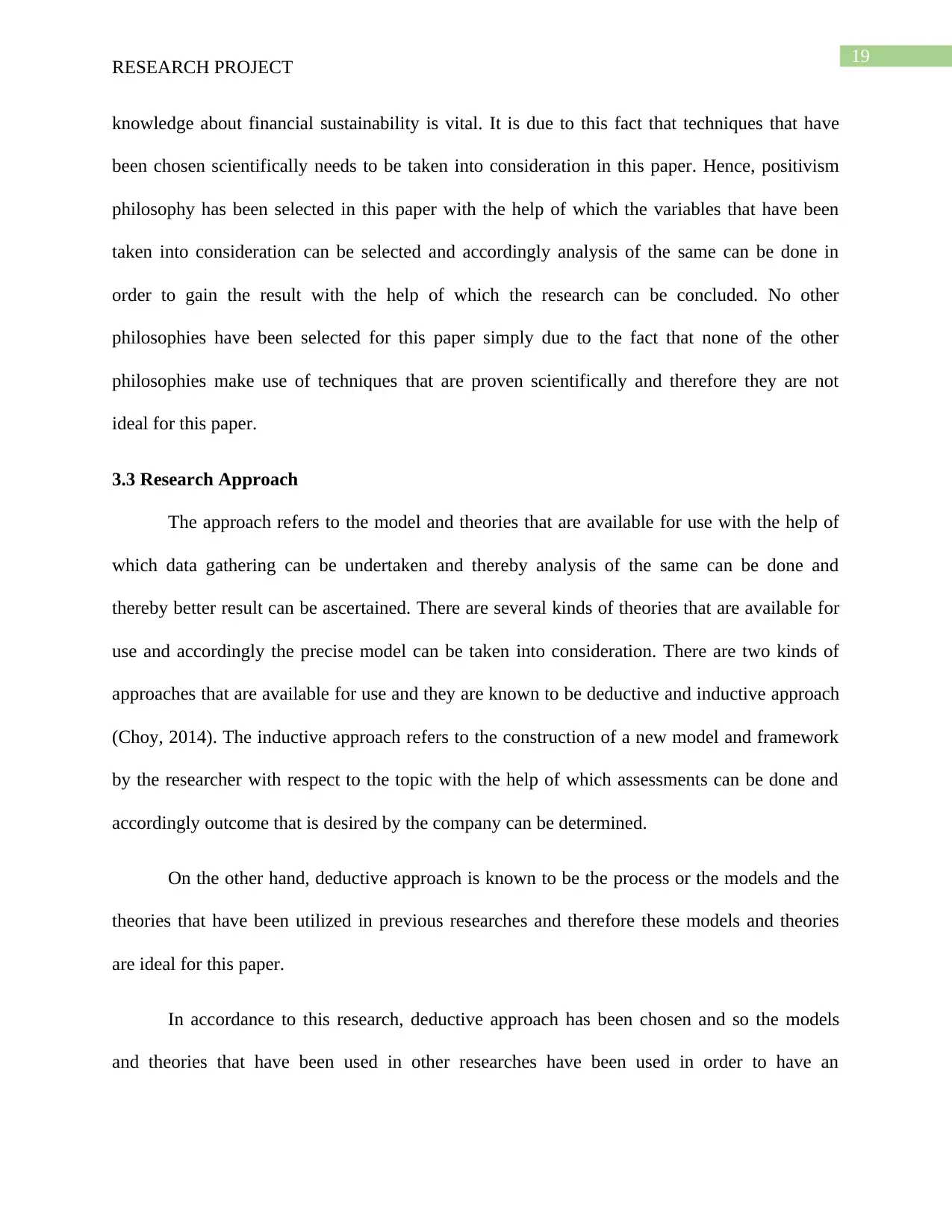
19
RESEARCH PROJECT
knowledge about financial sustainability is vital. It is due to this fact that techniques that have
been chosen scientifically needs to be taken into consideration in this paper. Hence, positivism
philosophy has been selected in this paper with the help of which the variables that have been
taken into consideration can be selected and accordingly analysis of the same can be done in
order to gain the result with the help of which the research can be concluded. No other
philosophies have been selected for this paper simply due to the fact that none of the other
philosophies make use of techniques that are proven scientifically and therefore they are not
ideal for this paper.
3.3 Research Approach
The approach refers to the model and theories that are available for use with the help of
which data gathering can be undertaken and thereby analysis of the same can be done and
thereby better result can be ascertained. There are several kinds of theories that are available for
use and accordingly the precise model can be taken into consideration. There are two kinds of
approaches that are available for use and they are known to be deductive and inductive approach
(Choy, 2014). The inductive approach refers to the construction of a new model and framework
by the researcher with respect to the topic with the help of which assessments can be done and
accordingly outcome that is desired by the company can be determined.
On the other hand, deductive approach is known to be the process or the models and the
theories that have been utilized in previous researches and therefore these models and theories
are ideal for this paper.
In accordance to this research, deductive approach has been chosen and so the models
and theories that have been used in other researches have been used in order to have an
RESEARCH PROJECT
knowledge about financial sustainability is vital. It is due to this fact that techniques that have
been chosen scientifically needs to be taken into consideration in this paper. Hence, positivism
philosophy has been selected in this paper with the help of which the variables that have been
taken into consideration can be selected and accordingly analysis of the same can be done in
order to gain the result with the help of which the research can be concluded. No other
philosophies have been selected for this paper simply due to the fact that none of the other
philosophies make use of techniques that are proven scientifically and therefore they are not
ideal for this paper.
3.3 Research Approach
The approach refers to the model and theories that are available for use with the help of
which data gathering can be undertaken and thereby analysis of the same can be done and
thereby better result can be ascertained. There are several kinds of theories that are available for
use and accordingly the precise model can be taken into consideration. There are two kinds of
approaches that are available for use and they are known to be deductive and inductive approach
(Choy, 2014). The inductive approach refers to the construction of a new model and framework
by the researcher with respect to the topic with the help of which assessments can be done and
accordingly outcome that is desired by the company can be determined.
On the other hand, deductive approach is known to be the process or the models and the
theories that have been utilized in previous researches and therefore these models and theories
are ideal for this paper.
In accordance to this research, deductive approach has been chosen and so the models
and theories that have been used in other researches have been used in order to have an
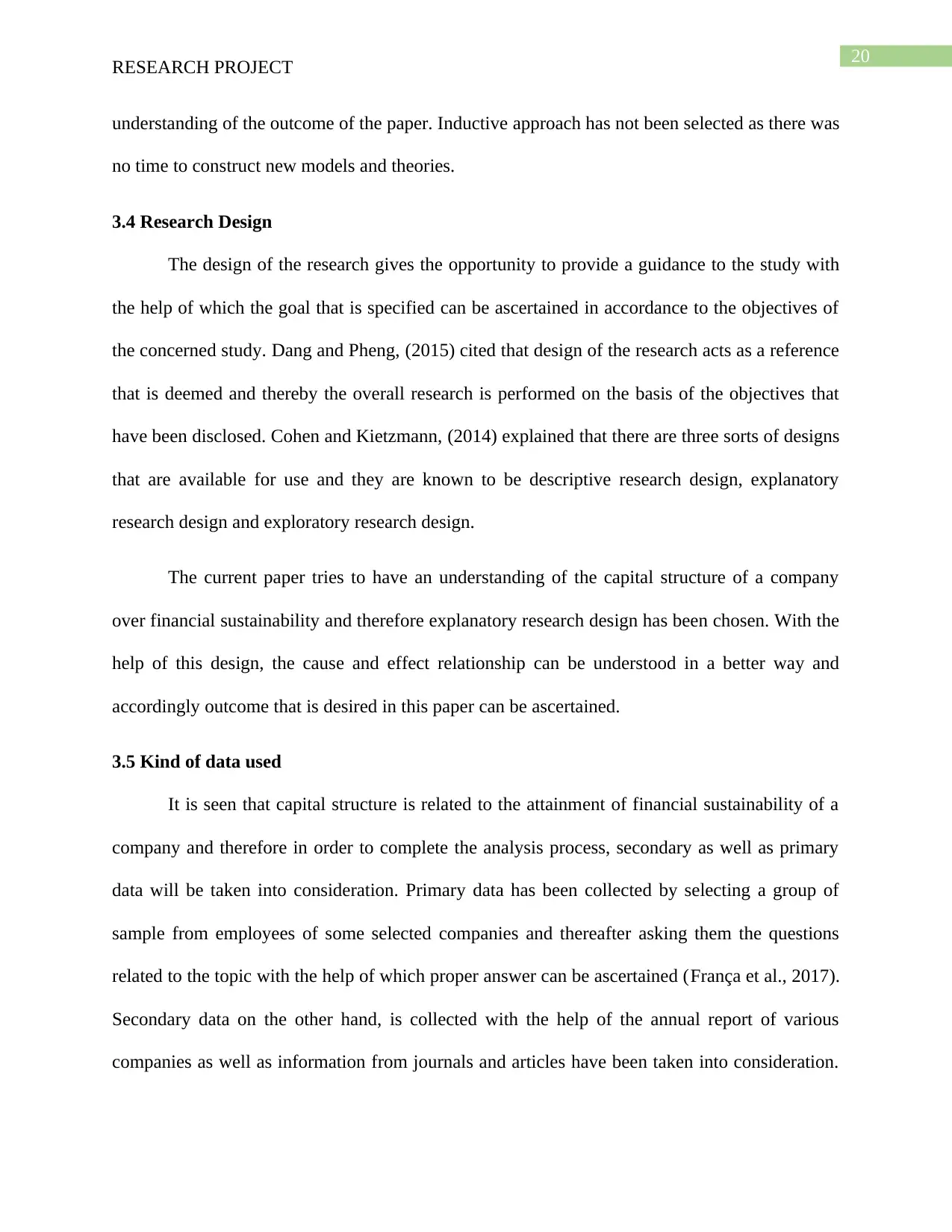
20
RESEARCH PROJECT
understanding of the outcome of the paper. Inductive approach has not been selected as there was
no time to construct new models and theories.
3.4 Research Design
The design of the research gives the opportunity to provide a guidance to the study with
the help of which the goal that is specified can be ascertained in accordance to the objectives of
the concerned study. Dang and Pheng, (2015) cited that design of the research acts as a reference
that is deemed and thereby the overall research is performed on the basis of the objectives that
have been disclosed. Cohen and Kietzmann, (2014) explained that there are three sorts of designs
that are available for use and they are known to be descriptive research design, explanatory
research design and exploratory research design.
The current paper tries to have an understanding of the capital structure of a company
over financial sustainability and therefore explanatory research design has been chosen. With the
help of this design, the cause and effect relationship can be understood in a better way and
accordingly outcome that is desired in this paper can be ascertained.
3.5 Kind of data used
It is seen that capital structure is related to the attainment of financial sustainability of a
company and therefore in order to complete the analysis process, secondary as well as primary
data will be taken into consideration. Primary data has been collected by selecting a group of
sample from employees of some selected companies and thereafter asking them the questions
related to the topic with the help of which proper answer can be ascertained (França et al., 2017).
Secondary data on the other hand, is collected with the help of the annual report of various
companies as well as information from journals and articles have been taken into consideration.
RESEARCH PROJECT
understanding of the outcome of the paper. Inductive approach has not been selected as there was
no time to construct new models and theories.
3.4 Research Design
The design of the research gives the opportunity to provide a guidance to the study with
the help of which the goal that is specified can be ascertained in accordance to the objectives of
the concerned study. Dang and Pheng, (2015) cited that design of the research acts as a reference
that is deemed and thereby the overall research is performed on the basis of the objectives that
have been disclosed. Cohen and Kietzmann, (2014) explained that there are three sorts of designs
that are available for use and they are known to be descriptive research design, explanatory
research design and exploratory research design.
The current paper tries to have an understanding of the capital structure of a company
over financial sustainability and therefore explanatory research design has been chosen. With the
help of this design, the cause and effect relationship can be understood in a better way and
accordingly outcome that is desired in this paper can be ascertained.
3.5 Kind of data used
It is seen that capital structure is related to the attainment of financial sustainability of a
company and therefore in order to complete the analysis process, secondary as well as primary
data will be taken into consideration. Primary data has been collected by selecting a group of
sample from employees of some selected companies and thereafter asking them the questions
related to the topic with the help of which proper answer can be ascertained (França et al., 2017).
Secondary data on the other hand, is collected with the help of the annual report of various
companies as well as information from journals and articles have been taken into consideration.
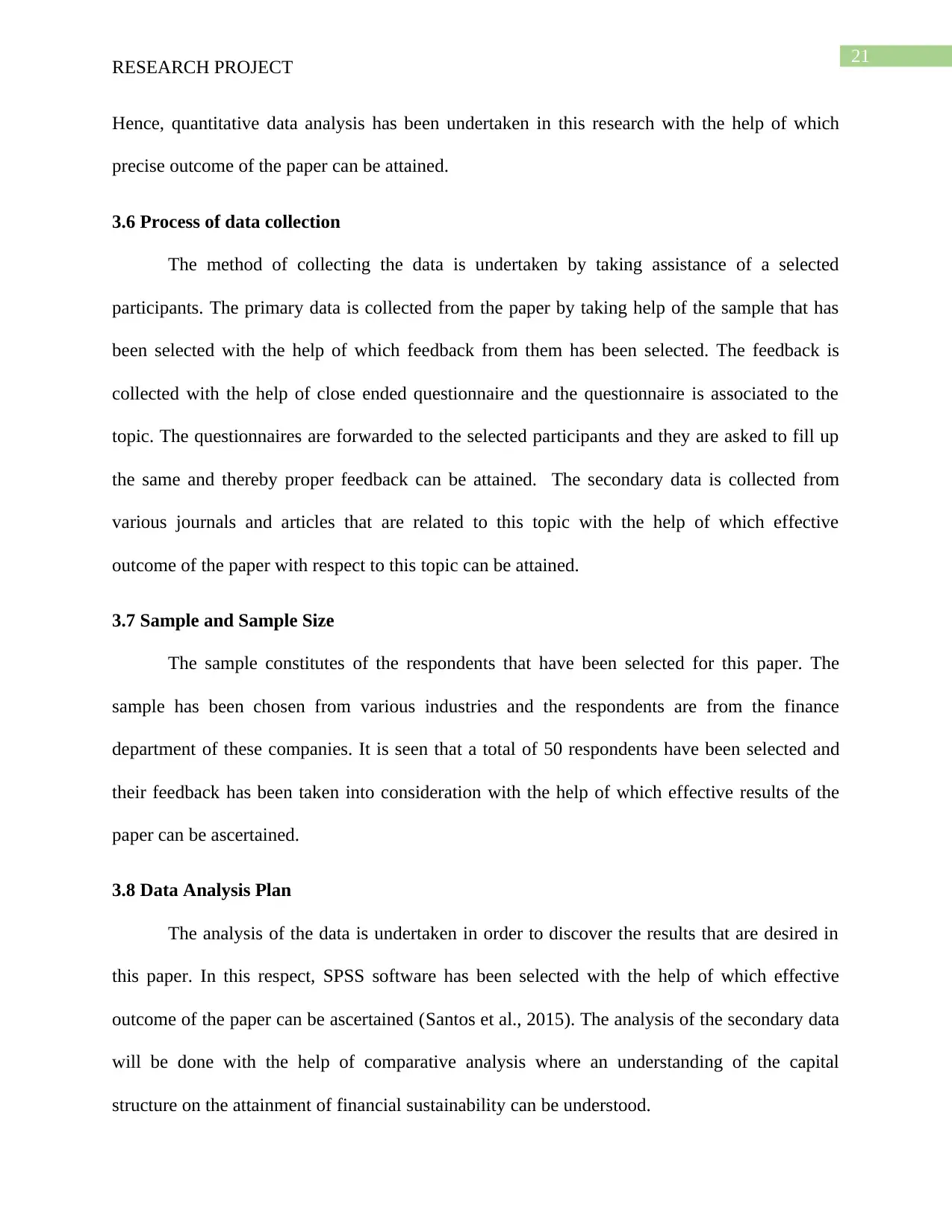
21
RESEARCH PROJECT
Hence, quantitative data analysis has been undertaken in this research with the help of which
precise outcome of the paper can be attained.
3.6 Process of data collection
The method of collecting the data is undertaken by taking assistance of a selected
participants. The primary data is collected from the paper by taking help of the sample that has
been selected with the help of which feedback from them has been selected. The feedback is
collected with the help of close ended questionnaire and the questionnaire is associated to the
topic. The questionnaires are forwarded to the selected participants and they are asked to fill up
the same and thereby proper feedback can be attained. The secondary data is collected from
various journals and articles that are related to this topic with the help of which effective
outcome of the paper with respect to this topic can be attained.
3.7 Sample and Sample Size
The sample constitutes of the respondents that have been selected for this paper. The
sample has been chosen from various industries and the respondents are from the finance
department of these companies. It is seen that a total of 50 respondents have been selected and
their feedback has been taken into consideration with the help of which effective results of the
paper can be ascertained.
3.8 Data Analysis Plan
The analysis of the data is undertaken in order to discover the results that are desired in
this paper. In this respect, SPSS software has been selected with the help of which effective
outcome of the paper can be ascertained (Santos et al., 2015). The analysis of the secondary data
will be done with the help of comparative analysis where an understanding of the capital
structure on the attainment of financial sustainability can be understood.
RESEARCH PROJECT
Hence, quantitative data analysis has been undertaken in this research with the help of which
precise outcome of the paper can be attained.
3.6 Process of data collection
The method of collecting the data is undertaken by taking assistance of a selected
participants. The primary data is collected from the paper by taking help of the sample that has
been selected with the help of which feedback from them has been selected. The feedback is
collected with the help of close ended questionnaire and the questionnaire is associated to the
topic. The questionnaires are forwarded to the selected participants and they are asked to fill up
the same and thereby proper feedback can be attained. The secondary data is collected from
various journals and articles that are related to this topic with the help of which effective
outcome of the paper with respect to this topic can be attained.
3.7 Sample and Sample Size
The sample constitutes of the respondents that have been selected for this paper. The
sample has been chosen from various industries and the respondents are from the finance
department of these companies. It is seen that a total of 50 respondents have been selected and
their feedback has been taken into consideration with the help of which effective results of the
paper can be ascertained.
3.8 Data Analysis Plan
The analysis of the data is undertaken in order to discover the results that are desired in
this paper. In this respect, SPSS software has been selected with the help of which effective
outcome of the paper can be ascertained (Santos et al., 2015). The analysis of the secondary data
will be done with the help of comparative analysis where an understanding of the capital
structure on the attainment of financial sustainability can be understood.
Secure Best Marks with AI Grader
Need help grading? Try our AI Grader for instant feedback on your assignments.
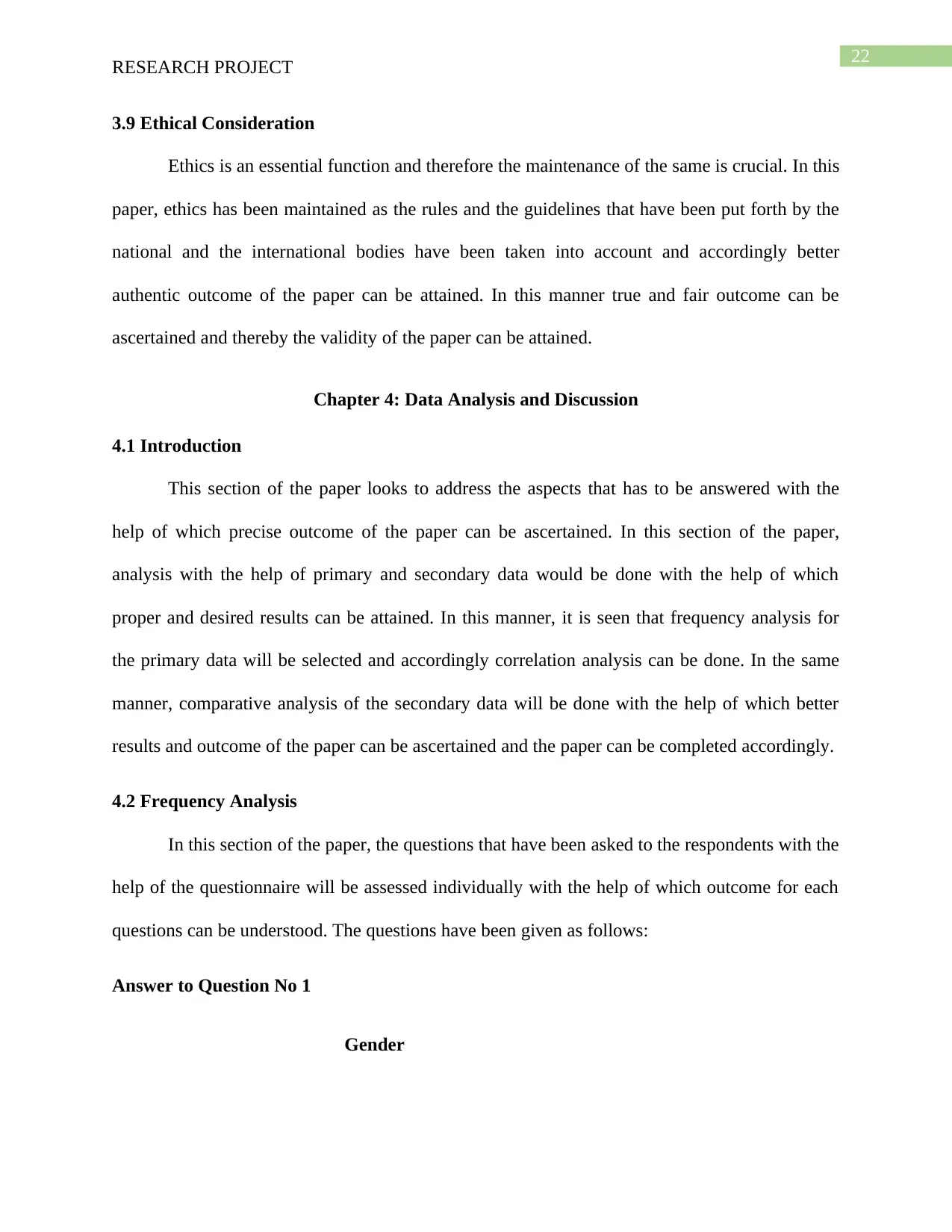
22
RESEARCH PROJECT
3.9 Ethical Consideration
Ethics is an essential function and therefore the maintenance of the same is crucial. In this
paper, ethics has been maintained as the rules and the guidelines that have been put forth by the
national and the international bodies have been taken into account and accordingly better
authentic outcome of the paper can be attained. In this manner true and fair outcome can be
ascertained and thereby the validity of the paper can be attained.
Chapter 4: Data Analysis and Discussion
4.1 Introduction
This section of the paper looks to address the aspects that has to be answered with the
help of which precise outcome of the paper can be ascertained. In this section of the paper,
analysis with the help of primary and secondary data would be done with the help of which
proper and desired results can be attained. In this manner, it is seen that frequency analysis for
the primary data will be selected and accordingly correlation analysis can be done. In the same
manner, comparative analysis of the secondary data will be done with the help of which better
results and outcome of the paper can be ascertained and the paper can be completed accordingly.
4.2 Frequency Analysis
In this section of the paper, the questions that have been asked to the respondents with the
help of the questionnaire will be assessed individually with the help of which outcome for each
questions can be understood. The questions have been given as follows:
Answer to Question No 1
Gender
RESEARCH PROJECT
3.9 Ethical Consideration
Ethics is an essential function and therefore the maintenance of the same is crucial. In this
paper, ethics has been maintained as the rules and the guidelines that have been put forth by the
national and the international bodies have been taken into account and accordingly better
authentic outcome of the paper can be attained. In this manner true and fair outcome can be
ascertained and thereby the validity of the paper can be attained.
Chapter 4: Data Analysis and Discussion
4.1 Introduction
This section of the paper looks to address the aspects that has to be answered with the
help of which precise outcome of the paper can be ascertained. In this section of the paper,
analysis with the help of primary and secondary data would be done with the help of which
proper and desired results can be attained. In this manner, it is seen that frequency analysis for
the primary data will be selected and accordingly correlation analysis can be done. In the same
manner, comparative analysis of the secondary data will be done with the help of which better
results and outcome of the paper can be ascertained and the paper can be completed accordingly.
4.2 Frequency Analysis
In this section of the paper, the questions that have been asked to the respondents with the
help of the questionnaire will be assessed individually with the help of which outcome for each
questions can be understood. The questions have been given as follows:
Answer to Question No 1
Gender
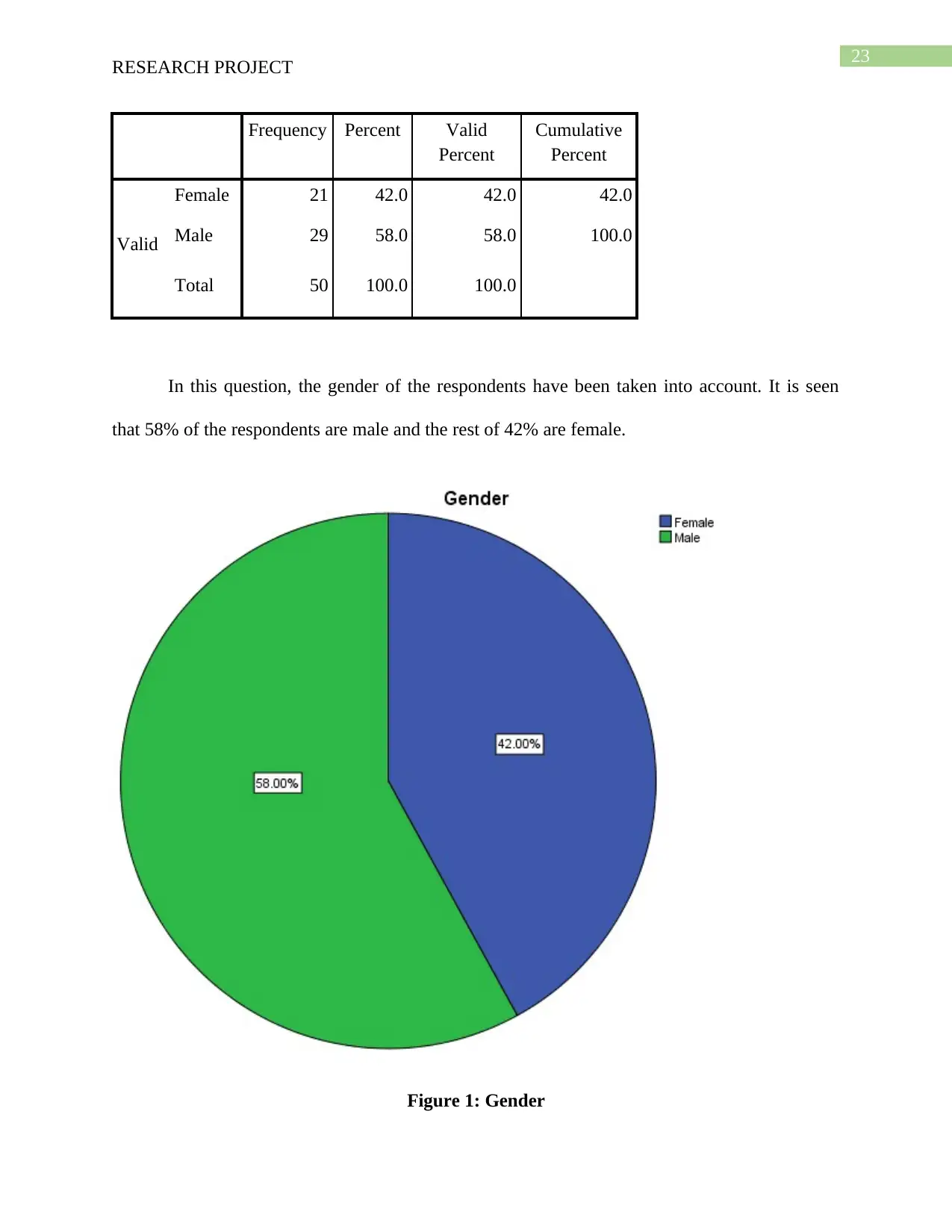
23
RESEARCH PROJECT
Frequency Percent Valid
Percent
Cumulative
Percent
Valid
Female 21 42.0 42.0 42.0
Male 29 58.0 58.0 100.0
Total 50 100.0 100.0
In this question, the gender of the respondents have been taken into account. It is seen
that 58% of the respondents are male and the rest of 42% are female.
Figure 1: Gender
RESEARCH PROJECT
Frequency Percent Valid
Percent
Cumulative
Percent
Valid
Female 21 42.0 42.0 42.0
Male 29 58.0 58.0 100.0
Total 50 100.0 100.0
In this question, the gender of the respondents have been taken into account. It is seen
that 58% of the respondents are male and the rest of 42% are female.
Figure 1: Gender

24
RESEARCH PROJECT
(Source: As Created by the Author)
Answer to Question No 2
Age Group
Frequency Percent Valid
Percent
Cumulative
Percent
Valid
18-25 years 5 10.0 10.0 10.0
26-35 years 11 22.0 22.0 32.0
36-45 years 13 26.0 26.0 58.0
46-55 years 16 32.0 32.0 90.0
56 years and
above 5 10.0 10.0 100.0
Total 50 100.0 100.0
The next question that will be explained has been getting to know the age group of the
respondents. It is seen that 32% are within the age group of 46-55 years and 26% are within the
age group of 36-45 years. It is seen that 22% are within the age group of 26-35 years and 10%
are within the age group of 18-25 years. It is seen that the rest of the respondents comprising of
10% are within the age group of 56 years and above. It is therefore seen that most of the
respondents are middle aged who have been selected as the respondents for this research.
RESEARCH PROJECT
(Source: As Created by the Author)
Answer to Question No 2
Age Group
Frequency Percent Valid
Percent
Cumulative
Percent
Valid
18-25 years 5 10.0 10.0 10.0
26-35 years 11 22.0 22.0 32.0
36-45 years 13 26.0 26.0 58.0
46-55 years 16 32.0 32.0 90.0
56 years and
above 5 10.0 10.0 100.0
Total 50 100.0 100.0
The next question that will be explained has been getting to know the age group of the
respondents. It is seen that 32% are within the age group of 46-55 years and 26% are within the
age group of 36-45 years. It is seen that 22% are within the age group of 26-35 years and 10%
are within the age group of 18-25 years. It is seen that the rest of the respondents comprising of
10% are within the age group of 56 years and above. It is therefore seen that most of the
respondents are middle aged who have been selected as the respondents for this research.
Paraphrase This Document
Need a fresh take? Get an instant paraphrase of this document with our AI Paraphraser
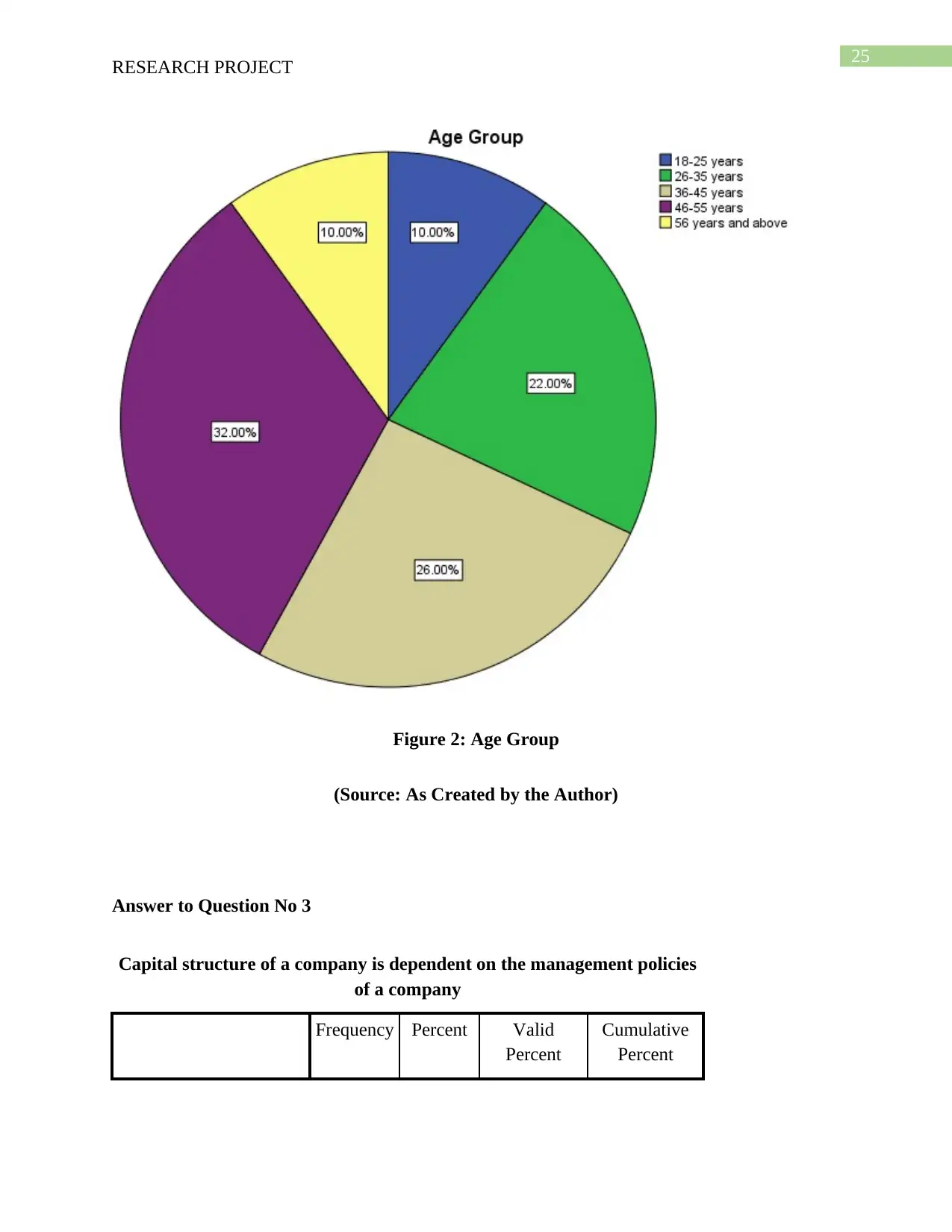
25
RESEARCH PROJECT
Figure 2: Age Group
(Source: As Created by the Author)
Answer to Question No 3
Capital structure of a company is dependent on the management policies
of a company
Frequency Percent Valid
Percent
Cumulative
Percent
RESEARCH PROJECT
Figure 2: Age Group
(Source: As Created by the Author)
Answer to Question No 3
Capital structure of a company is dependent on the management policies
of a company
Frequency Percent Valid
Percent
Cumulative
Percent
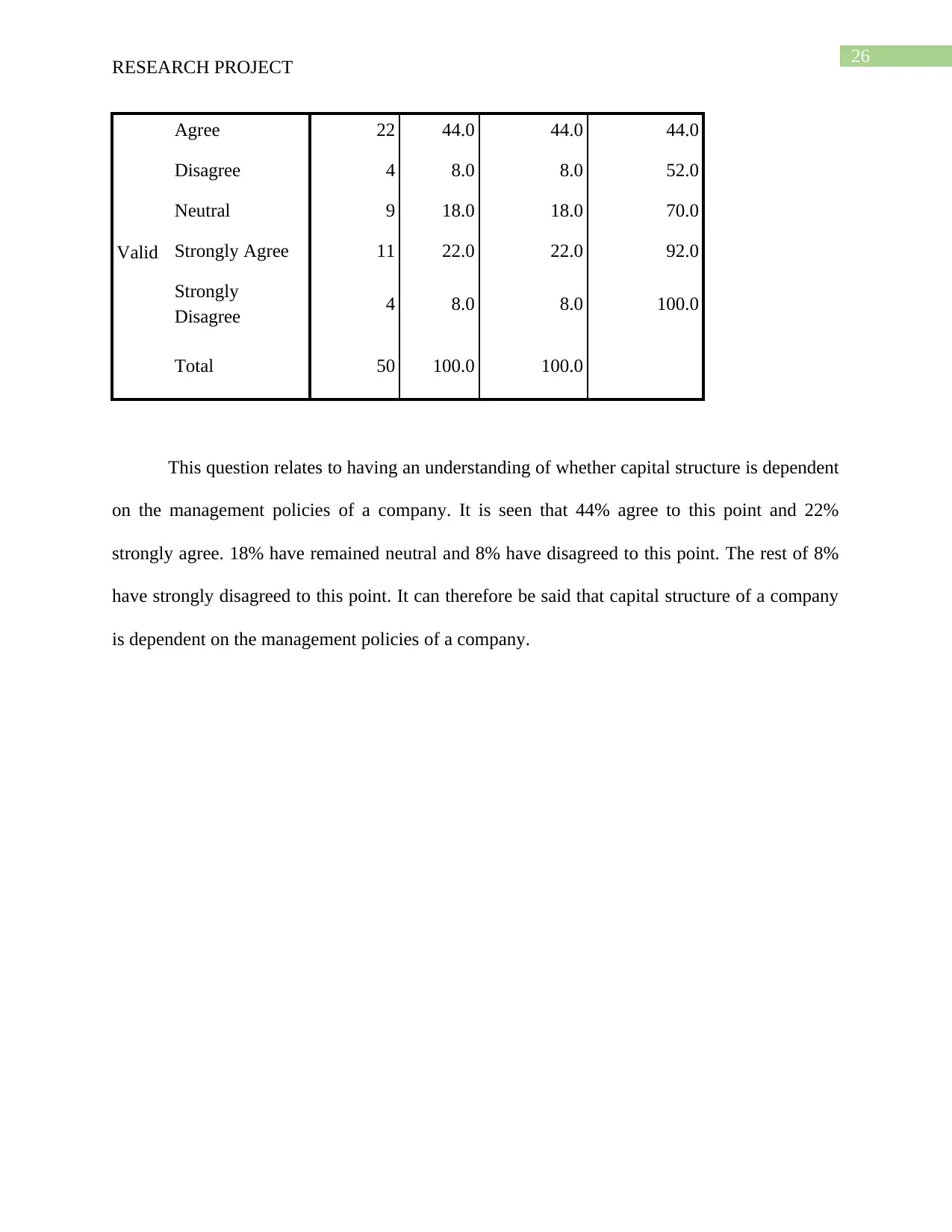
26
RESEARCH PROJECT
Valid
Agree 22 44.0 44.0 44.0
Disagree 4 8.0 8.0 52.0
Neutral 9 18.0 18.0 70.0
Strongly Agree 11 22.0 22.0 92.0
Strongly
Disagree 4 8.0 8.0 100.0
Total 50 100.0 100.0
This question relates to having an understanding of whether capital structure is dependent
on the management policies of a company. It is seen that 44% agree to this point and 22%
strongly agree. 18% have remained neutral and 8% have disagreed to this point. The rest of 8%
have strongly disagreed to this point. It can therefore be said that capital structure of a company
is dependent on the management policies of a company.
RESEARCH PROJECT
Valid
Agree 22 44.0 44.0 44.0
Disagree 4 8.0 8.0 52.0
Neutral 9 18.0 18.0 70.0
Strongly Agree 11 22.0 22.0 92.0
Strongly
Disagree 4 8.0 8.0 100.0
Total 50 100.0 100.0
This question relates to having an understanding of whether capital structure is dependent
on the management policies of a company. It is seen that 44% agree to this point and 22%
strongly agree. 18% have remained neutral and 8% have disagreed to this point. The rest of 8%
have strongly disagreed to this point. It can therefore be said that capital structure of a company
is dependent on the management policies of a company.
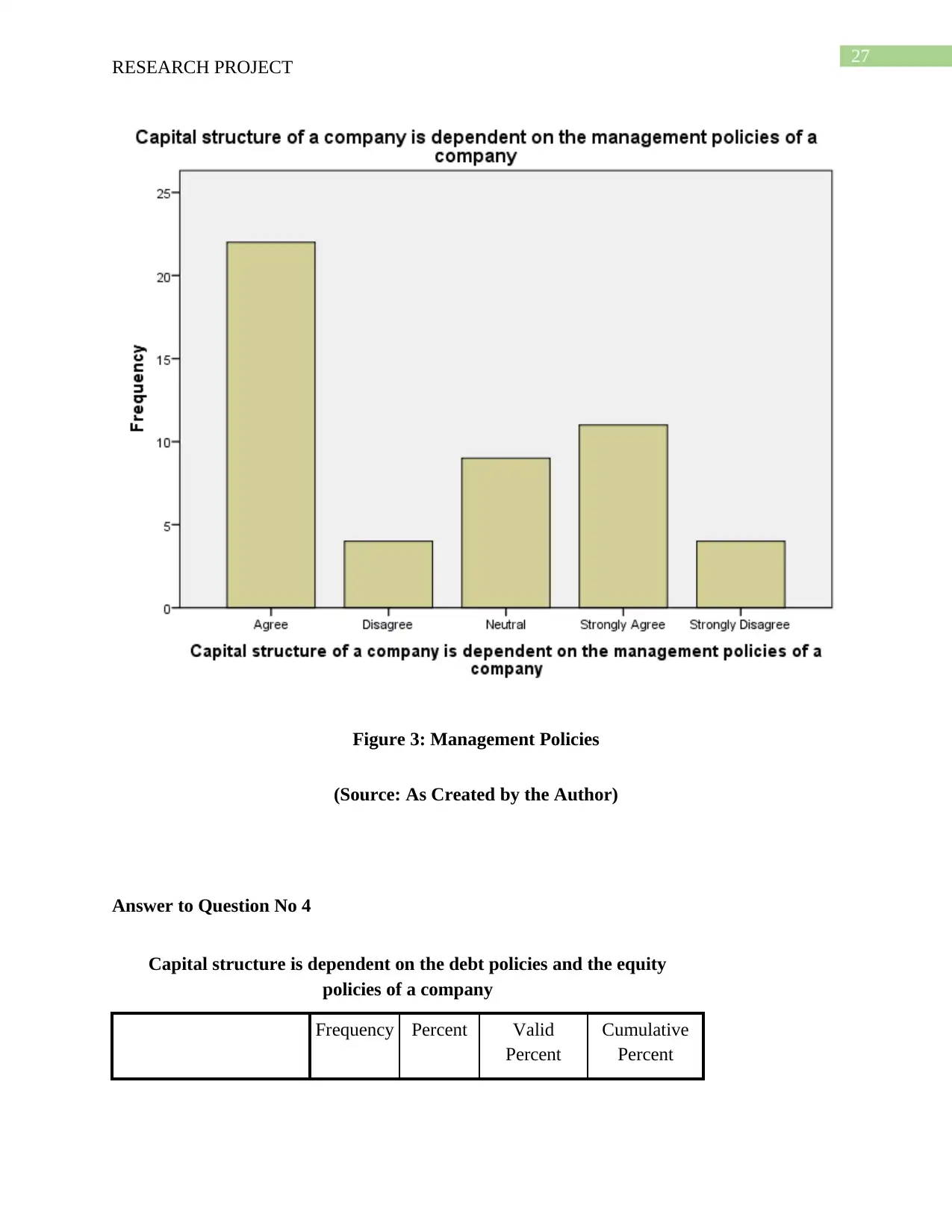
27
RESEARCH PROJECT
Figure 3: Management Policies
(Source: As Created by the Author)
Answer to Question No 4
Capital structure is dependent on the debt policies and the equity
policies of a company
Frequency Percent Valid
Percent
Cumulative
Percent
RESEARCH PROJECT
Figure 3: Management Policies
(Source: As Created by the Author)
Answer to Question No 4
Capital structure is dependent on the debt policies and the equity
policies of a company
Frequency Percent Valid
Percent
Cumulative
Percent
Secure Best Marks with AI Grader
Need help grading? Try our AI Grader for instant feedback on your assignments.
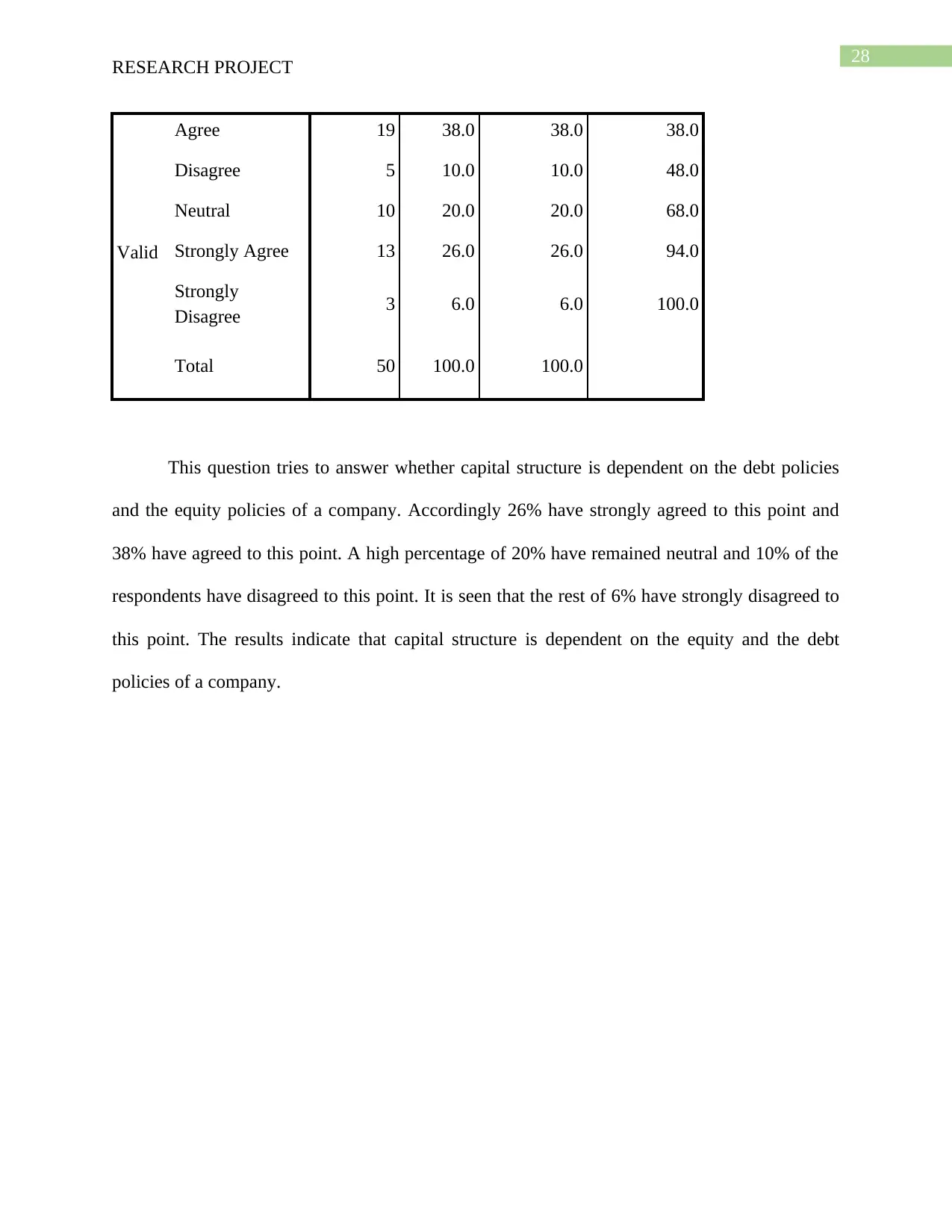
28
RESEARCH PROJECT
Valid
Agree 19 38.0 38.0 38.0
Disagree 5 10.0 10.0 48.0
Neutral 10 20.0 20.0 68.0
Strongly Agree 13 26.0 26.0 94.0
Strongly
Disagree 3 6.0 6.0 100.0
Total 50 100.0 100.0
This question tries to answer whether capital structure is dependent on the debt policies
and the equity policies of a company. Accordingly 26% have strongly agreed to this point and
38% have agreed to this point. A high percentage of 20% have remained neutral and 10% of the
respondents have disagreed to this point. It is seen that the rest of 6% have strongly disagreed to
this point. The results indicate that capital structure is dependent on the equity and the debt
policies of a company.
RESEARCH PROJECT
Valid
Agree 19 38.0 38.0 38.0
Disagree 5 10.0 10.0 48.0
Neutral 10 20.0 20.0 68.0
Strongly Agree 13 26.0 26.0 94.0
Strongly
Disagree 3 6.0 6.0 100.0
Total 50 100.0 100.0
This question tries to answer whether capital structure is dependent on the debt policies
and the equity policies of a company. Accordingly 26% have strongly agreed to this point and
38% have agreed to this point. A high percentage of 20% have remained neutral and 10% of the
respondents have disagreed to this point. It is seen that the rest of 6% have strongly disagreed to
this point. The results indicate that capital structure is dependent on the equity and the debt
policies of a company.
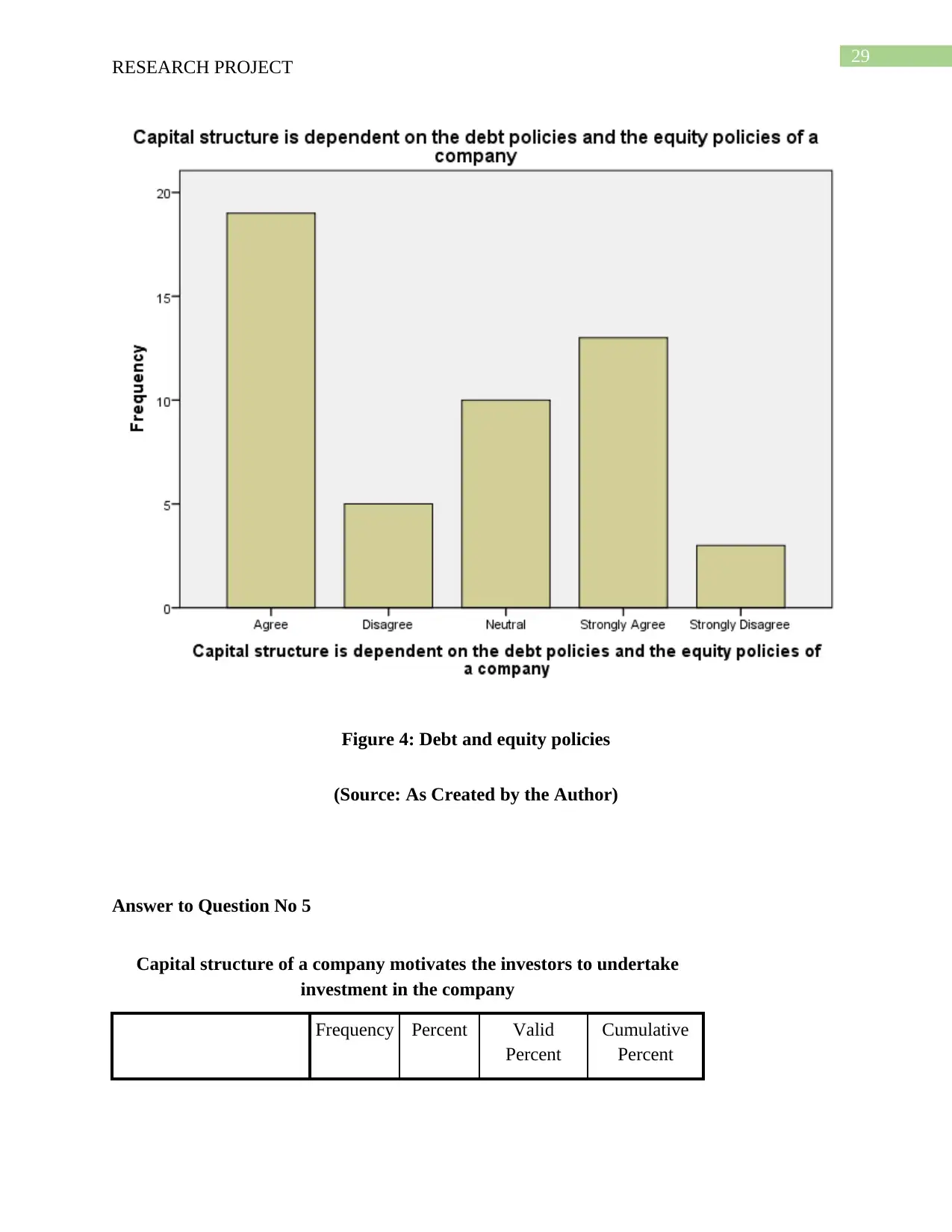
29
RESEARCH PROJECT
Figure 4: Debt and equity policies
(Source: As Created by the Author)
Answer to Question No 5
Capital structure of a company motivates the investors to undertake
investment in the company
Frequency Percent Valid
Percent
Cumulative
Percent
RESEARCH PROJECT
Figure 4: Debt and equity policies
(Source: As Created by the Author)
Answer to Question No 5
Capital structure of a company motivates the investors to undertake
investment in the company
Frequency Percent Valid
Percent
Cumulative
Percent
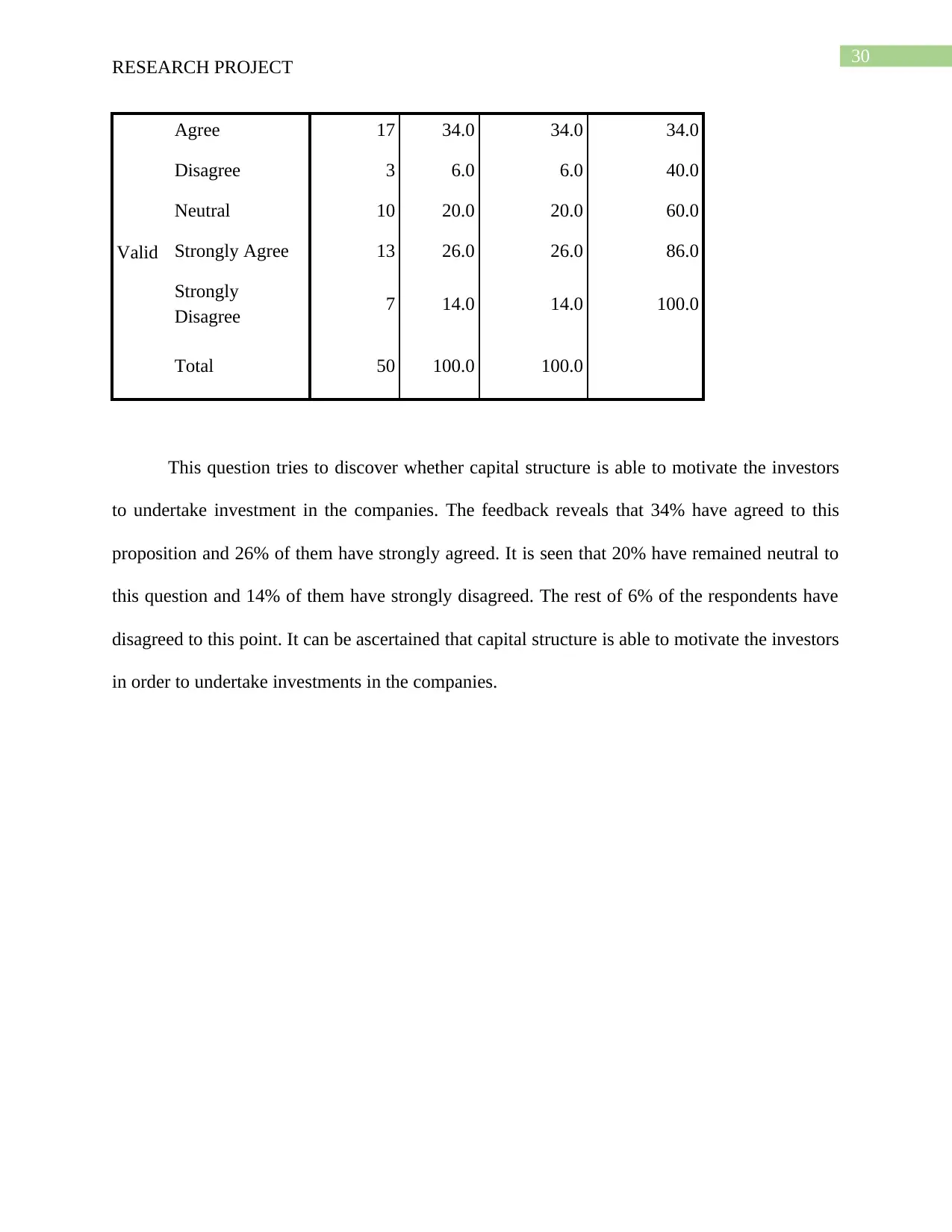
30
RESEARCH PROJECT
Valid
Agree 17 34.0 34.0 34.0
Disagree 3 6.0 6.0 40.0
Neutral 10 20.0 20.0 60.0
Strongly Agree 13 26.0 26.0 86.0
Strongly
Disagree 7 14.0 14.0 100.0
Total 50 100.0 100.0
This question tries to discover whether capital structure is able to motivate the investors
to undertake investment in the companies. The feedback reveals that 34% have agreed to this
proposition and 26% of them have strongly agreed. It is seen that 20% have remained neutral to
this question and 14% of them have strongly disagreed. The rest of 6% of the respondents have
disagreed to this point. It can be ascertained that capital structure is able to motivate the investors
in order to undertake investments in the companies.
RESEARCH PROJECT
Valid
Agree 17 34.0 34.0 34.0
Disagree 3 6.0 6.0 40.0
Neutral 10 20.0 20.0 60.0
Strongly Agree 13 26.0 26.0 86.0
Strongly
Disagree 7 14.0 14.0 100.0
Total 50 100.0 100.0
This question tries to discover whether capital structure is able to motivate the investors
to undertake investment in the companies. The feedback reveals that 34% have agreed to this
proposition and 26% of them have strongly agreed. It is seen that 20% have remained neutral to
this question and 14% of them have strongly disagreed. The rest of 6% of the respondents have
disagreed to this point. It can be ascertained that capital structure is able to motivate the investors
in order to undertake investments in the companies.
Paraphrase This Document
Need a fresh take? Get an instant paraphrase of this document with our AI Paraphraser
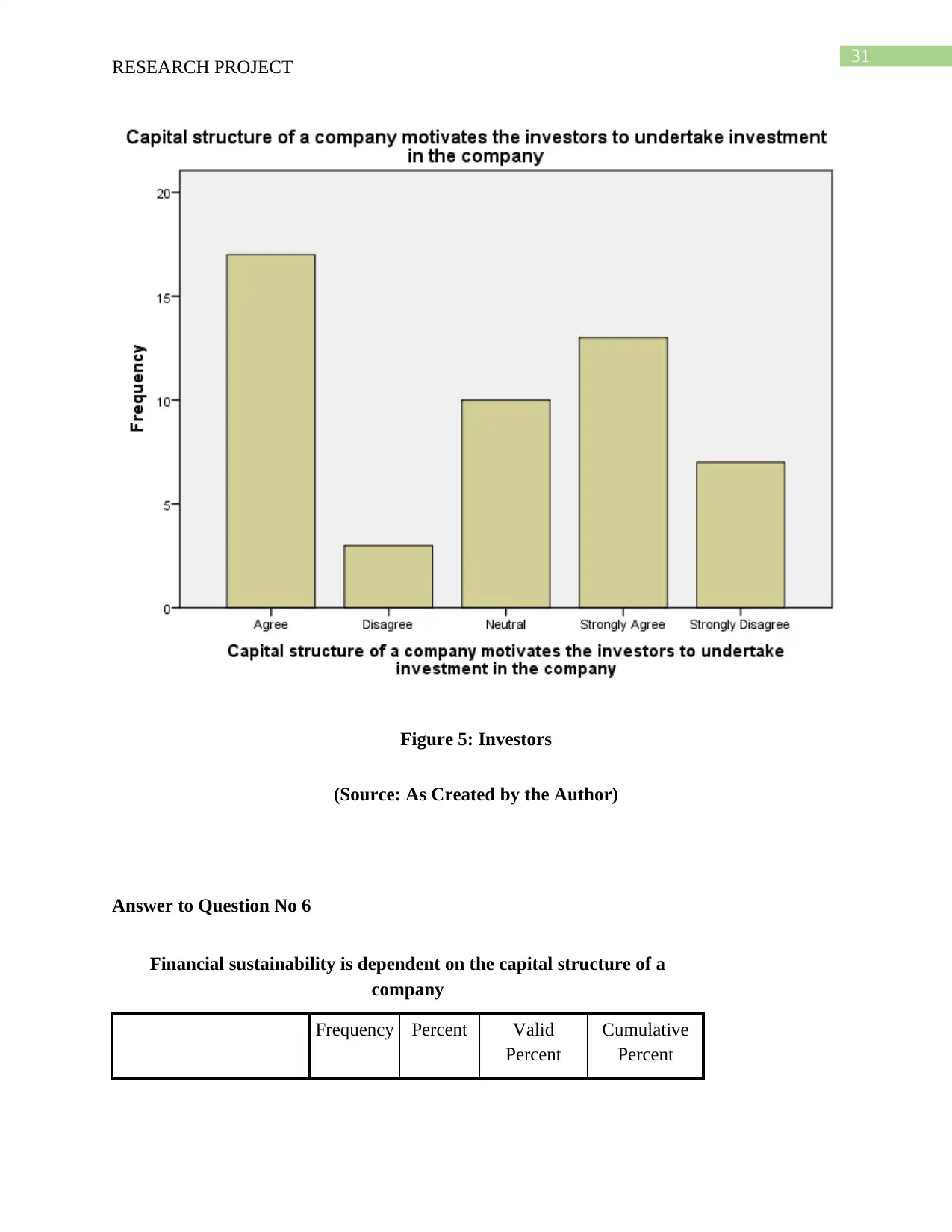
31
RESEARCH PROJECT
Figure 5: Investors
(Source: As Created by the Author)
Answer to Question No 6
Financial sustainability is dependent on the capital structure of a
company
Frequency Percent Valid
Percent
Cumulative
Percent
RESEARCH PROJECT
Figure 5: Investors
(Source: As Created by the Author)
Answer to Question No 6
Financial sustainability is dependent on the capital structure of a
company
Frequency Percent Valid
Percent
Cumulative
Percent
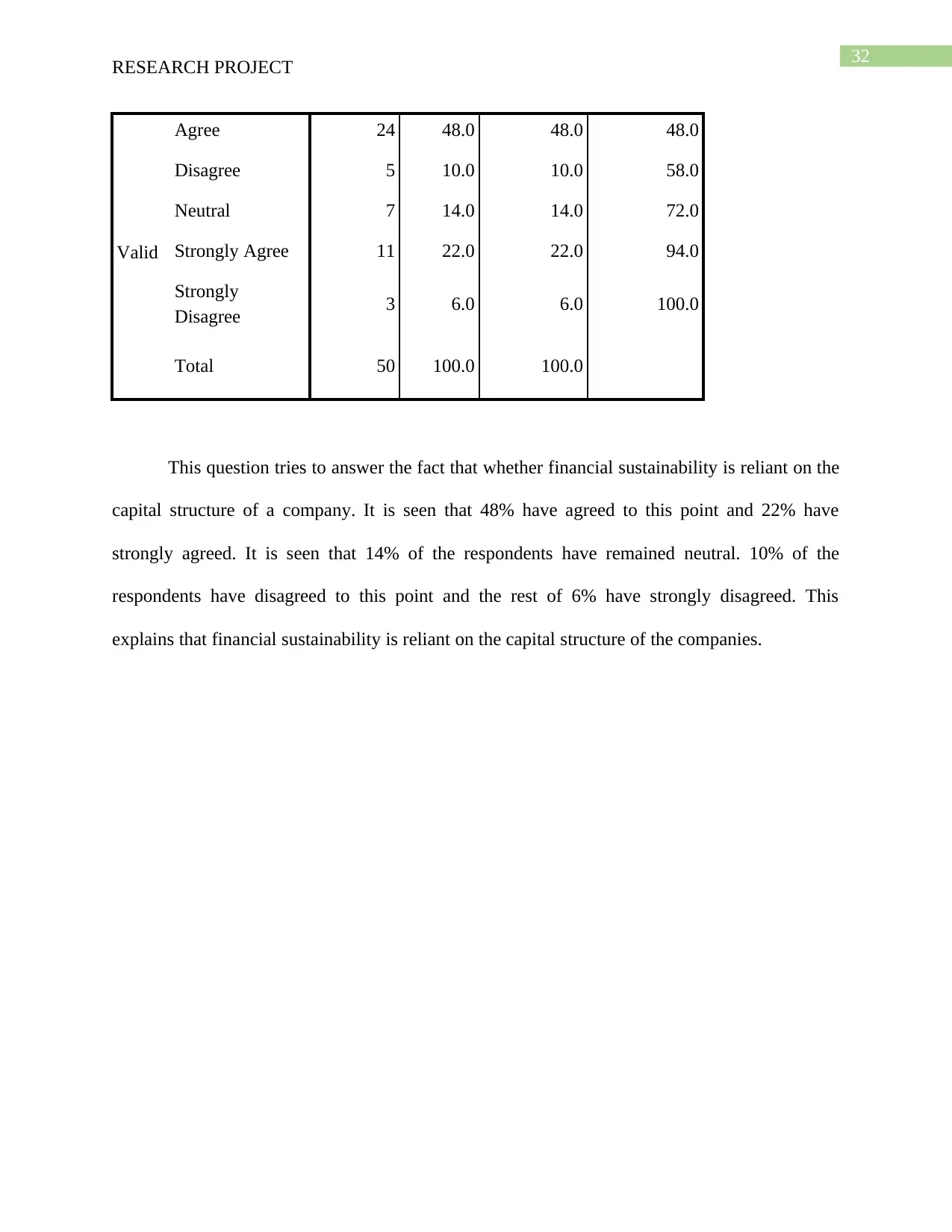
32
RESEARCH PROJECT
Valid
Agree 24 48.0 48.0 48.0
Disagree 5 10.0 10.0 58.0
Neutral 7 14.0 14.0 72.0
Strongly Agree 11 22.0 22.0 94.0
Strongly
Disagree 3 6.0 6.0 100.0
Total 50 100.0 100.0
This question tries to answer the fact that whether financial sustainability is reliant on the
capital structure of a company. It is seen that 48% have agreed to this point and 22% have
strongly agreed. It is seen that 14% of the respondents have remained neutral. 10% of the
respondents have disagreed to this point and the rest of 6% have strongly disagreed. This
explains that financial sustainability is reliant on the capital structure of the companies.
RESEARCH PROJECT
Valid
Agree 24 48.0 48.0 48.0
Disagree 5 10.0 10.0 58.0
Neutral 7 14.0 14.0 72.0
Strongly Agree 11 22.0 22.0 94.0
Strongly
Disagree 3 6.0 6.0 100.0
Total 50 100.0 100.0
This question tries to answer the fact that whether financial sustainability is reliant on the
capital structure of a company. It is seen that 48% have agreed to this point and 22% have
strongly agreed. It is seen that 14% of the respondents have remained neutral. 10% of the
respondents have disagreed to this point and the rest of 6% have strongly disagreed. This
explains that financial sustainability is reliant on the capital structure of the companies.
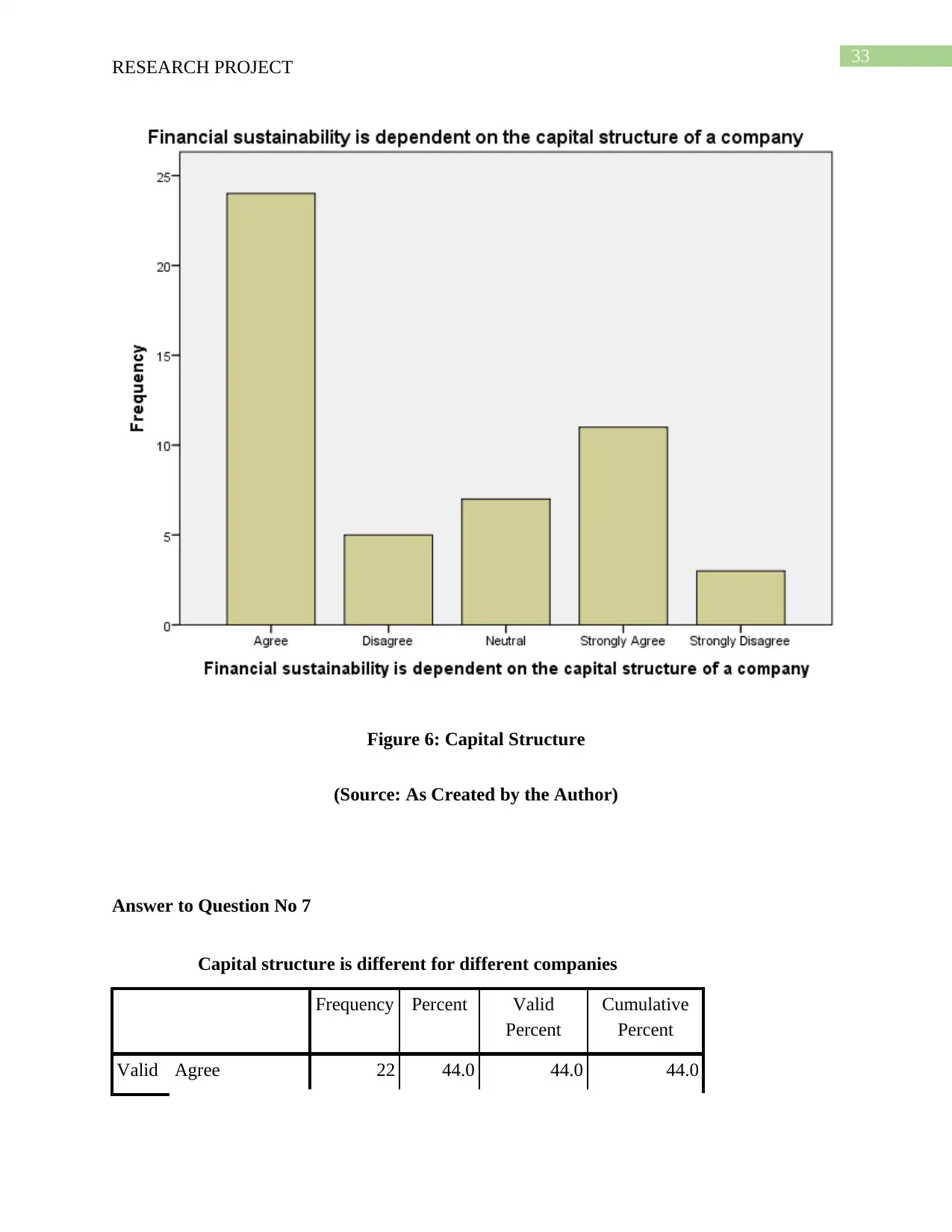
33
RESEARCH PROJECT
Figure 6: Capital Structure
(Source: As Created by the Author)
Answer to Question No 7
Capital structure is different for different companies
Frequency Percent Valid
Percent
Cumulative
Percent
Valid Agree 22 44.0 44.0 44.0
RESEARCH PROJECT
Figure 6: Capital Structure
(Source: As Created by the Author)
Answer to Question No 7
Capital structure is different for different companies
Frequency Percent Valid
Percent
Cumulative
Percent
Valid Agree 22 44.0 44.0 44.0
Secure Best Marks with AI Grader
Need help grading? Try our AI Grader for instant feedback on your assignments.
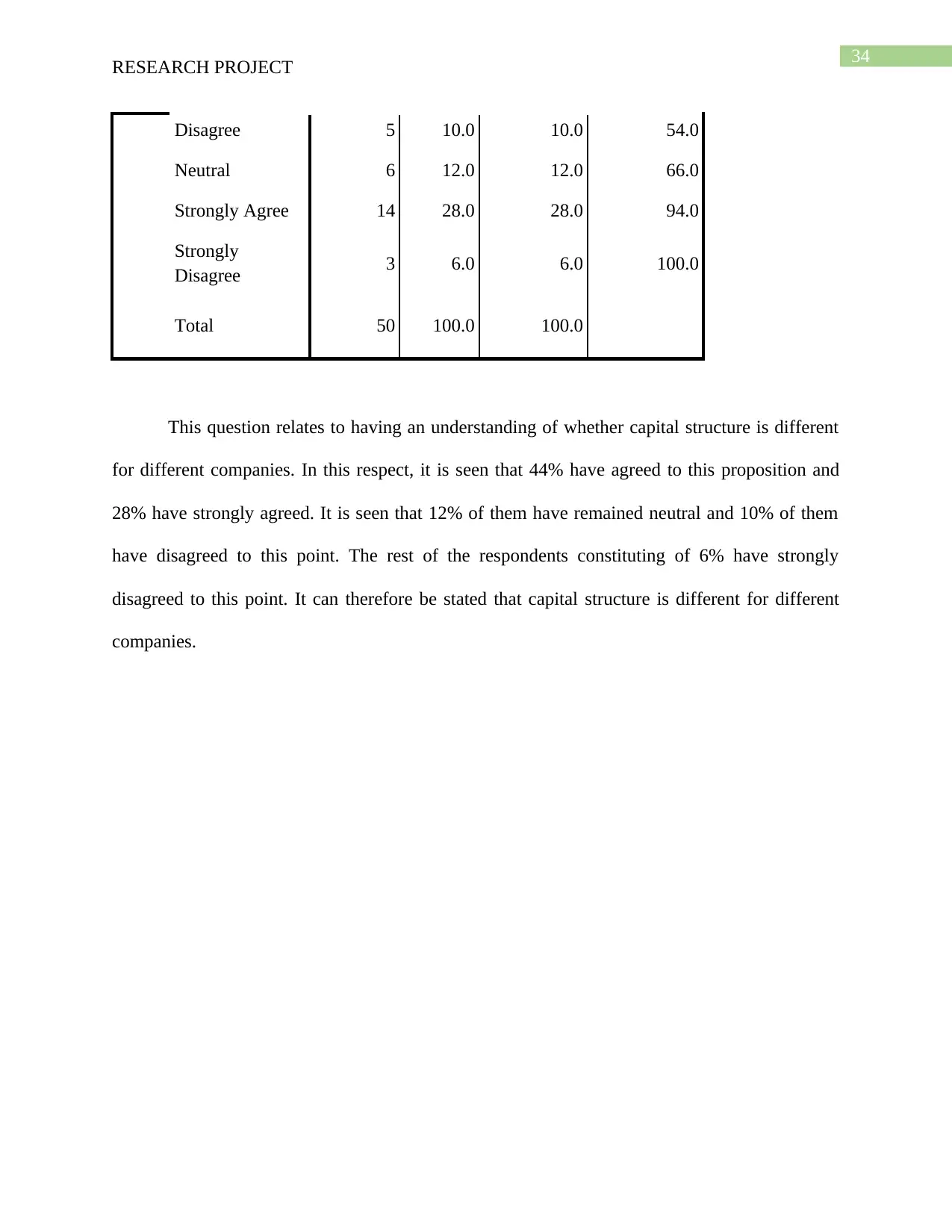
34
RESEARCH PROJECT
Disagree 5 10.0 10.0 54.0
Neutral 6 12.0 12.0 66.0
Strongly Agree 14 28.0 28.0 94.0
Strongly
Disagree 3 6.0 6.0 100.0
Total 50 100.0 100.0
This question relates to having an understanding of whether capital structure is different
for different companies. In this respect, it is seen that 44% have agreed to this proposition and
28% have strongly agreed. It is seen that 12% of them have remained neutral and 10% of them
have disagreed to this point. The rest of the respondents constituting of 6% have strongly
disagreed to this point. It can therefore be stated that capital structure is different for different
companies.
RESEARCH PROJECT
Disagree 5 10.0 10.0 54.0
Neutral 6 12.0 12.0 66.0
Strongly Agree 14 28.0 28.0 94.0
Strongly
Disagree 3 6.0 6.0 100.0
Total 50 100.0 100.0
This question relates to having an understanding of whether capital structure is different
for different companies. In this respect, it is seen that 44% have agreed to this proposition and
28% have strongly agreed. It is seen that 12% of them have remained neutral and 10% of them
have disagreed to this point. The rest of the respondents constituting of 6% have strongly
disagreed to this point. It can therefore be stated that capital structure is different for different
companies.
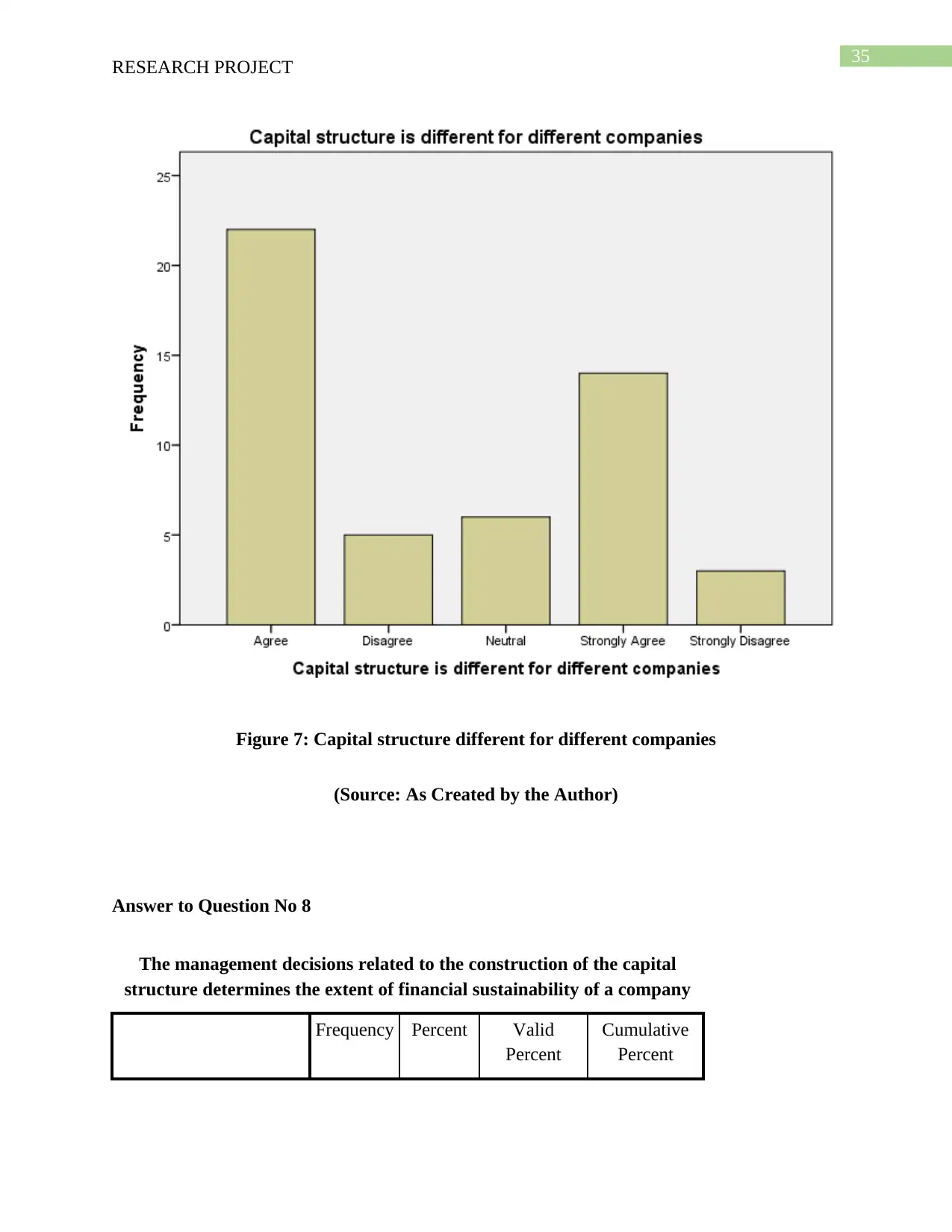
35
RESEARCH PROJECT
Figure 7: Capital structure different for different companies
(Source: As Created by the Author)
Answer to Question No 8
The management decisions related to the construction of the capital
structure determines the extent of financial sustainability of a company
Frequency Percent Valid
Percent
Cumulative
Percent
RESEARCH PROJECT
Figure 7: Capital structure different for different companies
(Source: As Created by the Author)
Answer to Question No 8
The management decisions related to the construction of the capital
structure determines the extent of financial sustainability of a company
Frequency Percent Valid
Percent
Cumulative
Percent
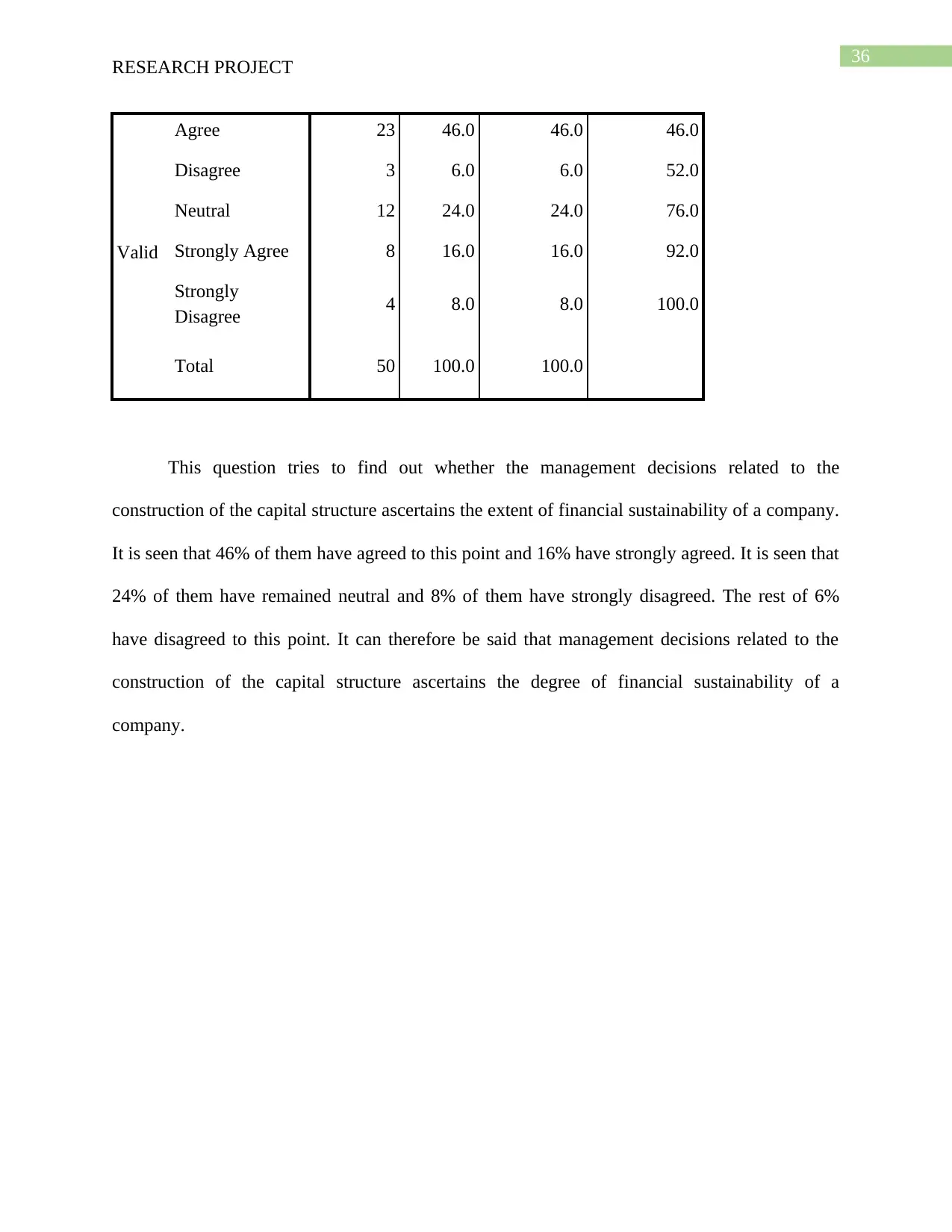
36
RESEARCH PROJECT
Valid
Agree 23 46.0 46.0 46.0
Disagree 3 6.0 6.0 52.0
Neutral 12 24.0 24.0 76.0
Strongly Agree 8 16.0 16.0 92.0
Strongly
Disagree 4 8.0 8.0 100.0
Total 50 100.0 100.0
This question tries to find out whether the management decisions related to the
construction of the capital structure ascertains the extent of financial sustainability of a company.
It is seen that 46% of them have agreed to this point and 16% have strongly agreed. It is seen that
24% of them have remained neutral and 8% of them have strongly disagreed. The rest of 6%
have disagreed to this point. It can therefore be said that management decisions related to the
construction of the capital structure ascertains the degree of financial sustainability of a
company.
RESEARCH PROJECT
Valid
Agree 23 46.0 46.0 46.0
Disagree 3 6.0 6.0 52.0
Neutral 12 24.0 24.0 76.0
Strongly Agree 8 16.0 16.0 92.0
Strongly
Disagree 4 8.0 8.0 100.0
Total 50 100.0 100.0
This question tries to find out whether the management decisions related to the
construction of the capital structure ascertains the extent of financial sustainability of a company.
It is seen that 46% of them have agreed to this point and 16% have strongly agreed. It is seen that
24% of them have remained neutral and 8% of them have strongly disagreed. The rest of 6%
have disagreed to this point. It can therefore be said that management decisions related to the
construction of the capital structure ascertains the degree of financial sustainability of a
company.
Paraphrase This Document
Need a fresh take? Get an instant paraphrase of this document with our AI Paraphraser

37
RESEARCH PROJECT
Figure 8: Management decisions
(Source: As Created by the Author)
Answer to Question No 9
Financial sustainability enhances the profitability of the companies
Frequency Percent Valid
Percent
Cumulative
Percent
Valid Agree 26 52.0 52.0 52.0
RESEARCH PROJECT
Figure 8: Management decisions
(Source: As Created by the Author)
Answer to Question No 9
Financial sustainability enhances the profitability of the companies
Frequency Percent Valid
Percent
Cumulative
Percent
Valid Agree 26 52.0 52.0 52.0
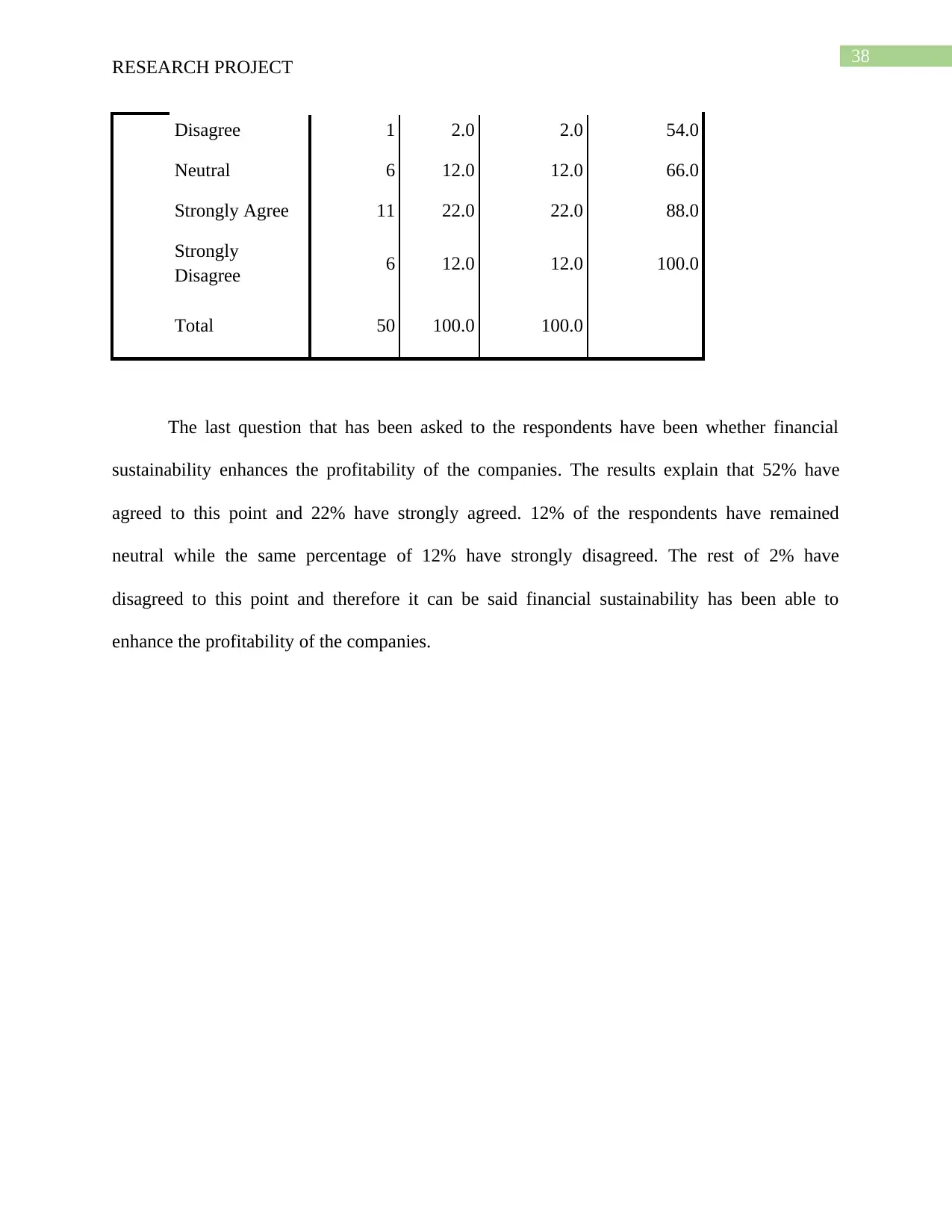
38
RESEARCH PROJECT
Disagree 1 2.0 2.0 54.0
Neutral 6 12.0 12.0 66.0
Strongly Agree 11 22.0 22.0 88.0
Strongly
Disagree 6 12.0 12.0 100.0
Total 50 100.0 100.0
The last question that has been asked to the respondents have been whether financial
sustainability enhances the profitability of the companies. The results explain that 52% have
agreed to this point and 22% have strongly agreed. 12% of the respondents have remained
neutral while the same percentage of 12% have strongly disagreed. The rest of 2% have
disagreed to this point and therefore it can be said financial sustainability has been able to
enhance the profitability of the companies.
RESEARCH PROJECT
Disagree 1 2.0 2.0 54.0
Neutral 6 12.0 12.0 66.0
Strongly Agree 11 22.0 22.0 88.0
Strongly
Disagree 6 12.0 12.0 100.0
Total 50 100.0 100.0
The last question that has been asked to the respondents have been whether financial
sustainability enhances the profitability of the companies. The results explain that 52% have
agreed to this point and 22% have strongly agreed. 12% of the respondents have remained
neutral while the same percentage of 12% have strongly disagreed. The rest of 2% have
disagreed to this point and therefore it can be said financial sustainability has been able to
enhance the profitability of the companies.
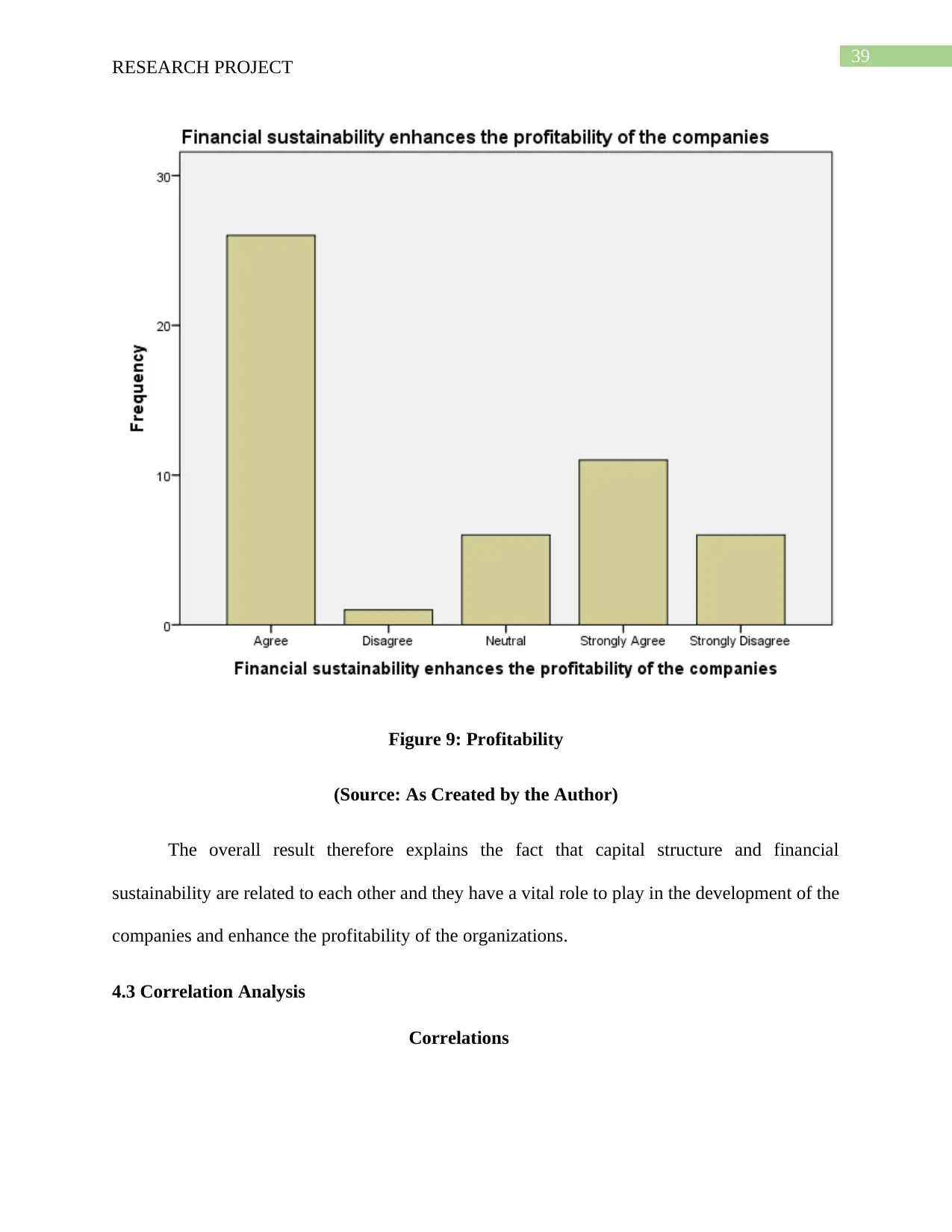
39
RESEARCH PROJECT
Figure 9: Profitability
(Source: As Created by the Author)
The overall result therefore explains the fact that capital structure and financial
sustainability are related to each other and they have a vital role to play in the development of the
companies and enhance the profitability of the organizations.
4.3 Correlation Analysis
Correlations
RESEARCH PROJECT
Figure 9: Profitability
(Source: As Created by the Author)
The overall result therefore explains the fact that capital structure and financial
sustainability are related to each other and they have a vital role to play in the development of the
companies and enhance the profitability of the organizations.
4.3 Correlation Analysis
Correlations
Secure Best Marks with AI Grader
Need help grading? Try our AI Grader for instant feedback on your assignments.
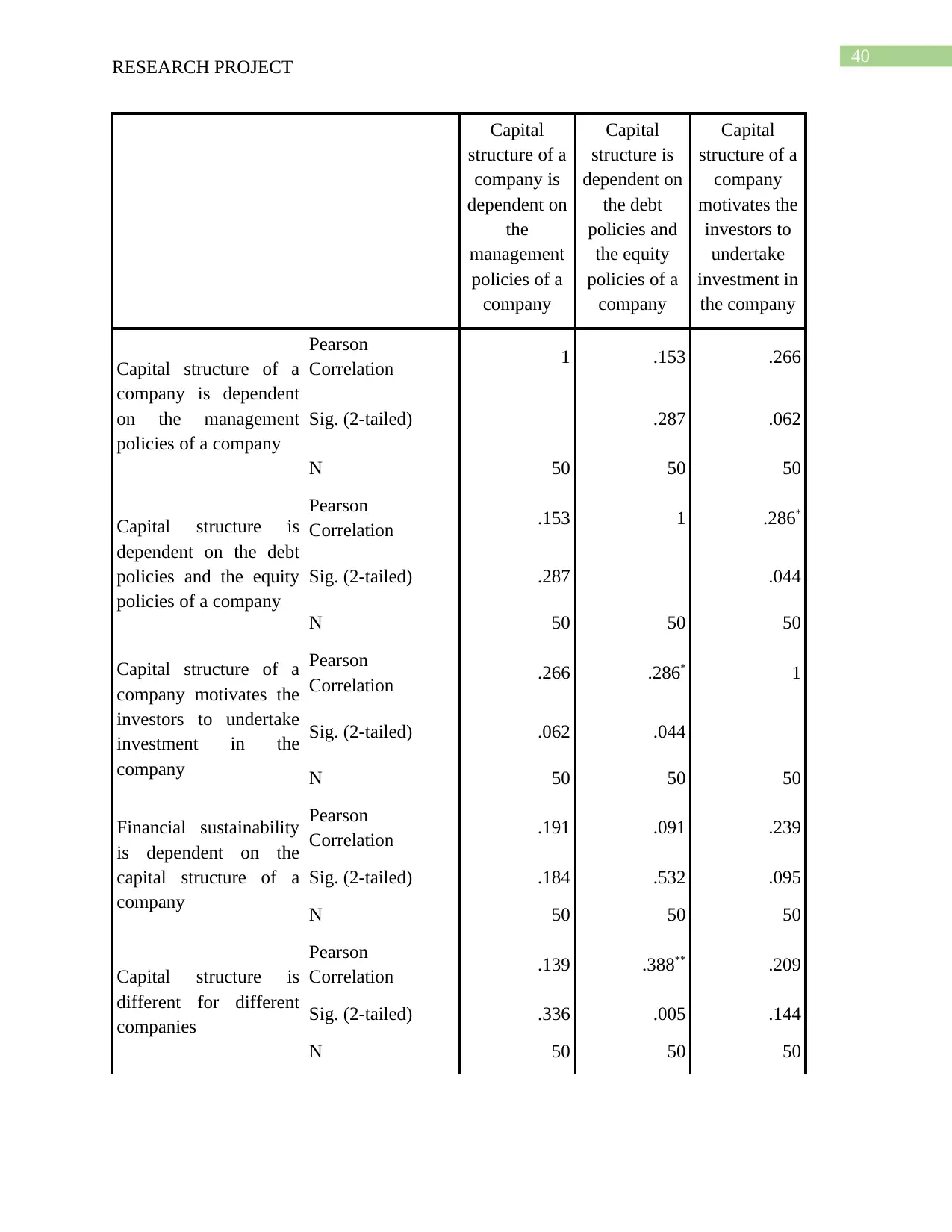
40
RESEARCH PROJECT
Capital
structure of a
company is
dependent on
the
management
policies of a
company
Capital
structure is
dependent on
the debt
policies and
the equity
policies of a
company
Capital
structure of a
company
motivates the
investors to
undertake
investment in
the company
Capital structure of a
company is dependent
on the management
policies of a company
Pearson
Correlation 1 .153 .266
Sig. (2-tailed) .287 .062
N 50 50 50
Capital structure is
dependent on the debt
policies and the equity
policies of a company
Pearson
Correlation .153 1 .286*
Sig. (2-tailed) .287 .044
N 50 50 50
Capital structure of a
company motivates the
investors to undertake
investment in the
company
Pearson
Correlation .266 .286* 1
Sig. (2-tailed) .062 .044
N 50 50 50
Financial sustainability
is dependent on the
capital structure of a
company
Pearson
Correlation .191 .091 .239
Sig. (2-tailed) .184 .532 .095
N 50 50 50
Capital structure is
different for different
companies
Pearson
Correlation .139 .388** .209
Sig. (2-tailed) .336 .005 .144
N 50 50 50
RESEARCH PROJECT
Capital
structure of a
company is
dependent on
the
management
policies of a
company
Capital
structure is
dependent on
the debt
policies and
the equity
policies of a
company
Capital
structure of a
company
motivates the
investors to
undertake
investment in
the company
Capital structure of a
company is dependent
on the management
policies of a company
Pearson
Correlation 1 .153 .266
Sig. (2-tailed) .287 .062
N 50 50 50
Capital structure is
dependent on the debt
policies and the equity
policies of a company
Pearson
Correlation .153 1 .286*
Sig. (2-tailed) .287 .044
N 50 50 50
Capital structure of a
company motivates the
investors to undertake
investment in the
company
Pearson
Correlation .266 .286* 1
Sig. (2-tailed) .062 .044
N 50 50 50
Financial sustainability
is dependent on the
capital structure of a
company
Pearson
Correlation .191 .091 .239
Sig. (2-tailed) .184 .532 .095
N 50 50 50
Capital structure is
different for different
companies
Pearson
Correlation .139 .388** .209
Sig. (2-tailed) .336 .005 .144
N 50 50 50
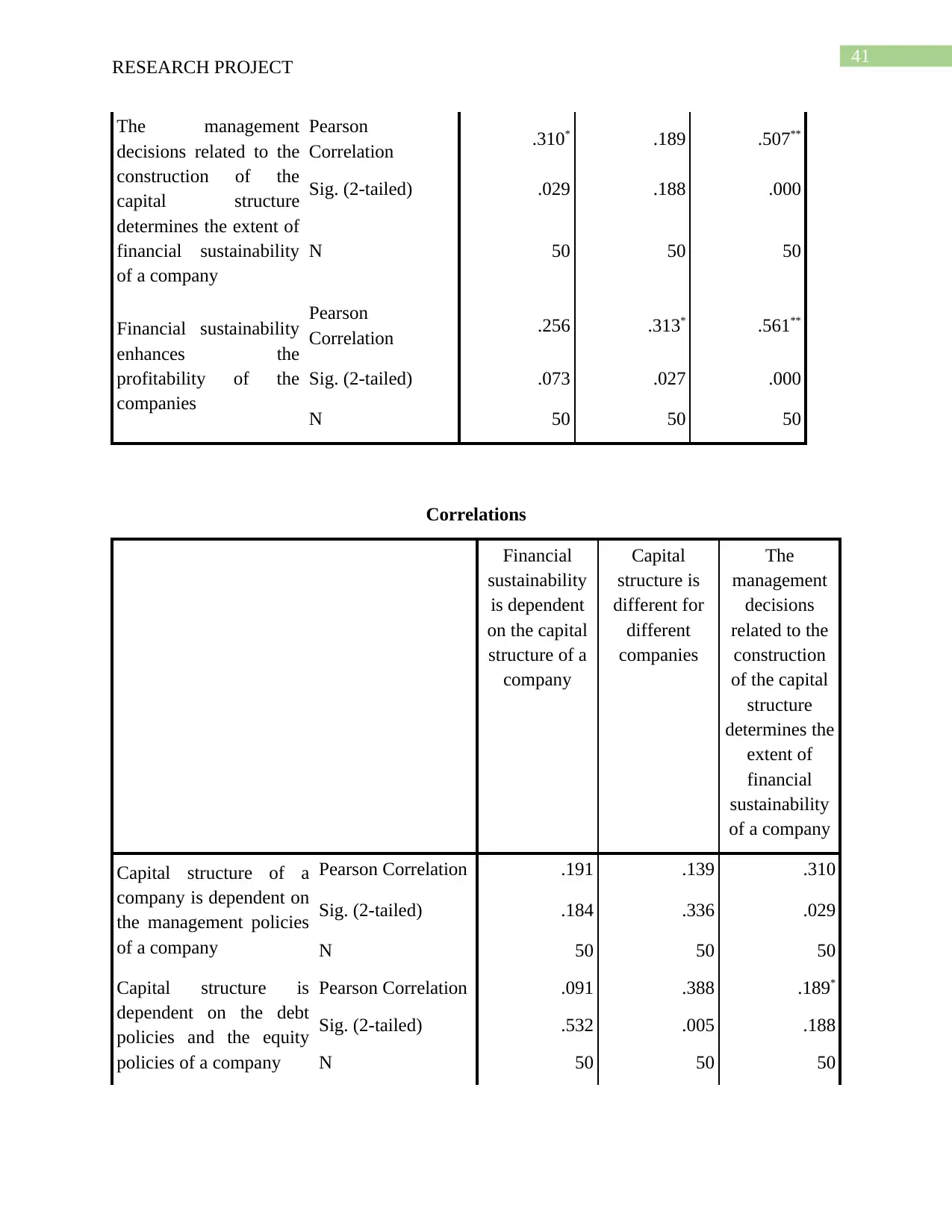
41
RESEARCH PROJECT
The management
decisions related to the
construction of the
capital structure
determines the extent of
financial sustainability
of a company
Pearson
Correlation .310* .189 .507**
Sig. (2-tailed) .029 .188 .000
N 50 50 50
Financial sustainability
enhances the
profitability of the
companies
Pearson
Correlation .256 .313* .561**
Sig. (2-tailed) .073 .027 .000
N 50 50 50
Correlations
Financial
sustainability
is dependent
on the capital
structure of a
company
Capital
structure is
different for
different
companies
The
management
decisions
related to the
construction
of the capital
structure
determines the
extent of
financial
sustainability
of a company
Capital structure of a
company is dependent on
the management policies
of a company
Pearson Correlation .191 .139 .310
Sig. (2-tailed) .184 .336 .029
N 50 50 50
Capital structure is
dependent on the debt
policies and the equity
policies of a company
Pearson Correlation .091 .388 .189*
Sig. (2-tailed) .532 .005 .188
N 50 50 50
RESEARCH PROJECT
The management
decisions related to the
construction of the
capital structure
determines the extent of
financial sustainability
of a company
Pearson
Correlation .310* .189 .507**
Sig. (2-tailed) .029 .188 .000
N 50 50 50
Financial sustainability
enhances the
profitability of the
companies
Pearson
Correlation .256 .313* .561**
Sig. (2-tailed) .073 .027 .000
N 50 50 50
Correlations
Financial
sustainability
is dependent
on the capital
structure of a
company
Capital
structure is
different for
different
companies
The
management
decisions
related to the
construction
of the capital
structure
determines the
extent of
financial
sustainability
of a company
Capital structure of a
company is dependent on
the management policies
of a company
Pearson Correlation .191 .139 .310
Sig. (2-tailed) .184 .336 .029
N 50 50 50
Capital structure is
dependent on the debt
policies and the equity
policies of a company
Pearson Correlation .091 .388 .189*
Sig. (2-tailed) .532 .005 .188
N 50 50 50
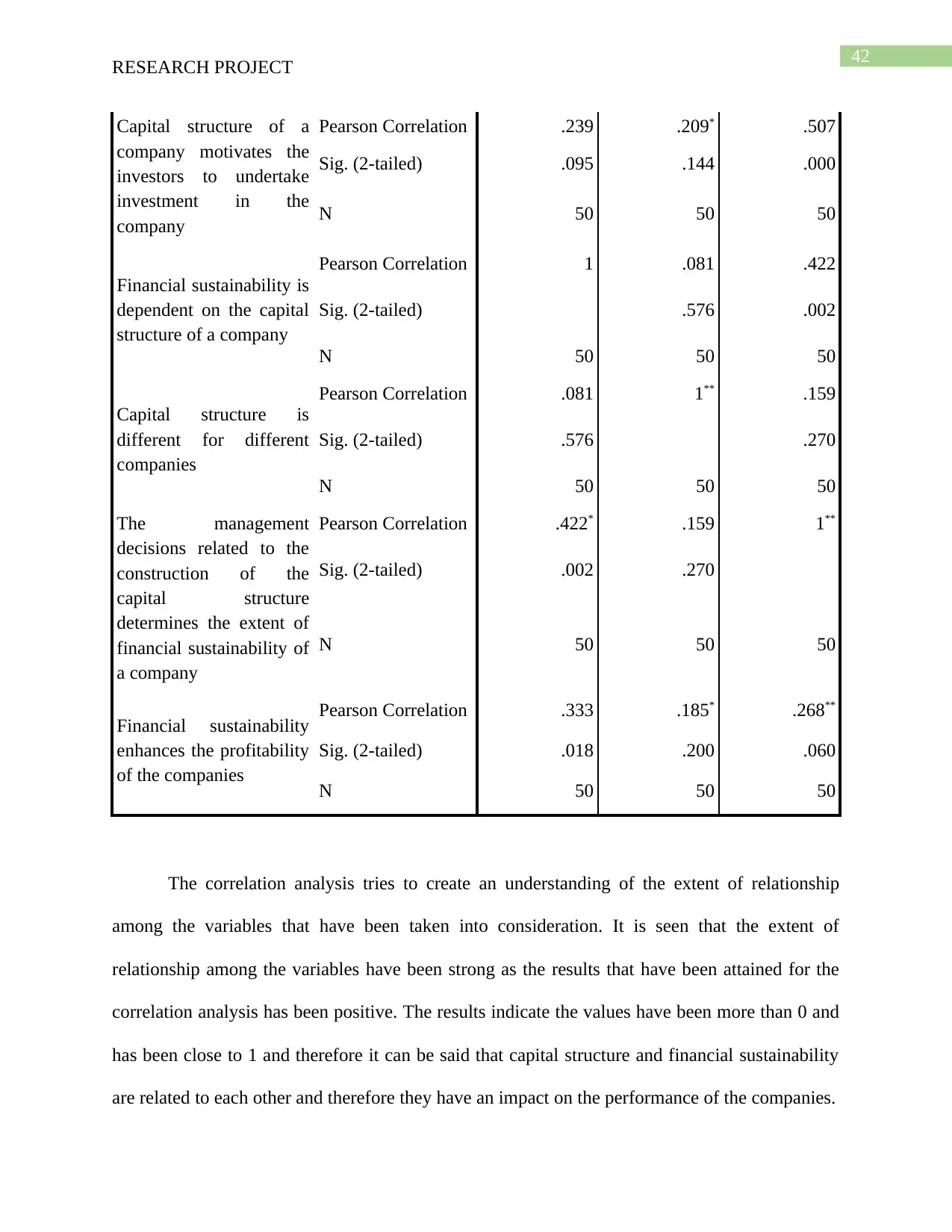
42
RESEARCH PROJECT
Capital structure of a
company motivates the
investors to undertake
investment in the
company
Pearson Correlation .239 .209* .507
Sig. (2-tailed) .095 .144 .000
N 50 50 50
Financial sustainability is
dependent on the capital
structure of a company
Pearson Correlation 1 .081 .422
Sig. (2-tailed) .576 .002
N 50 50 50
Capital structure is
different for different
companies
Pearson Correlation .081 1** .159
Sig. (2-tailed) .576 .270
N 50 50 50
The management
decisions related to the
construction of the
capital structure
determines the extent of
financial sustainability of
a company
Pearson Correlation .422* .159 1**
Sig. (2-tailed) .002 .270
N 50 50 50
Financial sustainability
enhances the profitability
of the companies
Pearson Correlation .333 .185* .268**
Sig. (2-tailed) .018 .200 .060
N 50 50 50
The correlation analysis tries to create an understanding of the extent of relationship
among the variables that have been taken into consideration. It is seen that the extent of
relationship among the variables have been strong as the results that have been attained for the
correlation analysis has been positive. The results indicate the values have been more than 0 and
has been close to 1 and therefore it can be said that capital structure and financial sustainability
are related to each other and therefore they have an impact on the performance of the companies.
RESEARCH PROJECT
Capital structure of a
company motivates the
investors to undertake
investment in the
company
Pearson Correlation .239 .209* .507
Sig. (2-tailed) .095 .144 .000
N 50 50 50
Financial sustainability is
dependent on the capital
structure of a company
Pearson Correlation 1 .081 .422
Sig. (2-tailed) .576 .002
N 50 50 50
Capital structure is
different for different
companies
Pearson Correlation .081 1** .159
Sig. (2-tailed) .576 .270
N 50 50 50
The management
decisions related to the
construction of the
capital structure
determines the extent of
financial sustainability of
a company
Pearson Correlation .422* .159 1**
Sig. (2-tailed) .002 .270
N 50 50 50
Financial sustainability
enhances the profitability
of the companies
Pearson Correlation .333 .185* .268**
Sig. (2-tailed) .018 .200 .060
N 50 50 50
The correlation analysis tries to create an understanding of the extent of relationship
among the variables that have been taken into consideration. It is seen that the extent of
relationship among the variables have been strong as the results that have been attained for the
correlation analysis has been positive. The results indicate the values have been more than 0 and
has been close to 1 and therefore it can be said that capital structure and financial sustainability
are related to each other and therefore they have an impact on the performance of the companies.
Paraphrase This Document
Need a fresh take? Get an instant paraphrase of this document with our AI Paraphraser
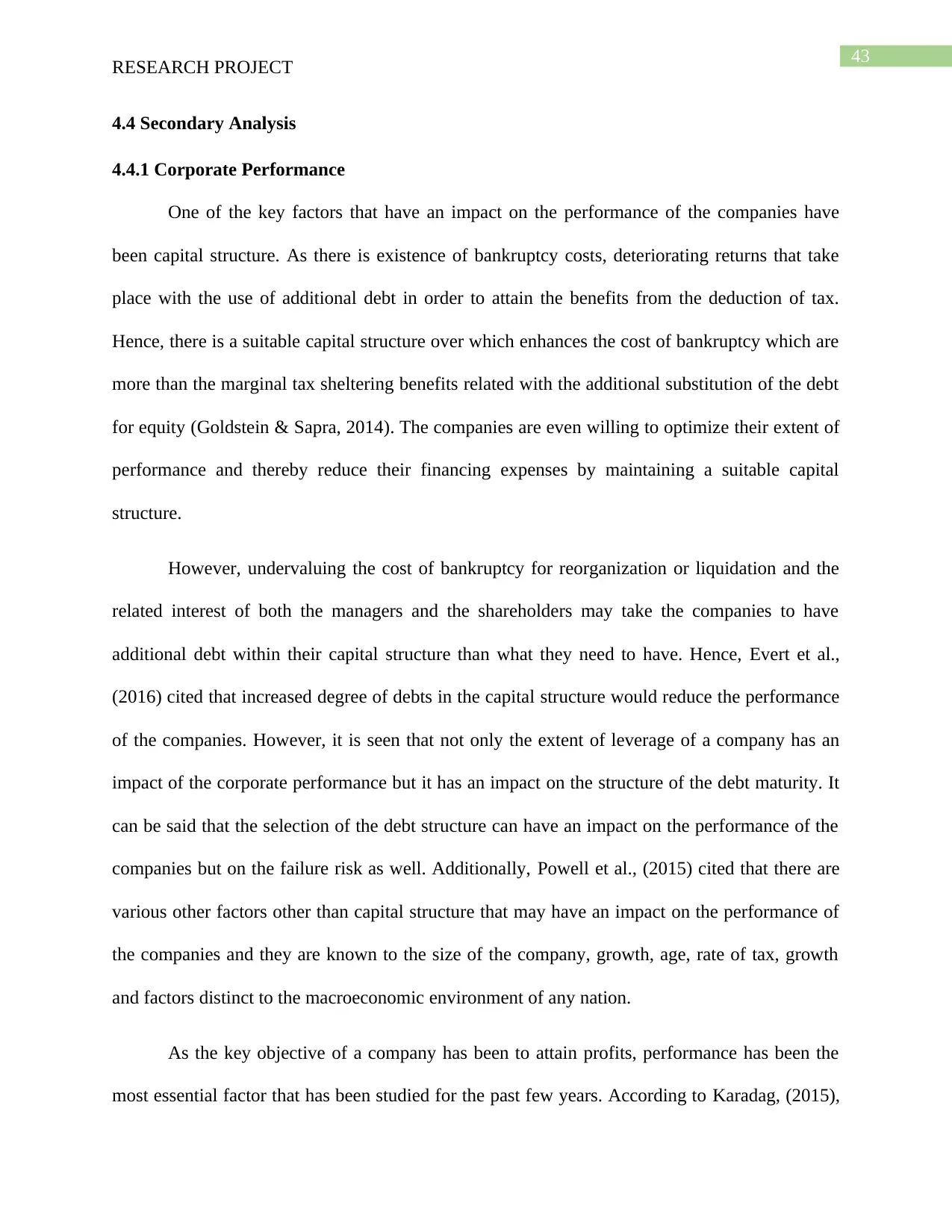
43
RESEARCH PROJECT
4.4 Secondary Analysis
4.4.1 Corporate Performance
One of the key factors that have an impact on the performance of the companies have
been capital structure. As there is existence of bankruptcy costs, deteriorating returns that take
place with the use of additional debt in order to attain the benefits from the deduction of tax.
Hence, there is a suitable capital structure over which enhances the cost of bankruptcy which are
more than the marginal tax sheltering benefits related with the additional substitution of the debt
for equity (Goldstein & Sapra, 2014). The companies are even willing to optimize their extent of
performance and thereby reduce their financing expenses by maintaining a suitable capital
structure.
However, undervaluing the cost of bankruptcy for reorganization or liquidation and the
related interest of both the managers and the shareholders may take the companies to have
additional debt within their capital structure than what they need to have. Hence, Evert et al.,
(2016) cited that increased degree of debts in the capital structure would reduce the performance
of the companies. However, it is seen that not only the extent of leverage of a company has an
impact of the corporate performance but it has an impact on the structure of the debt maturity. It
can be said that the selection of the debt structure can have an impact on the performance of the
companies but on the failure risk as well. Additionally, Powell et al., (2015) cited that there are
various other factors other than capital structure that may have an impact on the performance of
the companies and they are known to the size of the company, growth, age, rate of tax, growth
and factors distinct to the macroeconomic environment of any nation.
As the key objective of a company has been to attain profits, performance has been the
most essential factor that has been studied for the past few years. According to Karadag, (2015),
RESEARCH PROJECT
4.4 Secondary Analysis
4.4.1 Corporate Performance
One of the key factors that have an impact on the performance of the companies have
been capital structure. As there is existence of bankruptcy costs, deteriorating returns that take
place with the use of additional debt in order to attain the benefits from the deduction of tax.
Hence, there is a suitable capital structure over which enhances the cost of bankruptcy which are
more than the marginal tax sheltering benefits related with the additional substitution of the debt
for equity (Goldstein & Sapra, 2014). The companies are even willing to optimize their extent of
performance and thereby reduce their financing expenses by maintaining a suitable capital
structure.
However, undervaluing the cost of bankruptcy for reorganization or liquidation and the
related interest of both the managers and the shareholders may take the companies to have
additional debt within their capital structure than what they need to have. Hence, Evert et al.,
(2016) cited that increased degree of debts in the capital structure would reduce the performance
of the companies. However, it is seen that not only the extent of leverage of a company has an
impact of the corporate performance but it has an impact on the structure of the debt maturity. It
can be said that the selection of the debt structure can have an impact on the performance of the
companies but on the failure risk as well. Additionally, Powell et al., (2015) cited that there are
various other factors other than capital structure that may have an impact on the performance of
the companies and they are known to the size of the company, growth, age, rate of tax, growth
and factors distinct to the macroeconomic environment of any nation.
As the key objective of a company has been to attain profits, performance has been the
most essential factor that has been studied for the past few years. According to Karadag, (2015),
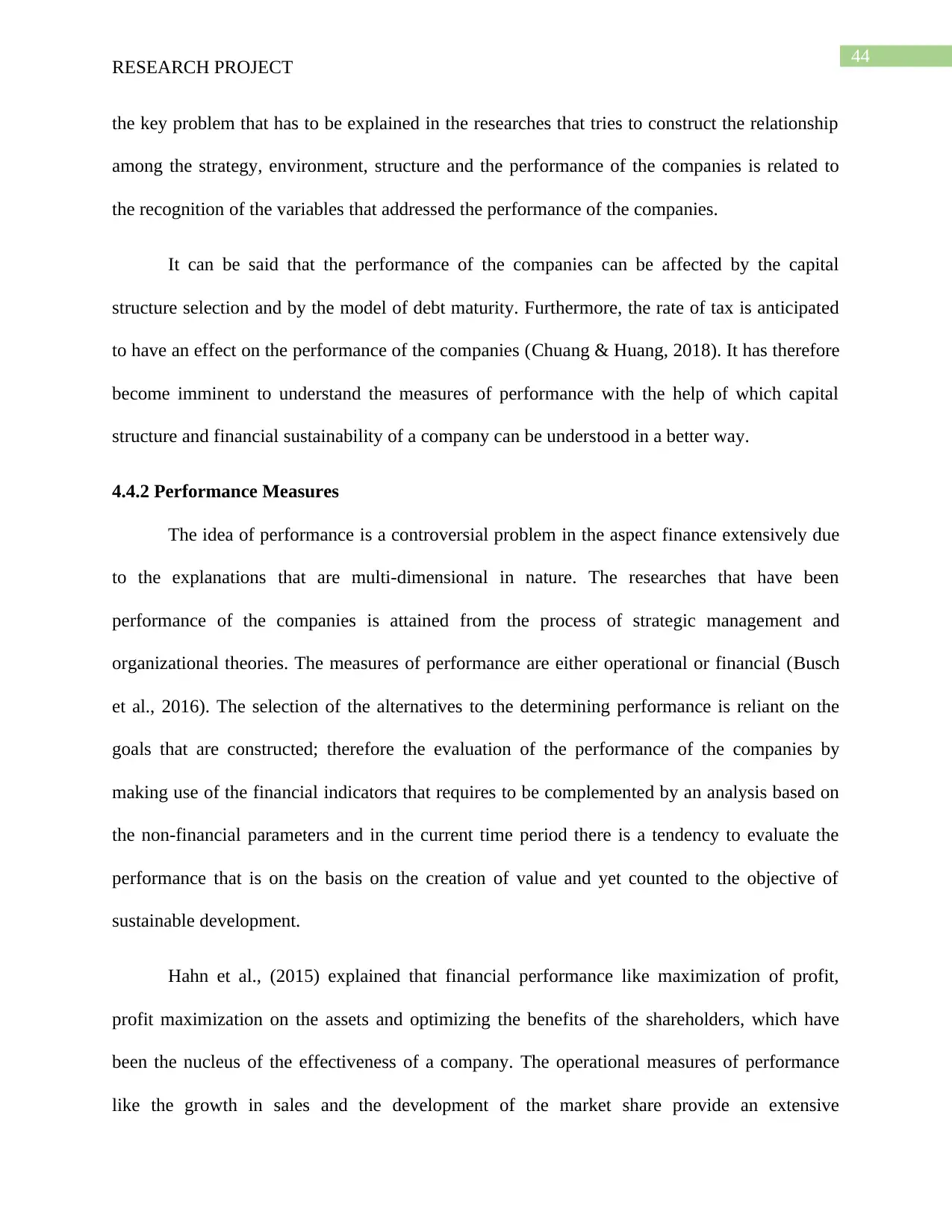
44
RESEARCH PROJECT
the key problem that has to be explained in the researches that tries to construct the relationship
among the strategy, environment, structure and the performance of the companies is related to
the recognition of the variables that addressed the performance of the companies.
It can be said that the performance of the companies can be affected by the capital
structure selection and by the model of debt maturity. Furthermore, the rate of tax is anticipated
to have an effect on the performance of the companies (Chuang & Huang, 2018). It has therefore
become imminent to understand the measures of performance with the help of which capital
structure and financial sustainability of a company can be understood in a better way.
4.4.2 Performance Measures
The idea of performance is a controversial problem in the aspect finance extensively due
to the explanations that are multi-dimensional in nature. The researches that have been
performance of the companies is attained from the process of strategic management and
organizational theories. The measures of performance are either operational or financial (Busch
et al., 2016). The selection of the alternatives to the determining performance is reliant on the
goals that are constructed; therefore the evaluation of the performance of the companies by
making use of the financial indicators that requires to be complemented by an analysis based on
the non-financial parameters and in the current time period there is a tendency to evaluate the
performance that is on the basis on the creation of value and yet counted to the objective of
sustainable development.
Hahn et al., (2015) explained that financial performance like maximization of profit,
profit maximization on the assets and optimizing the benefits of the shareholders, which have
been the nucleus of the effectiveness of a company. The operational measures of performance
like the growth in sales and the development of the market share provide an extensive
RESEARCH PROJECT
the key problem that has to be explained in the researches that tries to construct the relationship
among the strategy, environment, structure and the performance of the companies is related to
the recognition of the variables that addressed the performance of the companies.
It can be said that the performance of the companies can be affected by the capital
structure selection and by the model of debt maturity. Furthermore, the rate of tax is anticipated
to have an effect on the performance of the companies (Chuang & Huang, 2018). It has therefore
become imminent to understand the measures of performance with the help of which capital
structure and financial sustainability of a company can be understood in a better way.
4.4.2 Performance Measures
The idea of performance is a controversial problem in the aspect finance extensively due
to the explanations that are multi-dimensional in nature. The researches that have been
performance of the companies is attained from the process of strategic management and
organizational theories. The measures of performance are either operational or financial (Busch
et al., 2016). The selection of the alternatives to the determining performance is reliant on the
goals that are constructed; therefore the evaluation of the performance of the companies by
making use of the financial indicators that requires to be complemented by an analysis based on
the non-financial parameters and in the current time period there is a tendency to evaluate the
performance that is on the basis on the creation of value and yet counted to the objective of
sustainable development.
Hahn et al., (2015) explained that financial performance like maximization of profit,
profit maximization on the assets and optimizing the benefits of the shareholders, which have
been the nucleus of the effectiveness of a company. The operational measures of performance
like the growth in sales and the development of the market share provide an extensive

45
RESEARCH PROJECT
explanation of the performance as they concentrate on the factors that at the end lead to the
development of the financial performance.
The assessment of the performance is reliant on the information that has been brought in
the measurement process and the tools that have been used. Bansal et al., (2015) explained that
the conventional indicators that have been used for the purpose of financial analysis in order to
assess the performance are leverage, liquidity, return on investment, cash flow etc. The selection
of the alternatives of determining the performance may be influenced by the mission and the
vision of the companies. The evaluation of the performance of the companies by making use of
the financial indicators needs to be complemented with the help of the corporate culture, the
efficiency of the executive policies of compensation, quality of the communication process of the
shareholders etc. In the current time period, there has been a pattern towards evaluating the
performance that is based on the creation of value, which has been subsumed under the objective
of financial sustainability.
4.5 Discussion of the overall result
The assessment that has been undertaken on the basis of the primary and secondary data
analysis has been able to address the fact that capital structure of any company plays a vital part
in the development of the companies and in order to attain profit. Maximization of profit for a
company can be understood with the help of the extent of financial sustainability. The outcome
addresses the fact that capital structure is constructed on the basis of the decisions that are taken
by the management and the effectiveness of the capital structure leads to financial sustainability.
The extent of investment in a company is dependent on financial sustainability due to the fact
that the investors undertake investment on the basis of the sustainability. It is therefore seen that
capital structure has a positive and direct relationship with financial sustainability and therefore
RESEARCH PROJECT
explanation of the performance as they concentrate on the factors that at the end lead to the
development of the financial performance.
The assessment of the performance is reliant on the information that has been brought in
the measurement process and the tools that have been used. Bansal et al., (2015) explained that
the conventional indicators that have been used for the purpose of financial analysis in order to
assess the performance are leverage, liquidity, return on investment, cash flow etc. The selection
of the alternatives of determining the performance may be influenced by the mission and the
vision of the companies. The evaluation of the performance of the companies by making use of
the financial indicators needs to be complemented with the help of the corporate culture, the
efficiency of the executive policies of compensation, quality of the communication process of the
shareholders etc. In the current time period, there has been a pattern towards evaluating the
performance that is based on the creation of value, which has been subsumed under the objective
of financial sustainability.
4.5 Discussion of the overall result
The assessment that has been undertaken on the basis of the primary and secondary data
analysis has been able to address the fact that capital structure of any company plays a vital part
in the development of the companies and in order to attain profit. Maximization of profit for a
company can be understood with the help of the extent of financial sustainability. The outcome
addresses the fact that capital structure is constructed on the basis of the decisions that are taken
by the management and the effectiveness of the capital structure leads to financial sustainability.
The extent of investment in a company is dependent on financial sustainability due to the fact
that the investors undertake investment on the basis of the sustainability. It is therefore seen that
capital structure has a positive and direct relationship with financial sustainability and therefore
Secure Best Marks with AI Grader
Need help grading? Try our AI Grader for instant feedback on your assignments.
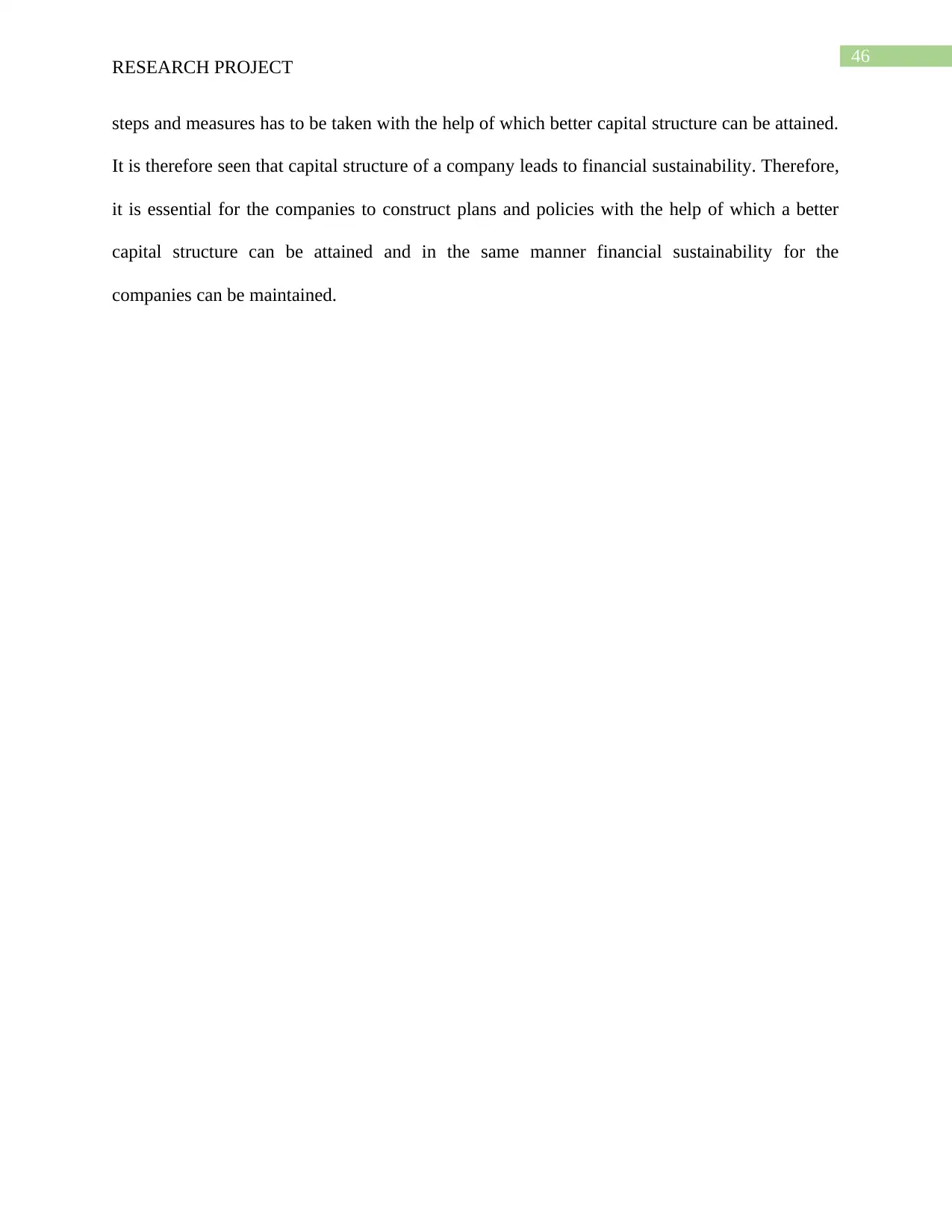
46
RESEARCH PROJECT
steps and measures has to be taken with the help of which better capital structure can be attained.
It is therefore seen that capital structure of a company leads to financial sustainability. Therefore,
it is essential for the companies to construct plans and policies with the help of which a better
capital structure can be attained and in the same manner financial sustainability for the
companies can be maintained.
RESEARCH PROJECT
steps and measures has to be taken with the help of which better capital structure can be attained.
It is therefore seen that capital structure of a company leads to financial sustainability. Therefore,
it is essential for the companies to construct plans and policies with the help of which a better
capital structure can be attained and in the same manner financial sustainability for the
companies can be maintained.
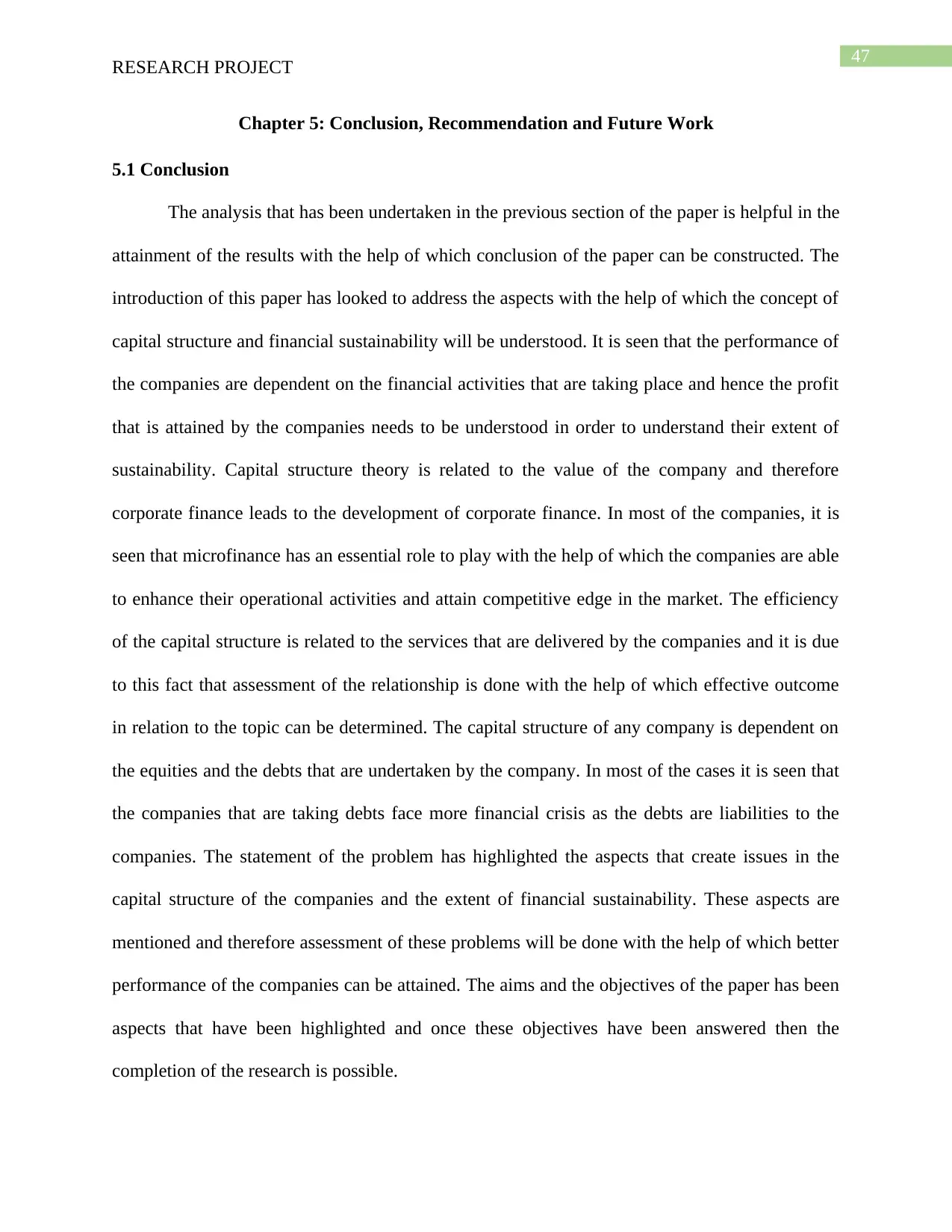
47
RESEARCH PROJECT
Chapter 5: Conclusion, Recommendation and Future Work
5.1 Conclusion
The analysis that has been undertaken in the previous section of the paper is helpful in the
attainment of the results with the help of which conclusion of the paper can be constructed. The
introduction of this paper has looked to address the aspects with the help of which the concept of
capital structure and financial sustainability will be understood. It is seen that the performance of
the companies are dependent on the financial activities that are taking place and hence the profit
that is attained by the companies needs to be understood in order to understand their extent of
sustainability. Capital structure theory is related to the value of the company and therefore
corporate finance leads to the development of corporate finance. In most of the companies, it is
seen that microfinance has an essential role to play with the help of which the companies are able
to enhance their operational activities and attain competitive edge in the market. The efficiency
of the capital structure is related to the services that are delivered by the companies and it is due
to this fact that assessment of the relationship is done with the help of which effective outcome
in relation to the topic can be determined. The capital structure of any company is dependent on
the equities and the debts that are undertaken by the company. In most of the cases it is seen that
the companies that are taking debts face more financial crisis as the debts are liabilities to the
companies. The statement of the problem has highlighted the aspects that create issues in the
capital structure of the companies and the extent of financial sustainability. These aspects are
mentioned and therefore assessment of these problems will be done with the help of which better
performance of the companies can be attained. The aims and the objectives of the paper has been
aspects that have been highlighted and once these objectives have been answered then the
completion of the research is possible.
RESEARCH PROJECT
Chapter 5: Conclusion, Recommendation and Future Work
5.1 Conclusion
The analysis that has been undertaken in the previous section of the paper is helpful in the
attainment of the results with the help of which conclusion of the paper can be constructed. The
introduction of this paper has looked to address the aspects with the help of which the concept of
capital structure and financial sustainability will be understood. It is seen that the performance of
the companies are dependent on the financial activities that are taking place and hence the profit
that is attained by the companies needs to be understood in order to understand their extent of
sustainability. Capital structure theory is related to the value of the company and therefore
corporate finance leads to the development of corporate finance. In most of the companies, it is
seen that microfinance has an essential role to play with the help of which the companies are able
to enhance their operational activities and attain competitive edge in the market. The efficiency
of the capital structure is related to the services that are delivered by the companies and it is due
to this fact that assessment of the relationship is done with the help of which effective outcome
in relation to the topic can be determined. The capital structure of any company is dependent on
the equities and the debts that are undertaken by the company. In most of the cases it is seen that
the companies that are taking debts face more financial crisis as the debts are liabilities to the
companies. The statement of the problem has highlighted the aspects that create issues in the
capital structure of the companies and the extent of financial sustainability. These aspects are
mentioned and therefore assessment of these problems will be done with the help of which better
performance of the companies can be attained. The aims and the objectives of the paper has been
aspects that have been highlighted and once these objectives have been answered then the
completion of the research is possible.
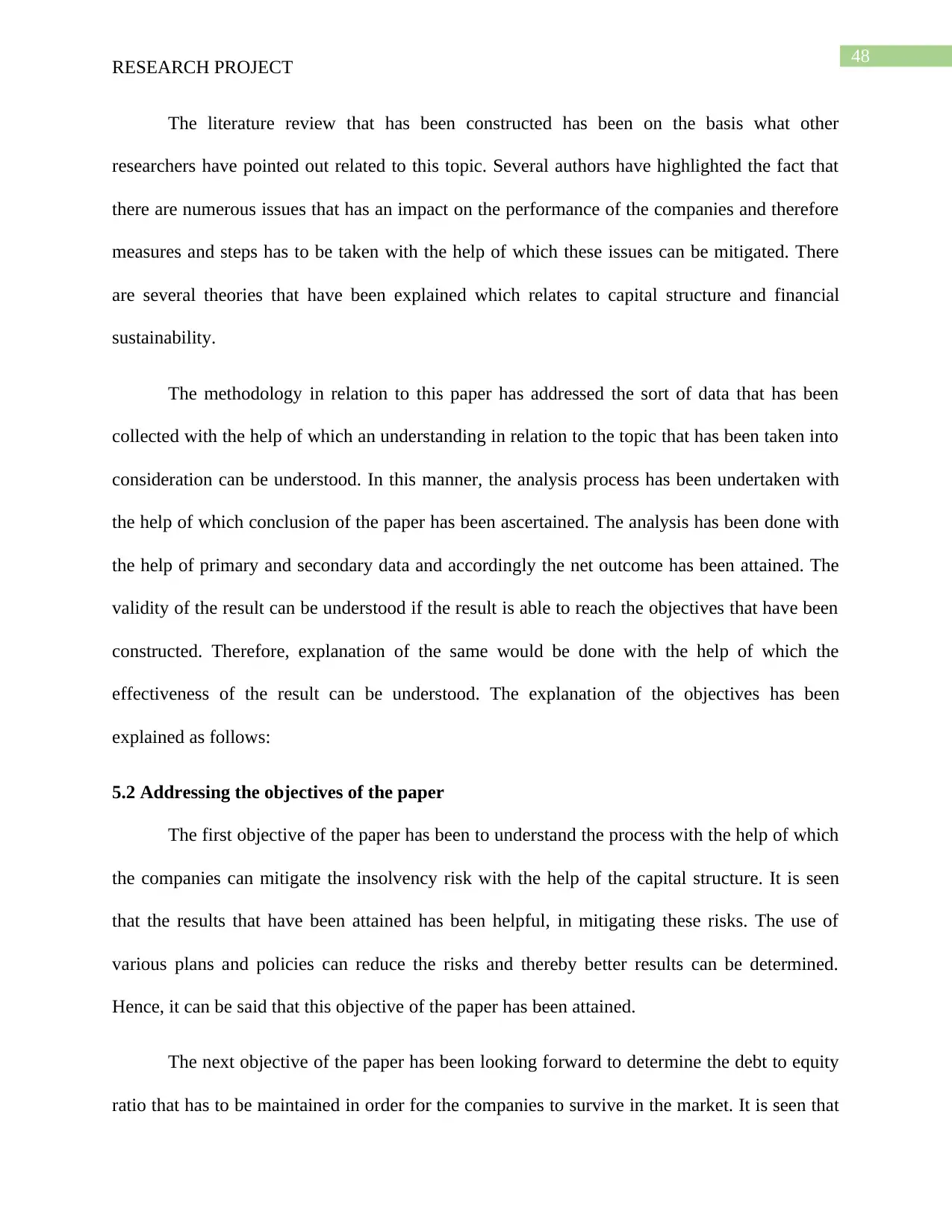
48
RESEARCH PROJECT
The literature review that has been constructed has been on the basis what other
researchers have pointed out related to this topic. Several authors have highlighted the fact that
there are numerous issues that has an impact on the performance of the companies and therefore
measures and steps has to be taken with the help of which these issues can be mitigated. There
are several theories that have been explained which relates to capital structure and financial
sustainability.
The methodology in relation to this paper has addressed the sort of data that has been
collected with the help of which an understanding in relation to the topic that has been taken into
consideration can be understood. In this manner, the analysis process has been undertaken with
the help of which conclusion of the paper has been ascertained. The analysis has been done with
the help of primary and secondary data and accordingly the net outcome has been attained. The
validity of the result can be understood if the result is able to reach the objectives that have been
constructed. Therefore, explanation of the same would be done with the help of which the
effectiveness of the result can be understood. The explanation of the objectives has been
explained as follows:
5.2 Addressing the objectives of the paper
The first objective of the paper has been to understand the process with the help of which
the companies can mitigate the insolvency risk with the help of the capital structure. It is seen
that the results that have been attained has been helpful, in mitigating these risks. The use of
various plans and policies can reduce the risks and thereby better results can be determined.
Hence, it can be said that this objective of the paper has been attained.
The next objective of the paper has been looking forward to determine the debt to equity
ratio that has to be maintained in order for the companies to survive in the market. It is seen that
RESEARCH PROJECT
The literature review that has been constructed has been on the basis what other
researchers have pointed out related to this topic. Several authors have highlighted the fact that
there are numerous issues that has an impact on the performance of the companies and therefore
measures and steps has to be taken with the help of which these issues can be mitigated. There
are several theories that have been explained which relates to capital structure and financial
sustainability.
The methodology in relation to this paper has addressed the sort of data that has been
collected with the help of which an understanding in relation to the topic that has been taken into
consideration can be understood. In this manner, the analysis process has been undertaken with
the help of which conclusion of the paper has been ascertained. The analysis has been done with
the help of primary and secondary data and accordingly the net outcome has been attained. The
validity of the result can be understood if the result is able to reach the objectives that have been
constructed. Therefore, explanation of the same would be done with the help of which the
effectiveness of the result can be understood. The explanation of the objectives has been
explained as follows:
5.2 Addressing the objectives of the paper
The first objective of the paper has been to understand the process with the help of which
the companies can mitigate the insolvency risk with the help of the capital structure. It is seen
that the results that have been attained has been helpful, in mitigating these risks. The use of
various plans and policies can reduce the risks and thereby better results can be determined.
Hence, it can be said that this objective of the paper has been attained.
The next objective of the paper has been looking forward to determine the debt to equity
ratio that has to be maintained in order for the companies to survive in the market. It is seen that
Paraphrase This Document
Need a fresh take? Get an instant paraphrase of this document with our AI Paraphraser
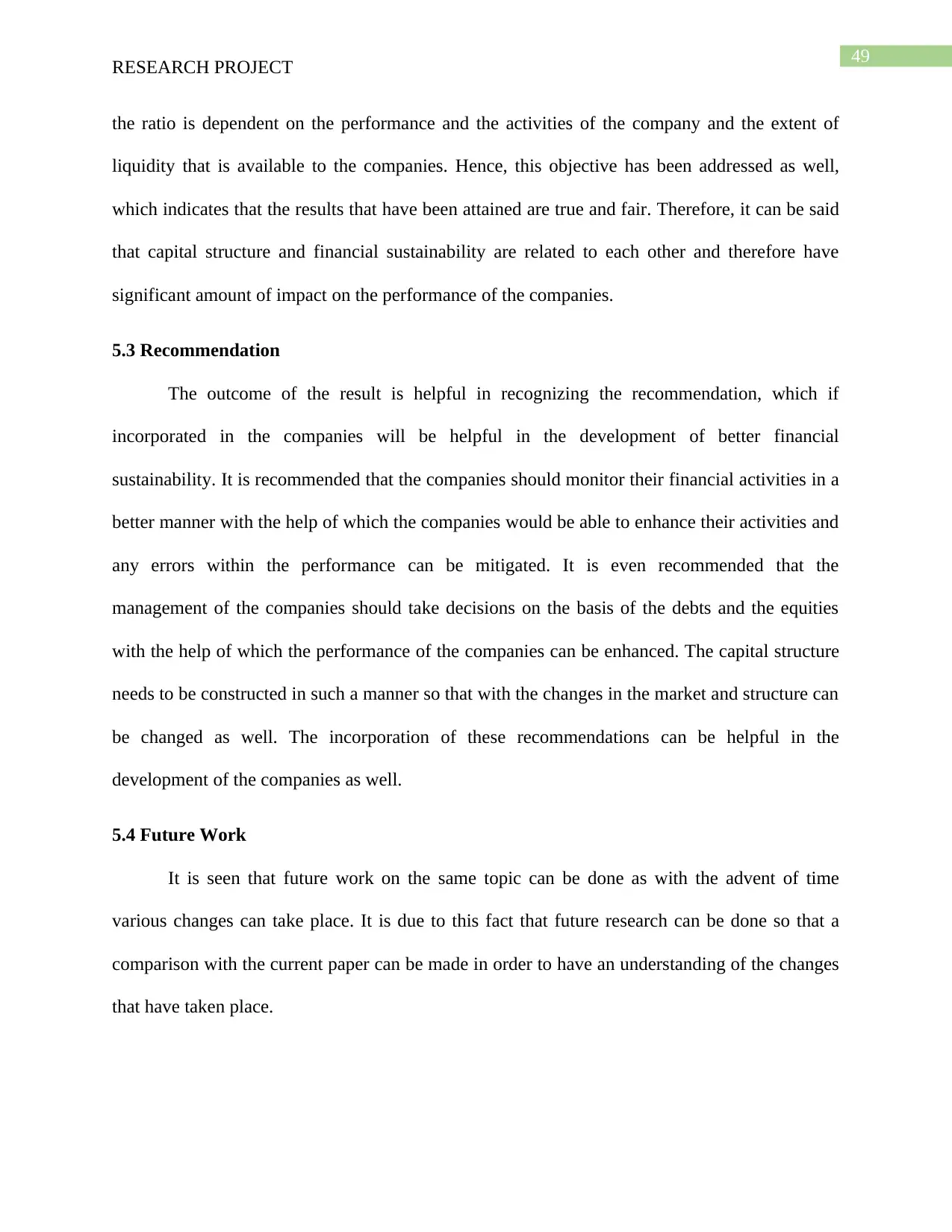
49
RESEARCH PROJECT
the ratio is dependent on the performance and the activities of the company and the extent of
liquidity that is available to the companies. Hence, this objective has been addressed as well,
which indicates that the results that have been attained are true and fair. Therefore, it can be said
that capital structure and financial sustainability are related to each other and therefore have
significant amount of impact on the performance of the companies.
5.3 Recommendation
The outcome of the result is helpful in recognizing the recommendation, which if
incorporated in the companies will be helpful in the development of better financial
sustainability. It is recommended that the companies should monitor their financial activities in a
better manner with the help of which the companies would be able to enhance their activities and
any errors within the performance can be mitigated. It is even recommended that the
management of the companies should take decisions on the basis of the debts and the equities
with the help of which the performance of the companies can be enhanced. The capital structure
needs to be constructed in such a manner so that with the changes in the market and structure can
be changed as well. The incorporation of these recommendations can be helpful in the
development of the companies as well.
5.4 Future Work
It is seen that future work on the same topic can be done as with the advent of time
various changes can take place. It is due to this fact that future research can be done so that a
comparison with the current paper can be made in order to have an understanding of the changes
that have taken place.
RESEARCH PROJECT
the ratio is dependent on the performance and the activities of the company and the extent of
liquidity that is available to the companies. Hence, this objective has been addressed as well,
which indicates that the results that have been attained are true and fair. Therefore, it can be said
that capital structure and financial sustainability are related to each other and therefore have
significant amount of impact on the performance of the companies.
5.3 Recommendation
The outcome of the result is helpful in recognizing the recommendation, which if
incorporated in the companies will be helpful in the development of better financial
sustainability. It is recommended that the companies should monitor their financial activities in a
better manner with the help of which the companies would be able to enhance their activities and
any errors within the performance can be mitigated. It is even recommended that the
management of the companies should take decisions on the basis of the debts and the equities
with the help of which the performance of the companies can be enhanced. The capital structure
needs to be constructed in such a manner so that with the changes in the market and structure can
be changed as well. The incorporation of these recommendations can be helpful in the
development of the companies as well.
5.4 Future Work
It is seen that future work on the same topic can be done as with the advent of time
various changes can take place. It is due to this fact that future research can be done so that a
comparison with the current paper can be made in order to have an understanding of the changes
that have taken place.
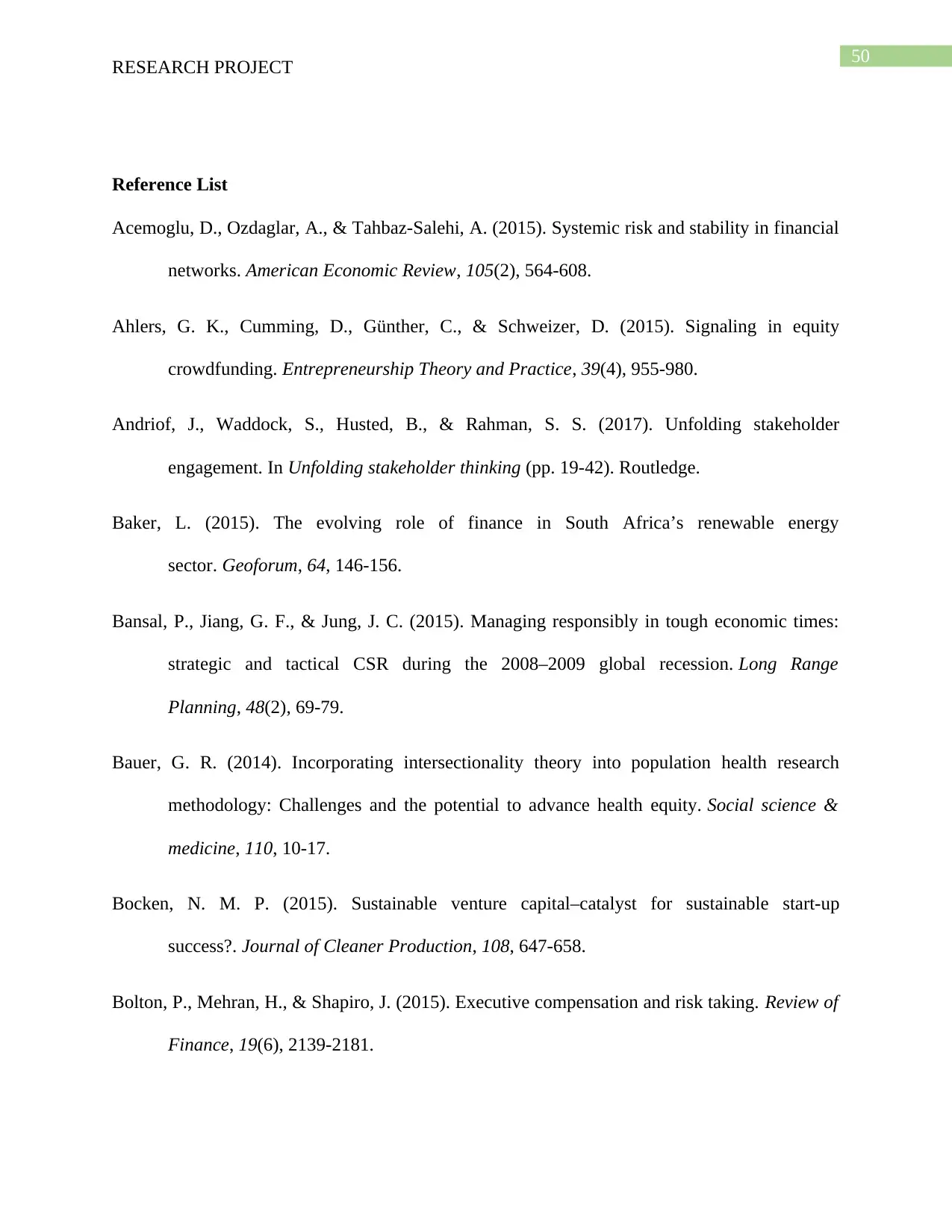
50
RESEARCH PROJECT
Reference List
Acemoglu, D., Ozdaglar, A., & Tahbaz-Salehi, A. (2015). Systemic risk and stability in financial
networks. American Economic Review, 105(2), 564-608.
Ahlers, G. K., Cumming, D., Günther, C., & Schweizer, D. (2015). Signaling in equity
crowdfunding. Entrepreneurship Theory and Practice, 39(4), 955-980.
Andriof, J., Waddock, S., Husted, B., & Rahman, S. S. (2017). Unfolding stakeholder
engagement. In Unfolding stakeholder thinking (pp. 19-42). Routledge.
Baker, L. (2015). The evolving role of finance in South Africa’s renewable energy
sector. Geoforum, 64, 146-156.
Bansal, P., Jiang, G. F., & Jung, J. C. (2015). Managing responsibly in tough economic times:
strategic and tactical CSR during the 2008–2009 global recession. Long Range
Planning, 48(2), 69-79.
Bauer, G. R. (2014). Incorporating intersectionality theory into population health research
methodology: Challenges and the potential to advance health equity. Social science &
medicine, 110, 10-17.
Bocken, N. M. P. (2015). Sustainable venture capital–catalyst for sustainable start-up
success?. Journal of Cleaner Production, 108, 647-658.
Bolton, P., Mehran, H., & Shapiro, J. (2015). Executive compensation and risk taking. Review of
Finance, 19(6), 2139-2181.
RESEARCH PROJECT
Reference List
Acemoglu, D., Ozdaglar, A., & Tahbaz-Salehi, A. (2015). Systemic risk and stability in financial
networks. American Economic Review, 105(2), 564-608.
Ahlers, G. K., Cumming, D., Günther, C., & Schweizer, D. (2015). Signaling in equity
crowdfunding. Entrepreneurship Theory and Practice, 39(4), 955-980.
Andriof, J., Waddock, S., Husted, B., & Rahman, S. S. (2017). Unfolding stakeholder
engagement. In Unfolding stakeholder thinking (pp. 19-42). Routledge.
Baker, L. (2015). The evolving role of finance in South Africa’s renewable energy
sector. Geoforum, 64, 146-156.
Bansal, P., Jiang, G. F., & Jung, J. C. (2015). Managing responsibly in tough economic times:
strategic and tactical CSR during the 2008–2009 global recession. Long Range
Planning, 48(2), 69-79.
Bauer, G. R. (2014). Incorporating intersectionality theory into population health research
methodology: Challenges and the potential to advance health equity. Social science &
medicine, 110, 10-17.
Bocken, N. M. P. (2015). Sustainable venture capital–catalyst for sustainable start-up
success?. Journal of Cleaner Production, 108, 647-658.
Bolton, P., Mehran, H., & Shapiro, J. (2015). Executive compensation and risk taking. Review of
Finance, 19(6), 2139-2181.
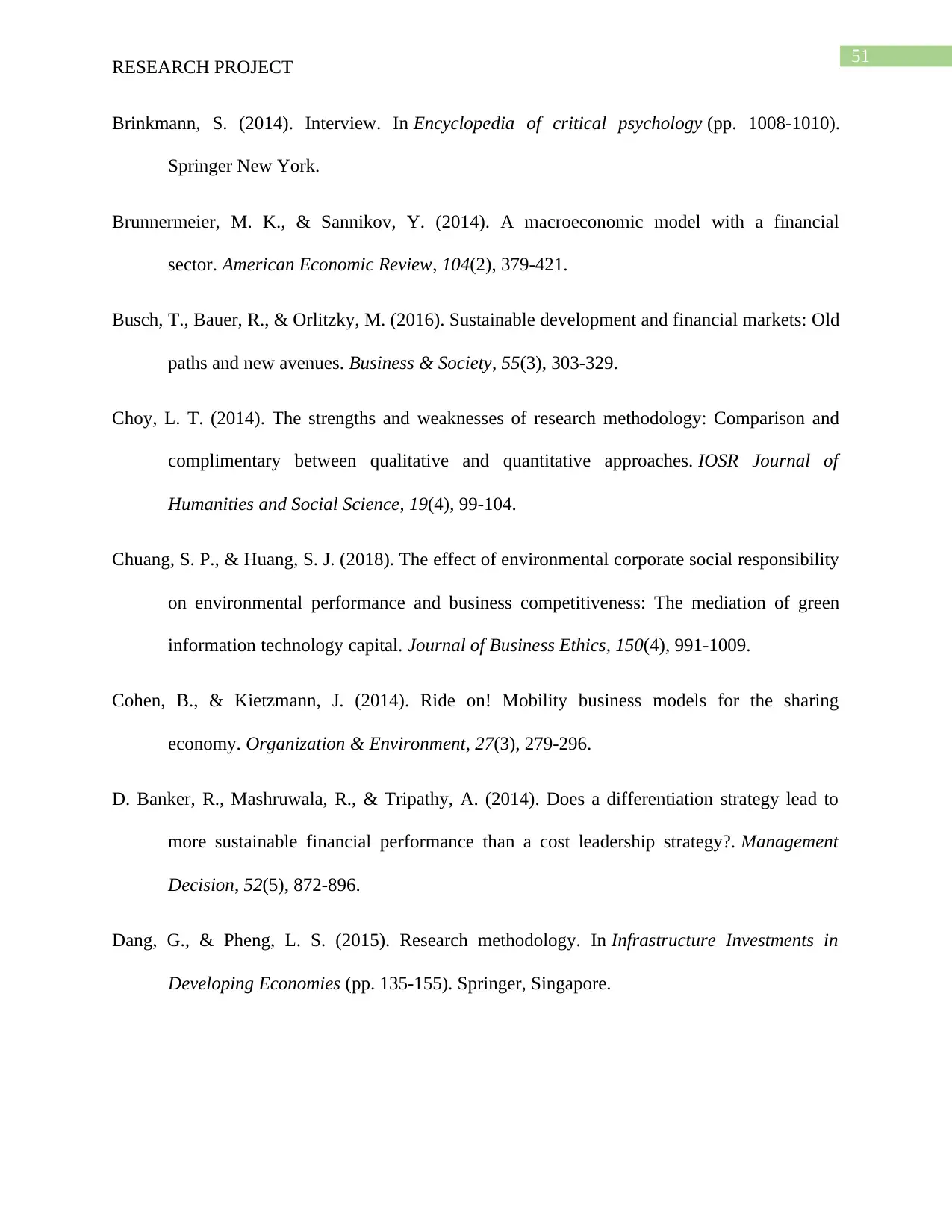
51
RESEARCH PROJECT
Brinkmann, S. (2014). Interview. In Encyclopedia of critical psychology (pp. 1008-1010).
Springer New York.
Brunnermeier, M. K., & Sannikov, Y. (2014). A macroeconomic model with a financial
sector. American Economic Review, 104(2), 379-421.
Busch, T., Bauer, R., & Orlitzky, M. (2016). Sustainable development and financial markets: Old
paths and new avenues. Business & Society, 55(3), 303-329.
Choy, L. T. (2014). The strengths and weaknesses of research methodology: Comparison and
complimentary between qualitative and quantitative approaches. IOSR Journal of
Humanities and Social Science, 19(4), 99-104.
Chuang, S. P., & Huang, S. J. (2018). The effect of environmental corporate social responsibility
on environmental performance and business competitiveness: The mediation of green
information technology capital. Journal of Business Ethics, 150(4), 991-1009.
Cohen, B., & Kietzmann, J. (2014). Ride on! Mobility business models for the sharing
economy. Organization & Environment, 27(3), 279-296.
D. Banker, R., Mashruwala, R., & Tripathy, A. (2014). Does a differentiation strategy lead to
more sustainable financial performance than a cost leadership strategy?. Management
Decision, 52(5), 872-896.
Dang, G., & Pheng, L. S. (2015). Research methodology. In Infrastructure Investments in
Developing Economies (pp. 135-155). Springer, Singapore.
RESEARCH PROJECT
Brinkmann, S. (2014). Interview. In Encyclopedia of critical psychology (pp. 1008-1010).
Springer New York.
Brunnermeier, M. K., & Sannikov, Y. (2014). A macroeconomic model with a financial
sector. American Economic Review, 104(2), 379-421.
Busch, T., Bauer, R., & Orlitzky, M. (2016). Sustainable development and financial markets: Old
paths and new avenues. Business & Society, 55(3), 303-329.
Choy, L. T. (2014). The strengths and weaknesses of research methodology: Comparison and
complimentary between qualitative and quantitative approaches. IOSR Journal of
Humanities and Social Science, 19(4), 99-104.
Chuang, S. P., & Huang, S. J. (2018). The effect of environmental corporate social responsibility
on environmental performance and business competitiveness: The mediation of green
information technology capital. Journal of Business Ethics, 150(4), 991-1009.
Cohen, B., & Kietzmann, J. (2014). Ride on! Mobility business models for the sharing
economy. Organization & Environment, 27(3), 279-296.
D. Banker, R., Mashruwala, R., & Tripathy, A. (2014). Does a differentiation strategy lead to
more sustainable financial performance than a cost leadership strategy?. Management
Decision, 52(5), 872-896.
Dang, G., & Pheng, L. S. (2015). Research methodology. In Infrastructure Investments in
Developing Economies (pp. 135-155). Springer, Singapore.
Secure Best Marks with AI Grader
Need help grading? Try our AI Grader for instant feedback on your assignments.

52
RESEARCH PROJECT
DeAngelo, H., & Stulz, R. M. (2015). Liquid-claim production, risk management, and bank
capital structure: Why high leverage is optimal for banks. Journal of Financial
Economics, 116(2), 219-236.
Dumay, J. (2016). A critical reflection on the future of intellectual capital: from reporting to
disclosure. Journal of Intellectual capital, 17(1), 168-184.
Evert, R. E., Martin, J. A., McLeod, M. S., & Payne, G. T. (2016). Empirics in family business
research: Progress, challenges, and the path ahead. Family Business Review, 29(1), 17-43.
França, C. L., Broman, G., Robèrt, K. H., Basile, G., & Trygg, L. (2017). An approach to
business model innovation and design for strategic sustainable development. Journal of
Cleaner Production, 140, 155-166.
Fraser, S., Bhaumik, S. K., & Wright, M. (2015). What do we know about entrepreneurial
finance and its relationship with growth?. International Small Business Journal, 33(1),
70-88.
Goldstein, I., & Sapra, H. (2014). Should banks' stress test results be disclosed? An analysis of
the costs and benefits. Foundations and Trends® in Finance, 8(1), 1-54.
Graham, J. R., Leary, M. T., & Roberts, M. R. (2015). A century of capital structure: The
leveraging of corporate America. Journal of Financial Economics, 118(3), 658-683.
Guerry, A. D., Polasky, S., Lubchenco, J., Chaplin-Kramer, R., Daily, G. C., Griffin, R., ... &
Feldman, M. W. (2015). Natural capital and ecosystem services informing decisions:
From promise to practice. Proceedings of the National Academy of Sciences, 112(24),
7348-7355.
RESEARCH PROJECT
DeAngelo, H., & Stulz, R. M. (2015). Liquid-claim production, risk management, and bank
capital structure: Why high leverage is optimal for banks. Journal of Financial
Economics, 116(2), 219-236.
Dumay, J. (2016). A critical reflection on the future of intellectual capital: from reporting to
disclosure. Journal of Intellectual capital, 17(1), 168-184.
Evert, R. E., Martin, J. A., McLeod, M. S., & Payne, G. T. (2016). Empirics in family business
research: Progress, challenges, and the path ahead. Family Business Review, 29(1), 17-43.
França, C. L., Broman, G., Robèrt, K. H., Basile, G., & Trygg, L. (2017). An approach to
business model innovation and design for strategic sustainable development. Journal of
Cleaner Production, 140, 155-166.
Fraser, S., Bhaumik, S. K., & Wright, M. (2015). What do we know about entrepreneurial
finance and its relationship with growth?. International Small Business Journal, 33(1),
70-88.
Goldstein, I., & Sapra, H. (2014). Should banks' stress test results be disclosed? An analysis of
the costs and benefits. Foundations and Trends® in Finance, 8(1), 1-54.
Graham, J. R., Leary, M. T., & Roberts, M. R. (2015). A century of capital structure: The
leveraging of corporate America. Journal of Financial Economics, 118(3), 658-683.
Guerry, A. D., Polasky, S., Lubchenco, J., Chaplin-Kramer, R., Daily, G. C., Griffin, R., ... &
Feldman, M. W. (2015). Natural capital and ecosystem services informing decisions:
From promise to practice. Proceedings of the National Academy of Sciences, 112(24),
7348-7355.
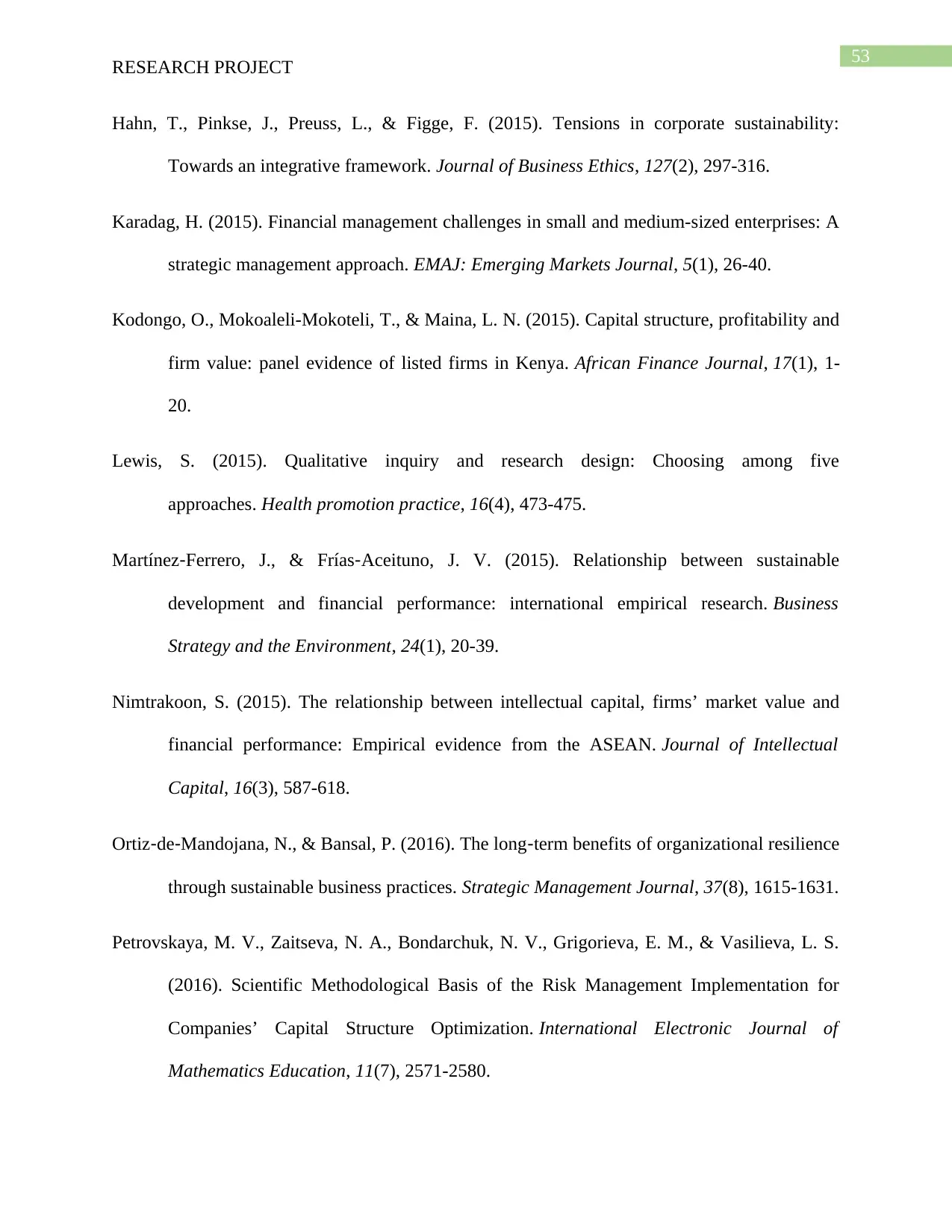
53
RESEARCH PROJECT
Hahn, T., Pinkse, J., Preuss, L., & Figge, F. (2015). Tensions in corporate sustainability:
Towards an integrative framework. Journal of Business Ethics, 127(2), 297-316.
Karadag, H. (2015). Financial management challenges in small and medium-sized enterprises: A
strategic management approach. EMAJ: Emerging Markets Journal, 5(1), 26-40.
Kodongo, O., Mokoaleli-Mokoteli, T., & Maina, L. N. (2015). Capital structure, profitability and
firm value: panel evidence of listed firms in Kenya. African Finance Journal, 17(1), 1-
20.
Lewis, S. (2015). Qualitative inquiry and research design: Choosing among five
approaches. Health promotion practice, 16(4), 473-475.
Martínez‐Ferrero, J., & Frías‐Aceituno, J. V. (2015). Relationship between sustainable
development and financial performance: international empirical research. Business
Strategy and the Environment, 24(1), 20-39.
Nimtrakoon, S. (2015). The relationship between intellectual capital, firms’ market value and
financial performance: Empirical evidence from the ASEAN. Journal of Intellectual
Capital, 16(3), 587-618.
Ortiz‐de‐Mandojana, N., & Bansal, P. (2016). The long‐term benefits of organizational resilience
through sustainable business practices. Strategic Management Journal, 37(8), 1615-1631.
Petrovskaya, M. V., Zaitseva, N. A., Bondarchuk, N. V., Grigorieva, E. M., & Vasilieva, L. S.
(2016). Scientific Methodological Basis of the Risk Management Implementation for
Companies’ Capital Structure Optimization. International Electronic Journal of
Mathematics Education, 11(7), 2571-2580.
RESEARCH PROJECT
Hahn, T., Pinkse, J., Preuss, L., & Figge, F. (2015). Tensions in corporate sustainability:
Towards an integrative framework. Journal of Business Ethics, 127(2), 297-316.
Karadag, H. (2015). Financial management challenges in small and medium-sized enterprises: A
strategic management approach. EMAJ: Emerging Markets Journal, 5(1), 26-40.
Kodongo, O., Mokoaleli-Mokoteli, T., & Maina, L. N. (2015). Capital structure, profitability and
firm value: panel evidence of listed firms in Kenya. African Finance Journal, 17(1), 1-
20.
Lewis, S. (2015). Qualitative inquiry and research design: Choosing among five
approaches. Health promotion practice, 16(4), 473-475.
Martínez‐Ferrero, J., & Frías‐Aceituno, J. V. (2015). Relationship between sustainable
development and financial performance: international empirical research. Business
Strategy and the Environment, 24(1), 20-39.
Nimtrakoon, S. (2015). The relationship between intellectual capital, firms’ market value and
financial performance: Empirical evidence from the ASEAN. Journal of Intellectual
Capital, 16(3), 587-618.
Ortiz‐de‐Mandojana, N., & Bansal, P. (2016). The long‐term benefits of organizational resilience
through sustainable business practices. Strategic Management Journal, 37(8), 1615-1631.
Petrovskaya, M. V., Zaitseva, N. A., Bondarchuk, N. V., Grigorieva, E. M., & Vasilieva, L. S.
(2016). Scientific Methodological Basis of the Risk Management Implementation for
Companies’ Capital Structure Optimization. International Electronic Journal of
Mathematics Education, 11(7), 2571-2580.
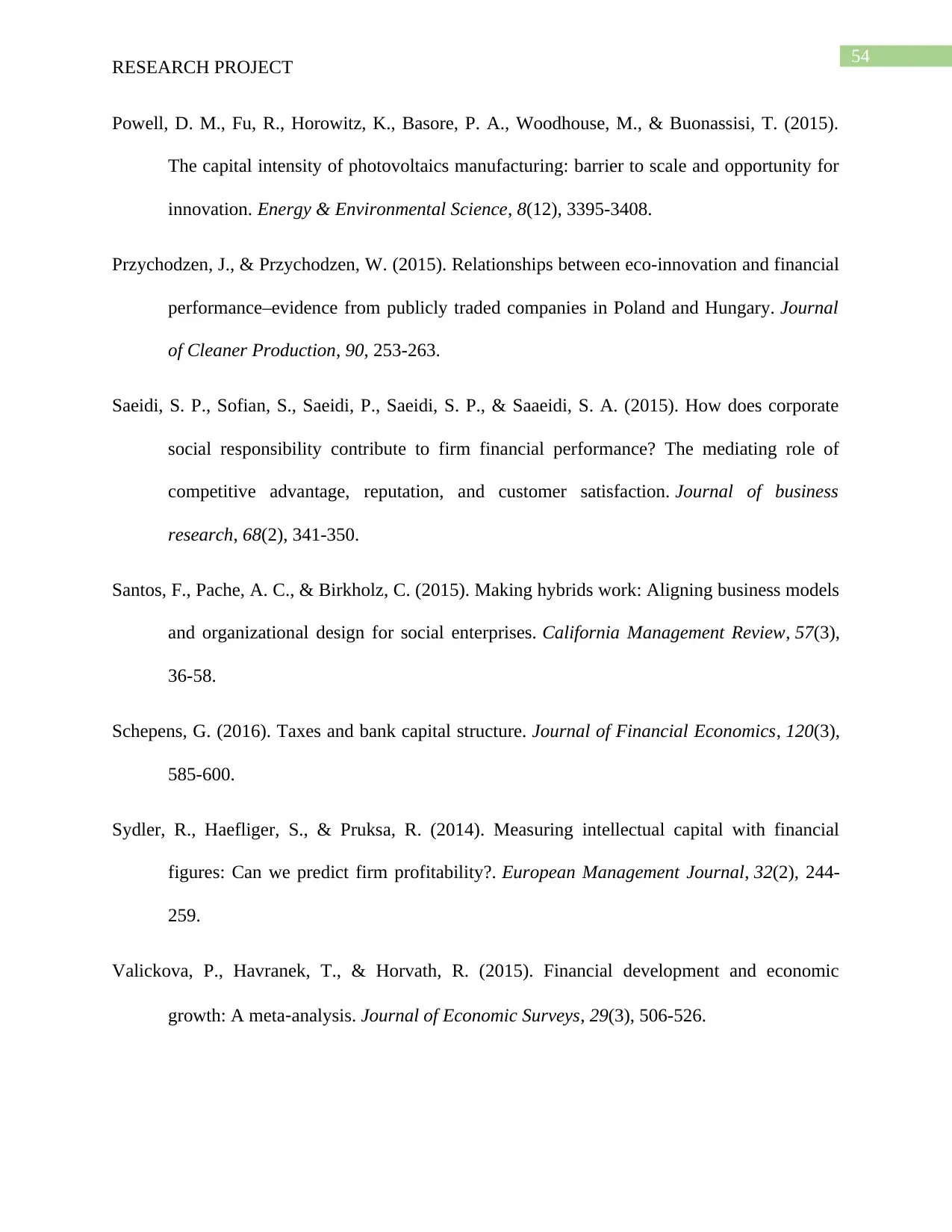
54
RESEARCH PROJECT
Powell, D. M., Fu, R., Horowitz, K., Basore, P. A., Woodhouse, M., & Buonassisi, T. (2015).
The capital intensity of photovoltaics manufacturing: barrier to scale and opportunity for
innovation. Energy & Environmental Science, 8(12), 3395-3408.
Przychodzen, J., & Przychodzen, W. (2015). Relationships between eco-innovation and financial
performance–evidence from publicly traded companies in Poland and Hungary. Journal
of Cleaner Production, 90, 253-263.
Saeidi, S. P., Sofian, S., Saeidi, P., Saeidi, S. P., & Saaeidi, S. A. (2015). How does corporate
social responsibility contribute to firm financial performance? The mediating role of
competitive advantage, reputation, and customer satisfaction. Journal of business
research, 68(2), 341-350.
Santos, F., Pache, A. C., & Birkholz, C. (2015). Making hybrids work: Aligning business models
and organizational design for social enterprises. California Management Review, 57(3),
36-58.
Schepens, G. (2016). Taxes and bank capital structure. Journal of Financial Economics, 120(3),
585-600.
Sydler, R., Haefliger, S., & Pruksa, R. (2014). Measuring intellectual capital with financial
figures: Can we predict firm profitability?. European Management Journal, 32(2), 244-
259.
Valickova, P., Havranek, T., & Horvath, R. (2015). Financial development and economic
growth: A meta‐analysis. Journal of Economic Surveys, 29(3), 506-526.
RESEARCH PROJECT
Powell, D. M., Fu, R., Horowitz, K., Basore, P. A., Woodhouse, M., & Buonassisi, T. (2015).
The capital intensity of photovoltaics manufacturing: barrier to scale and opportunity for
innovation. Energy & Environmental Science, 8(12), 3395-3408.
Przychodzen, J., & Przychodzen, W. (2015). Relationships between eco-innovation and financial
performance–evidence from publicly traded companies in Poland and Hungary. Journal
of Cleaner Production, 90, 253-263.
Saeidi, S. P., Sofian, S., Saeidi, P., Saeidi, S. P., & Saaeidi, S. A. (2015). How does corporate
social responsibility contribute to firm financial performance? The mediating role of
competitive advantage, reputation, and customer satisfaction. Journal of business
research, 68(2), 341-350.
Santos, F., Pache, A. C., & Birkholz, C. (2015). Making hybrids work: Aligning business models
and organizational design for social enterprises. California Management Review, 57(3),
36-58.
Schepens, G. (2016). Taxes and bank capital structure. Journal of Financial Economics, 120(3),
585-600.
Sydler, R., Haefliger, S., & Pruksa, R. (2014). Measuring intellectual capital with financial
figures: Can we predict firm profitability?. European Management Journal, 32(2), 244-
259.
Valickova, P., Havranek, T., & Horvath, R. (2015). Financial development and economic
growth: A meta‐analysis. Journal of Economic Surveys, 29(3), 506-526.
Paraphrase This Document
Need a fresh take? Get an instant paraphrase of this document with our AI Paraphraser
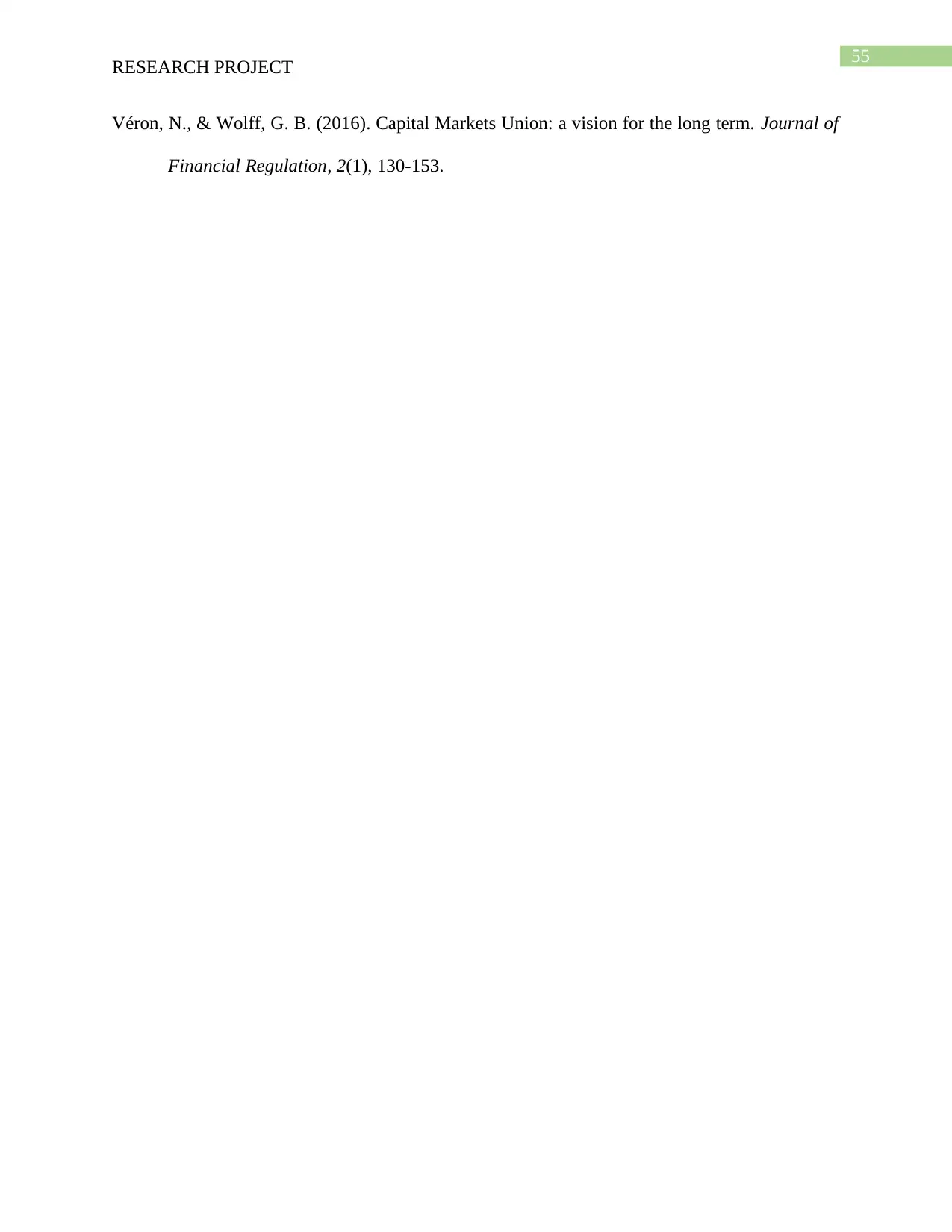
55
RESEARCH PROJECT
Véron, N., & Wolff, G. B. (2016). Capital Markets Union: a vision for the long term. Journal of
Financial Regulation, 2(1), 130-153.
RESEARCH PROJECT
Véron, N., & Wolff, G. B. (2016). Capital Markets Union: a vision for the long term. Journal of
Financial Regulation, 2(1), 130-153.

56
RESEARCH PROJECT
Appendix
Questionnaire
Q1. Gender
Male
Female
Q2. Age Group
18-25 years
26-35 years
36-45 years
46-55 years
56 years and above
Q3. Capital structure of a company is dependent on the management policies of a company
Strongly Disagree
Disagree
Neutral
Agree
Strongly Agree
Q4. Capital structure is dependent on the debt policies and the equity policies of a company
Strongly Disagree
Disagree
Neutral
RESEARCH PROJECT
Appendix
Questionnaire
Q1. Gender
Male
Female
Q2. Age Group
18-25 years
26-35 years
36-45 years
46-55 years
56 years and above
Q3. Capital structure of a company is dependent on the management policies of a company
Strongly Disagree
Disagree
Neutral
Agree
Strongly Agree
Q4. Capital structure is dependent on the debt policies and the equity policies of a company
Strongly Disagree
Disagree
Neutral
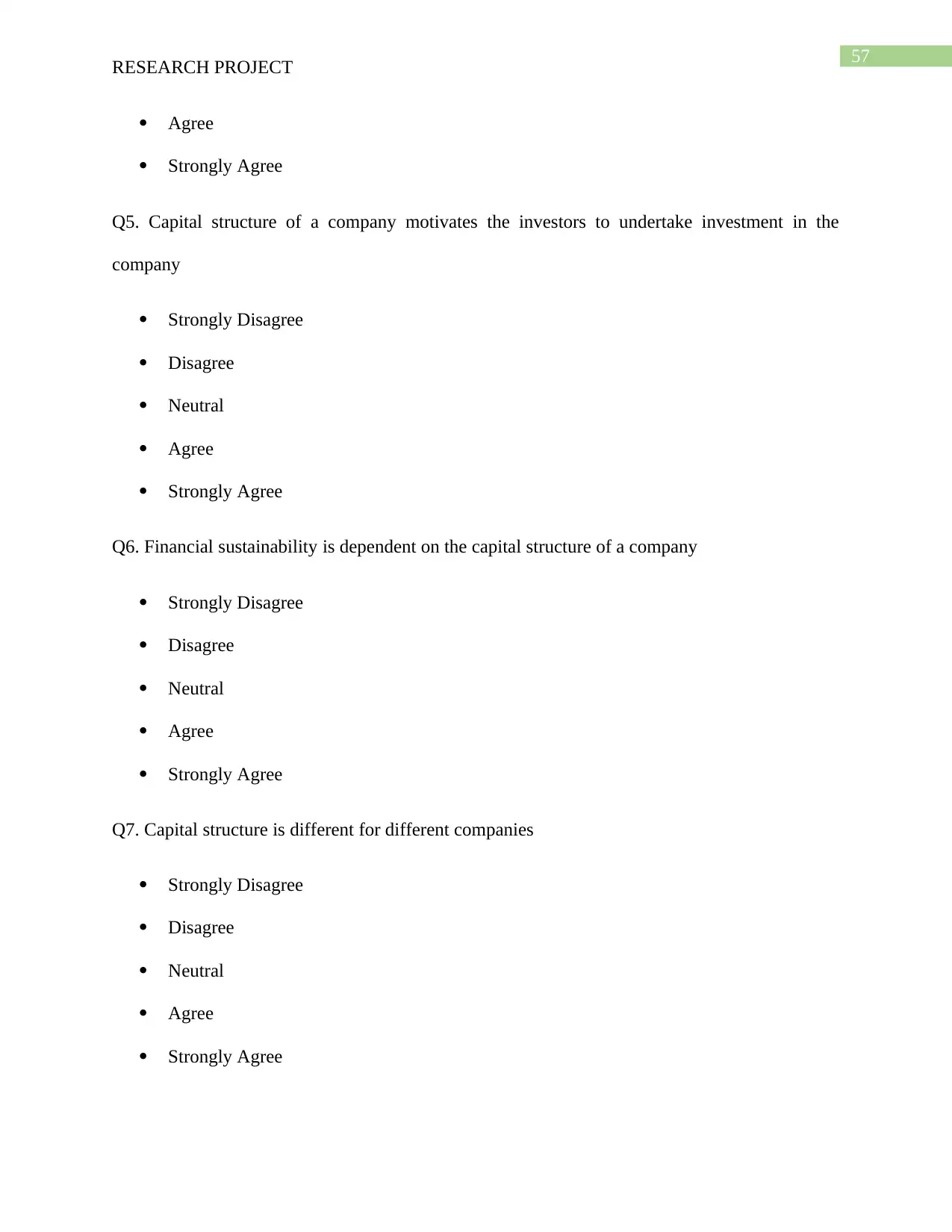
57
RESEARCH PROJECT
Agree
Strongly Agree
Q5. Capital structure of a company motivates the investors to undertake investment in the
company
Strongly Disagree
Disagree
Neutral
Agree
Strongly Agree
Q6. Financial sustainability is dependent on the capital structure of a company
Strongly Disagree
Disagree
Neutral
Agree
Strongly Agree
Q7. Capital structure is different for different companies
Strongly Disagree
Disagree
Neutral
Agree
Strongly Agree
RESEARCH PROJECT
Agree
Strongly Agree
Q5. Capital structure of a company motivates the investors to undertake investment in the
company
Strongly Disagree
Disagree
Neutral
Agree
Strongly Agree
Q6. Financial sustainability is dependent on the capital structure of a company
Strongly Disagree
Disagree
Neutral
Agree
Strongly Agree
Q7. Capital structure is different for different companies
Strongly Disagree
Disagree
Neutral
Agree
Strongly Agree
Secure Best Marks with AI Grader
Need help grading? Try our AI Grader for instant feedback on your assignments.

58
RESEARCH PROJECT
Q8. The management decisions related to the construction of the capital structure determines the
extent of financial sustainability of a company
Strongly Disagree
Disagree
Neutral
Agree
Strongly Agree
Q9. Financial sustainability enhances the profitability of the companies
Strongly Disagree
Disagree
Neutral
Agree
Strongly Agree
RESEARCH PROJECT
Q8. The management decisions related to the construction of the capital structure determines the
extent of financial sustainability of a company
Strongly Disagree
Disagree
Neutral
Agree
Strongly Agree
Q9. Financial sustainability enhances the profitability of the companies
Strongly Disagree
Disagree
Neutral
Agree
Strongly Agree

59
RESEARCH PROJECT
RESEARCH PROJECT
1 out of 60
Related Documents
Your All-in-One AI-Powered Toolkit for Academic Success.
+13062052269
info@desklib.com
Available 24*7 on WhatsApp / Email
![[object Object]](/_next/static/media/star-bottom.7253800d.svg)
Unlock your academic potential
© 2024 | Zucol Services PVT LTD | All rights reserved.





